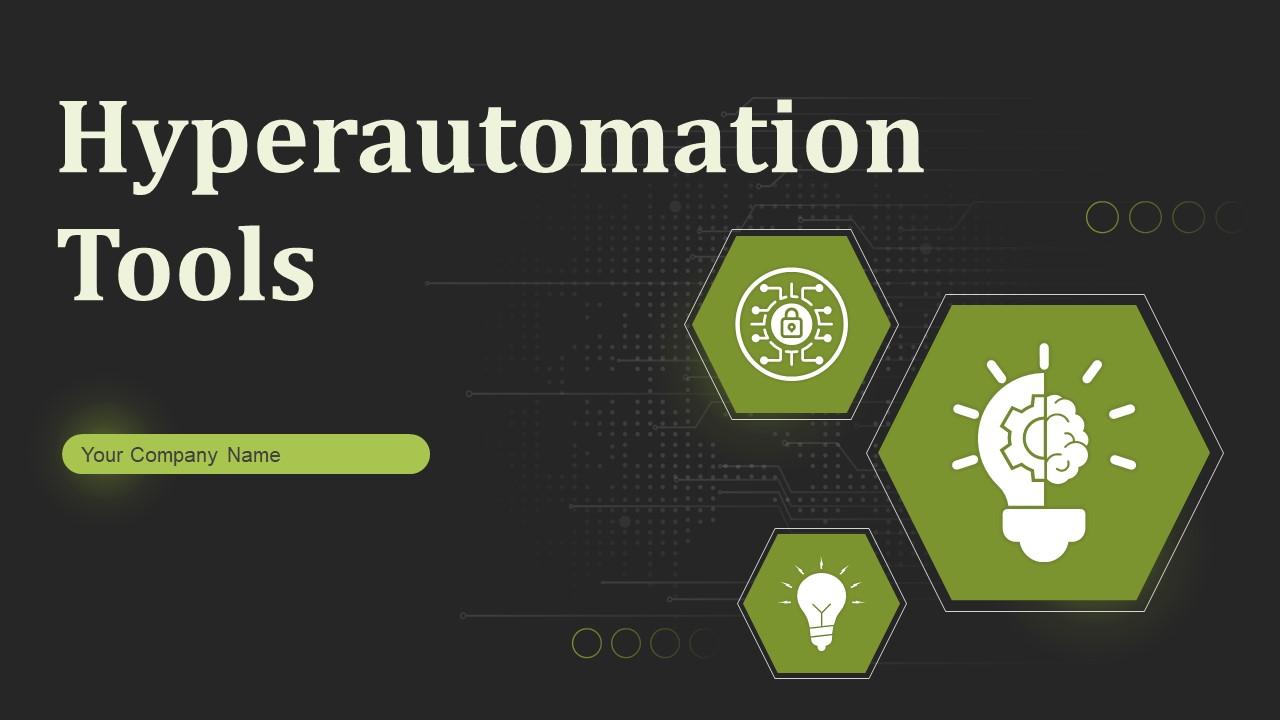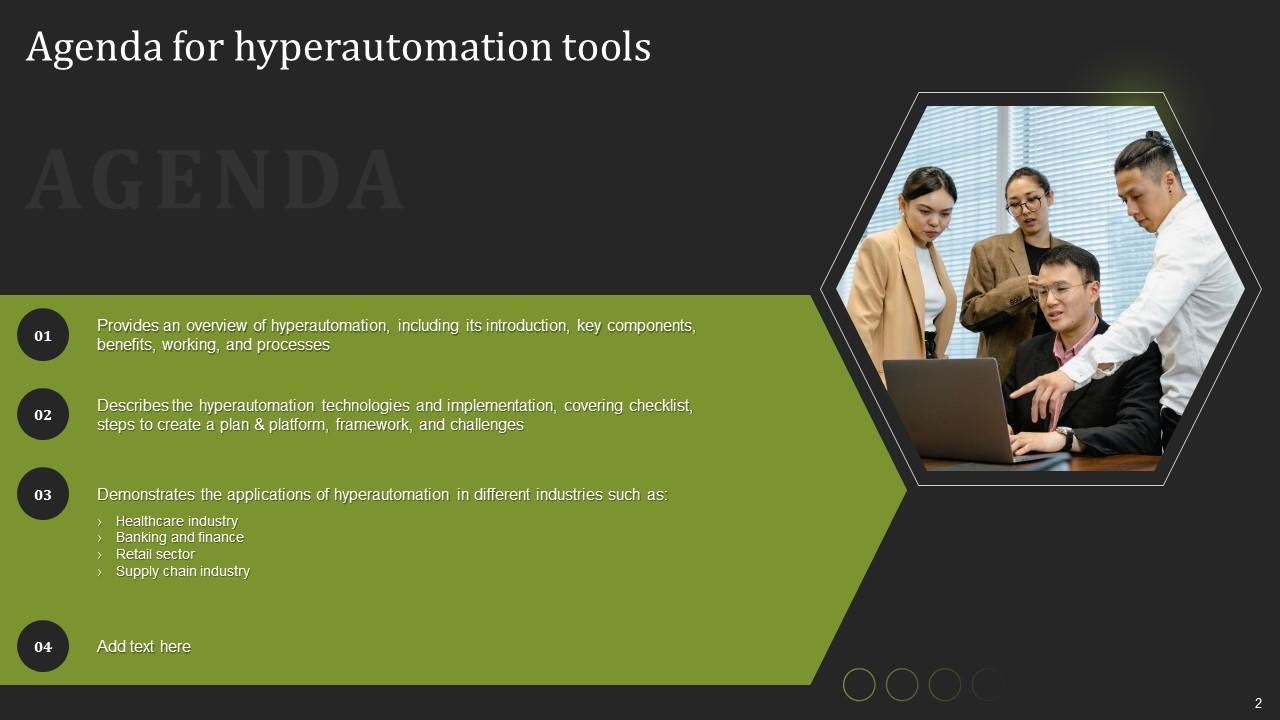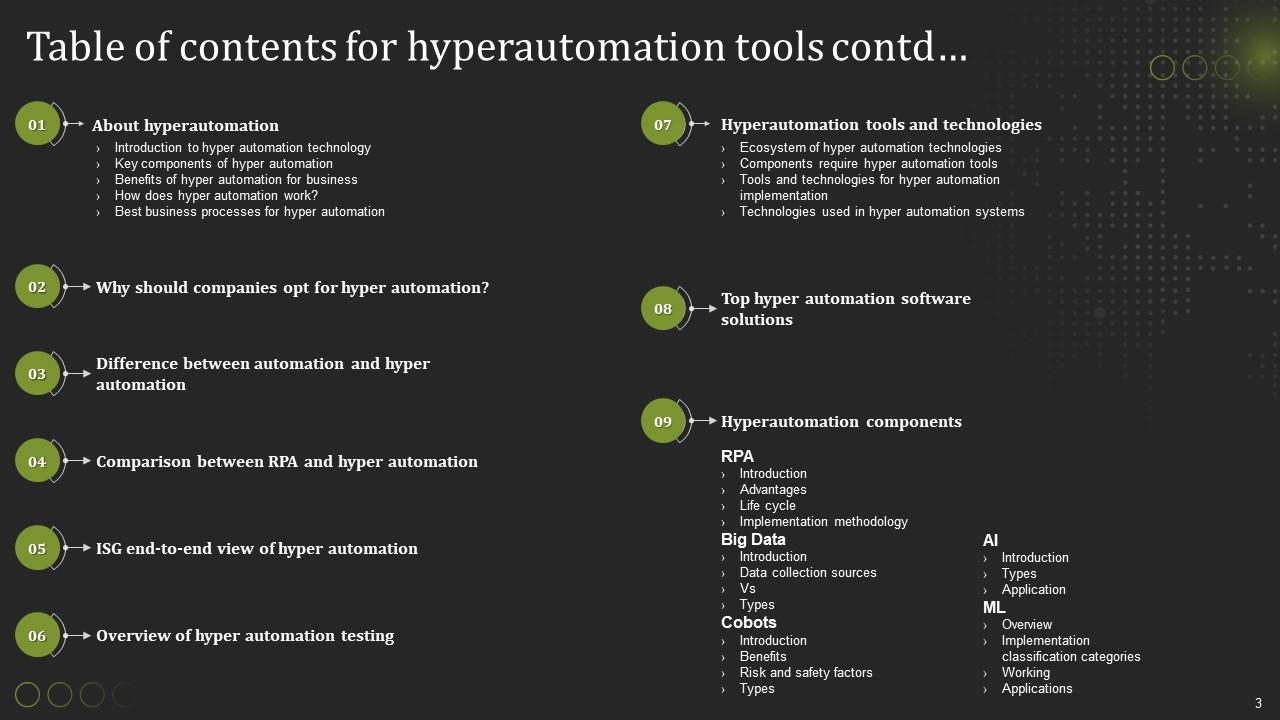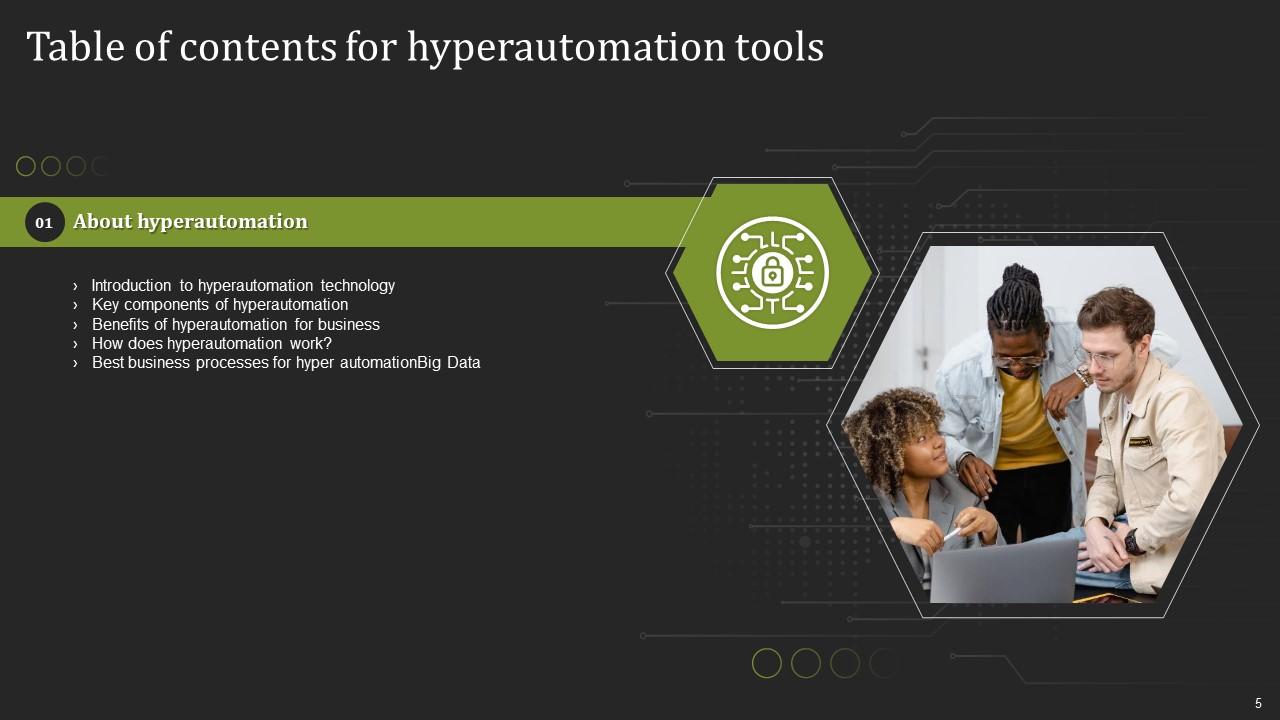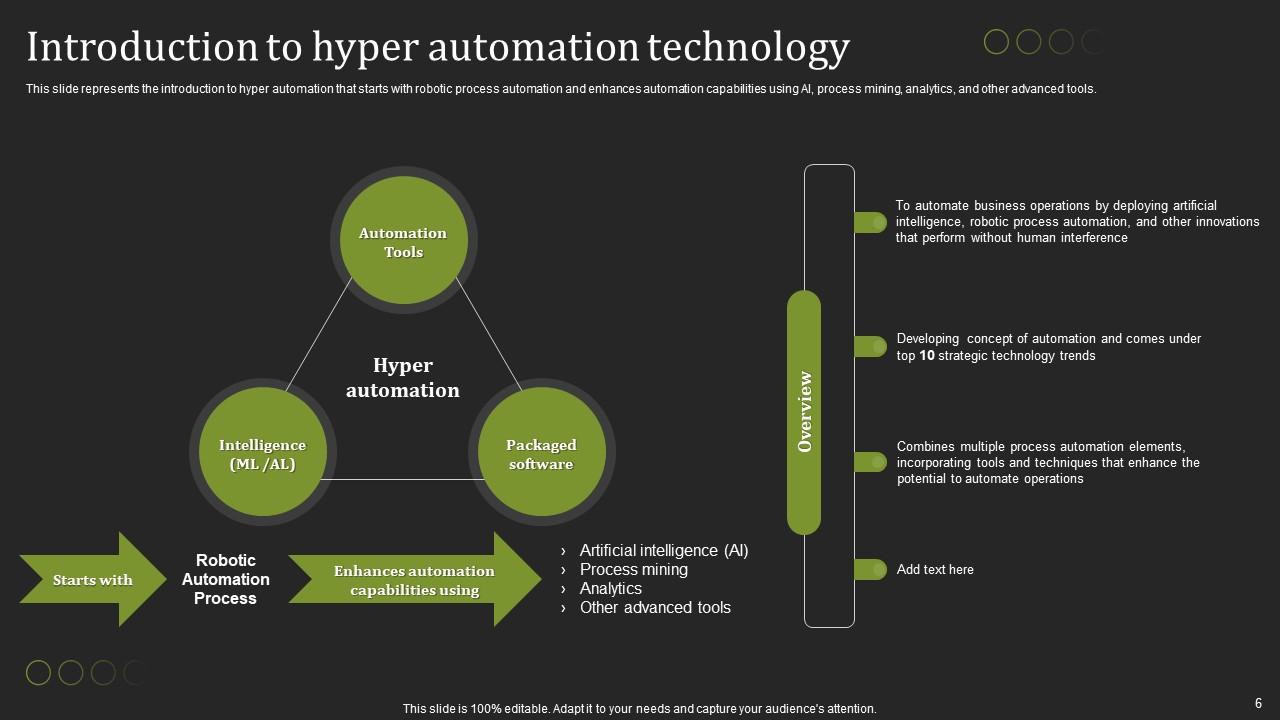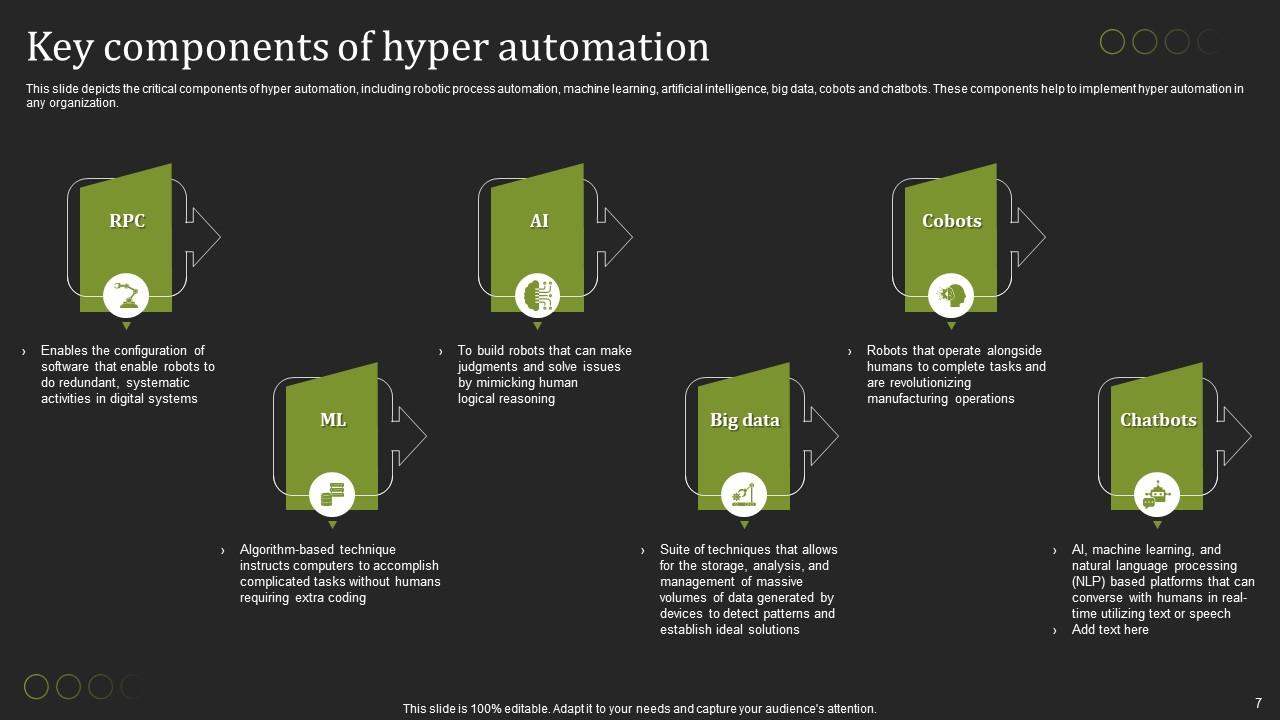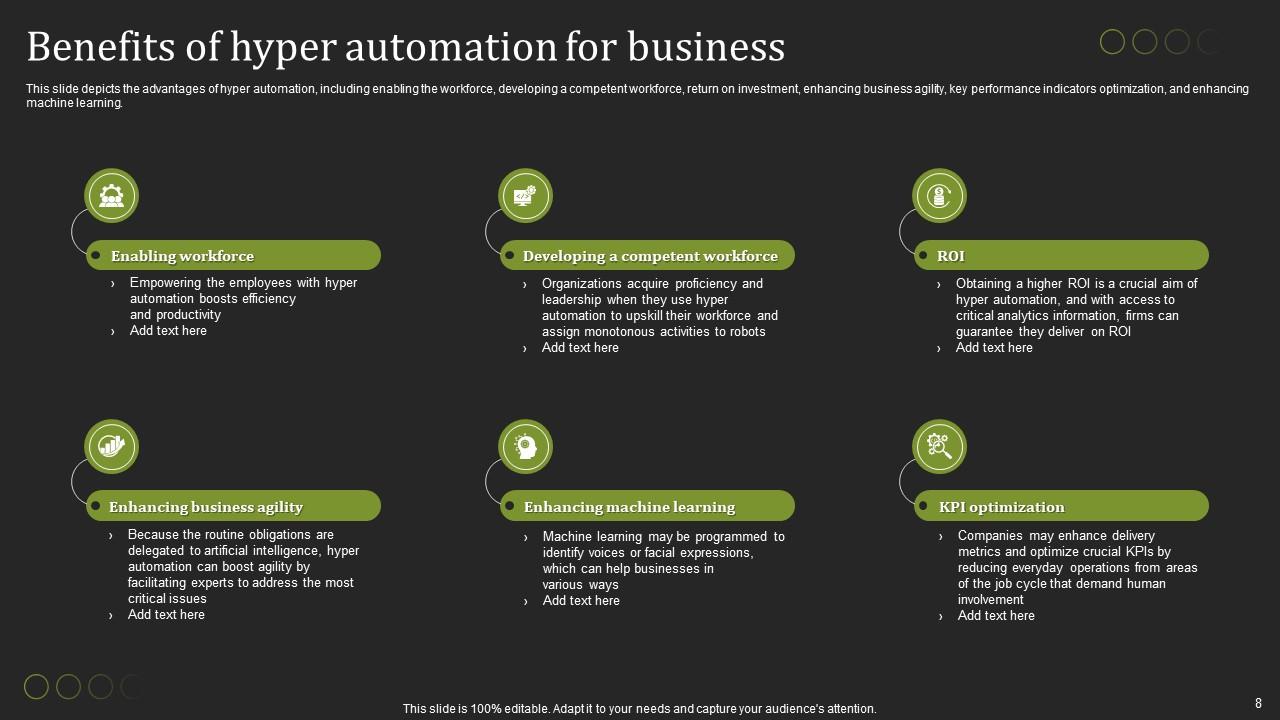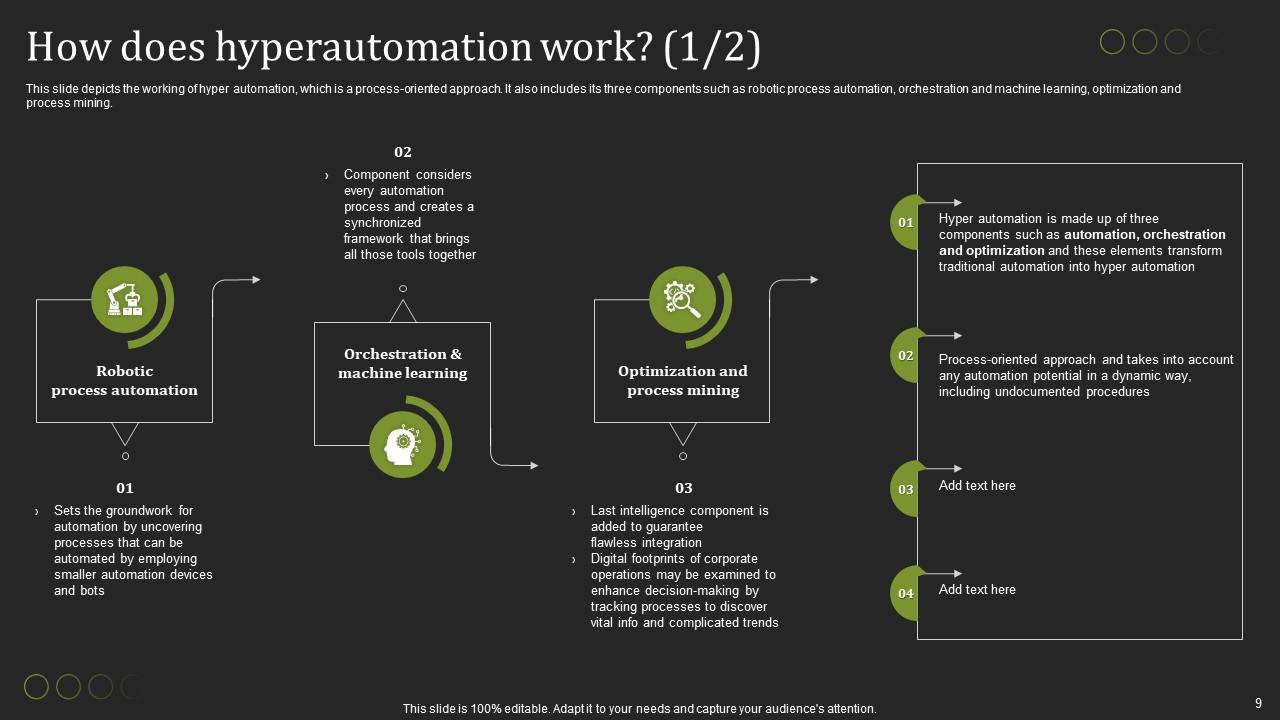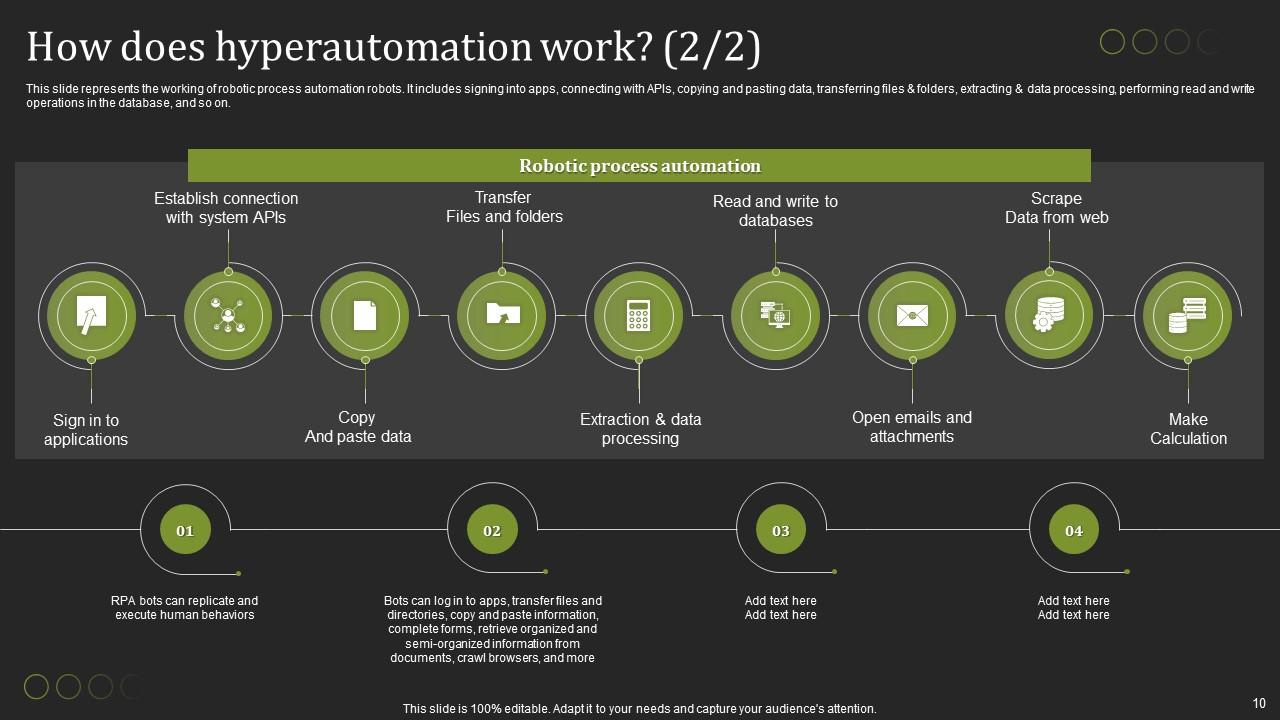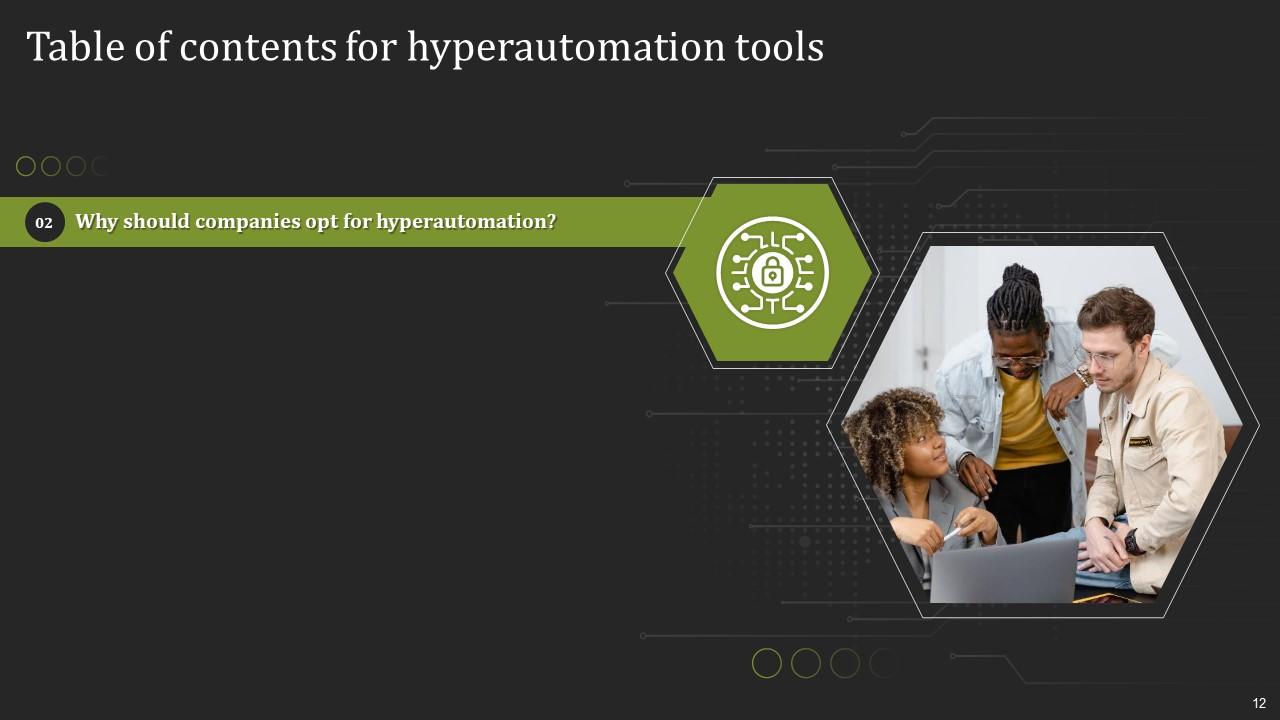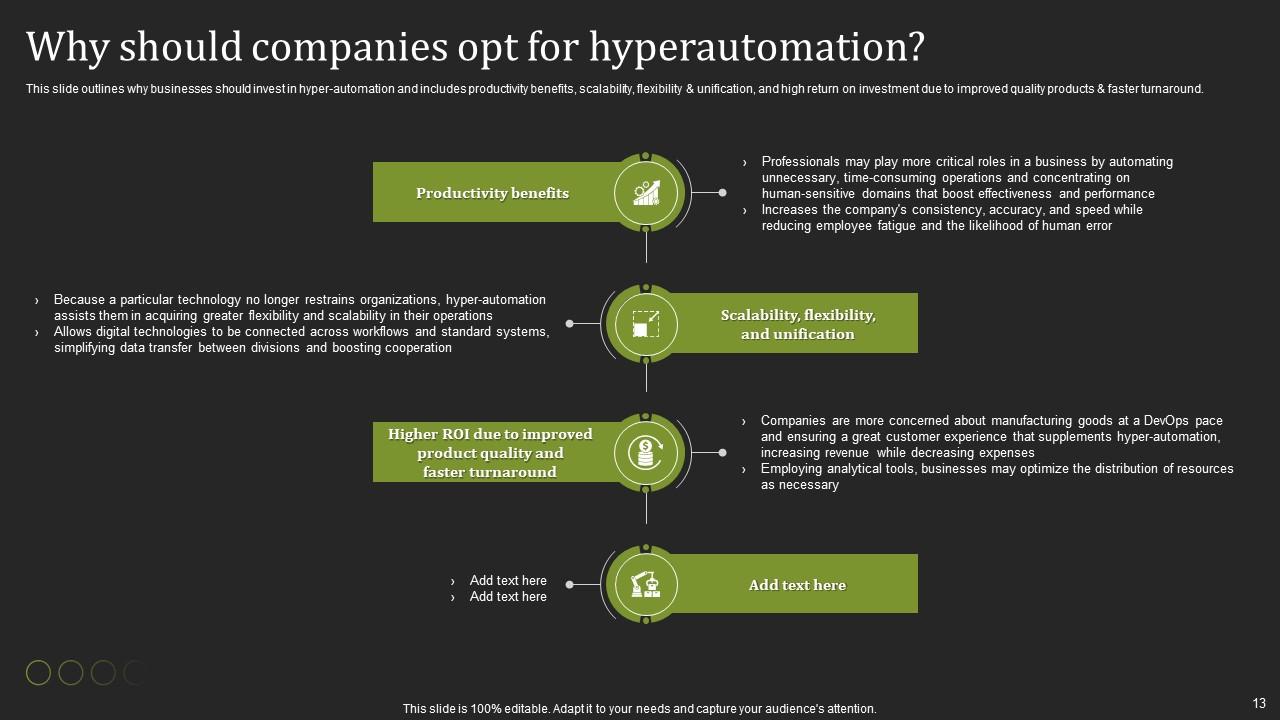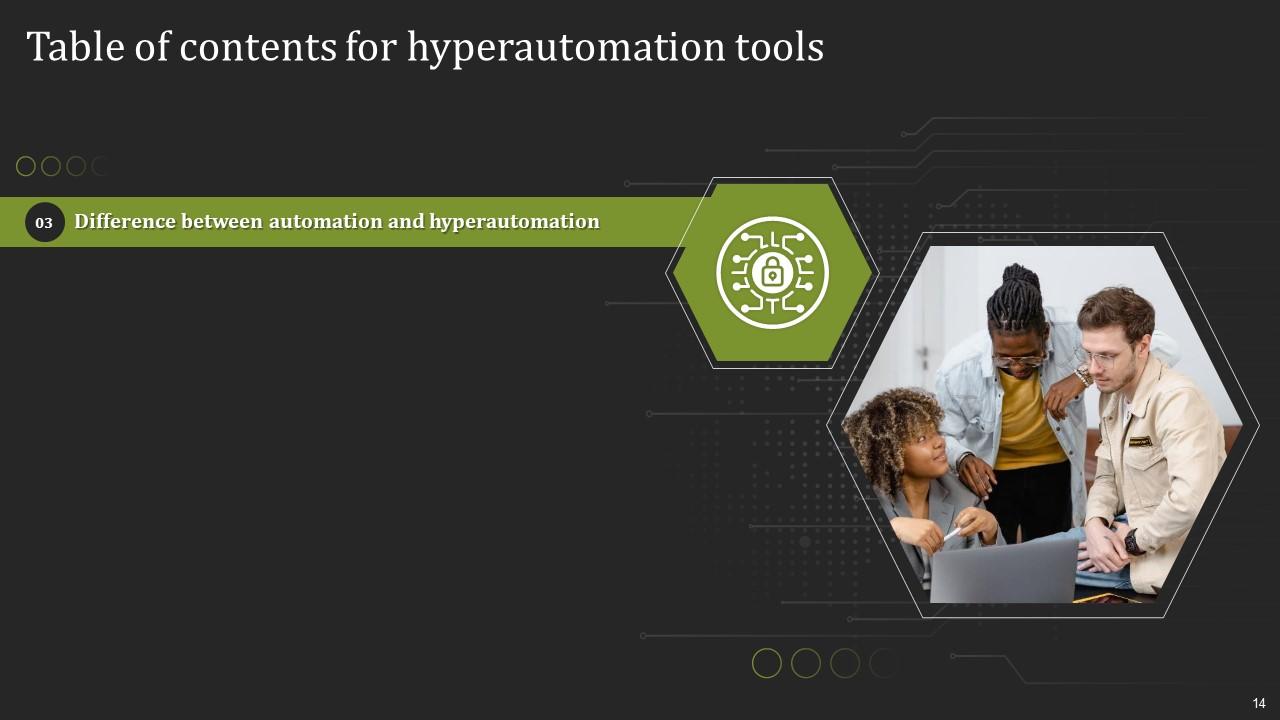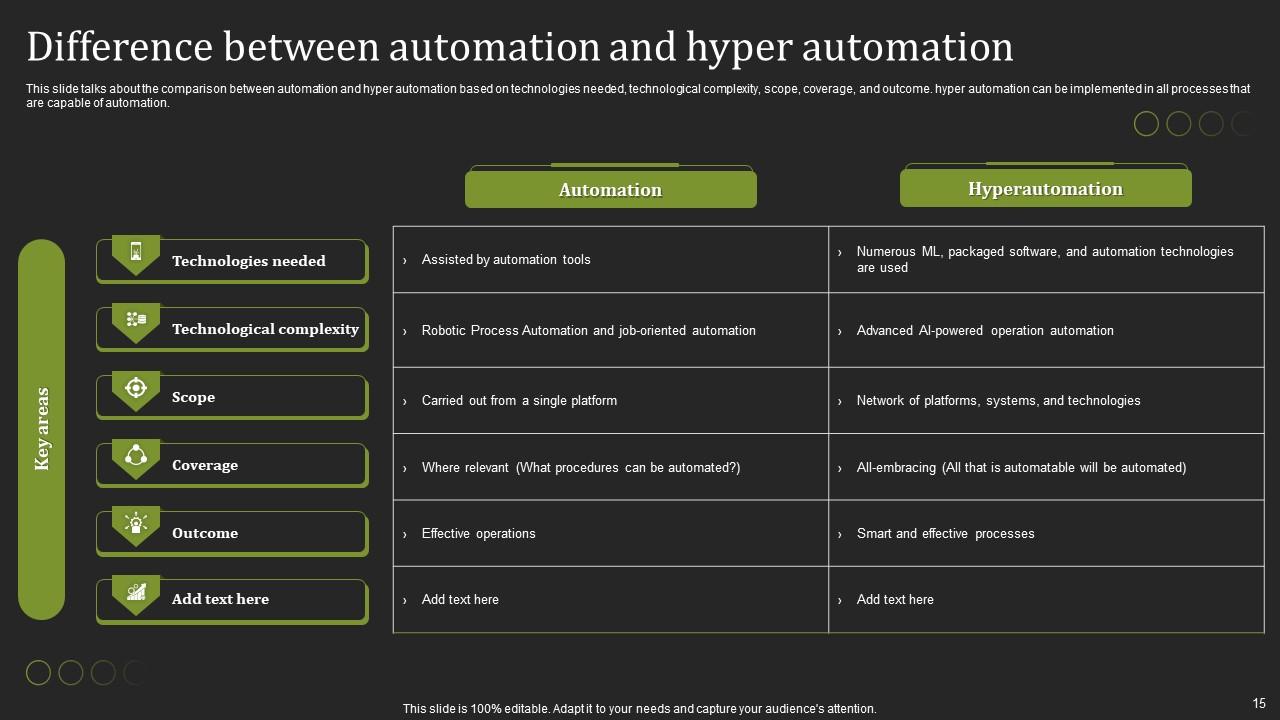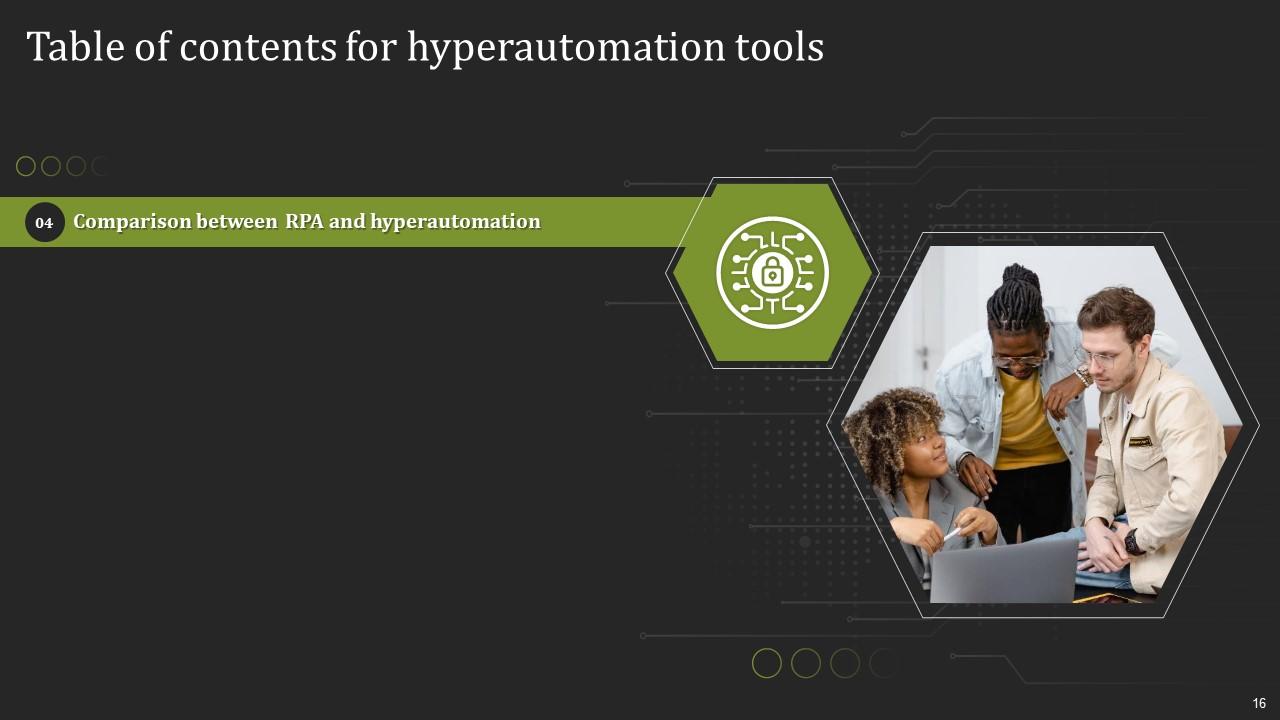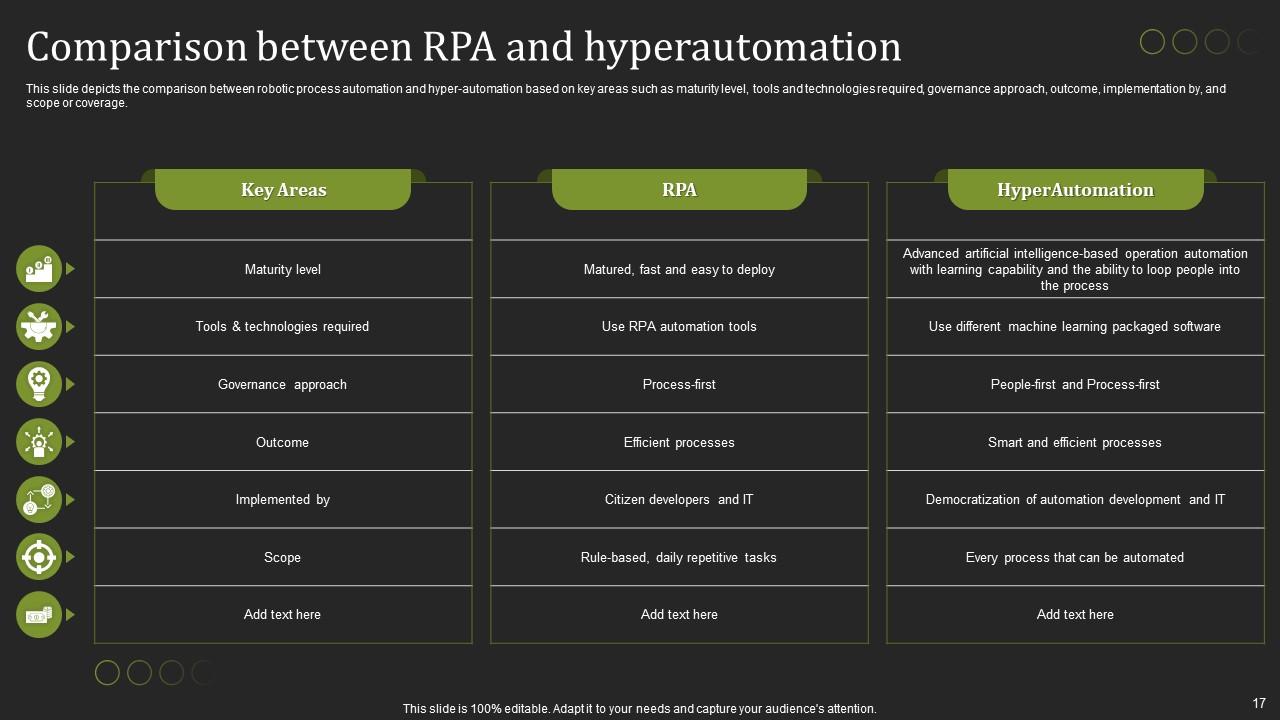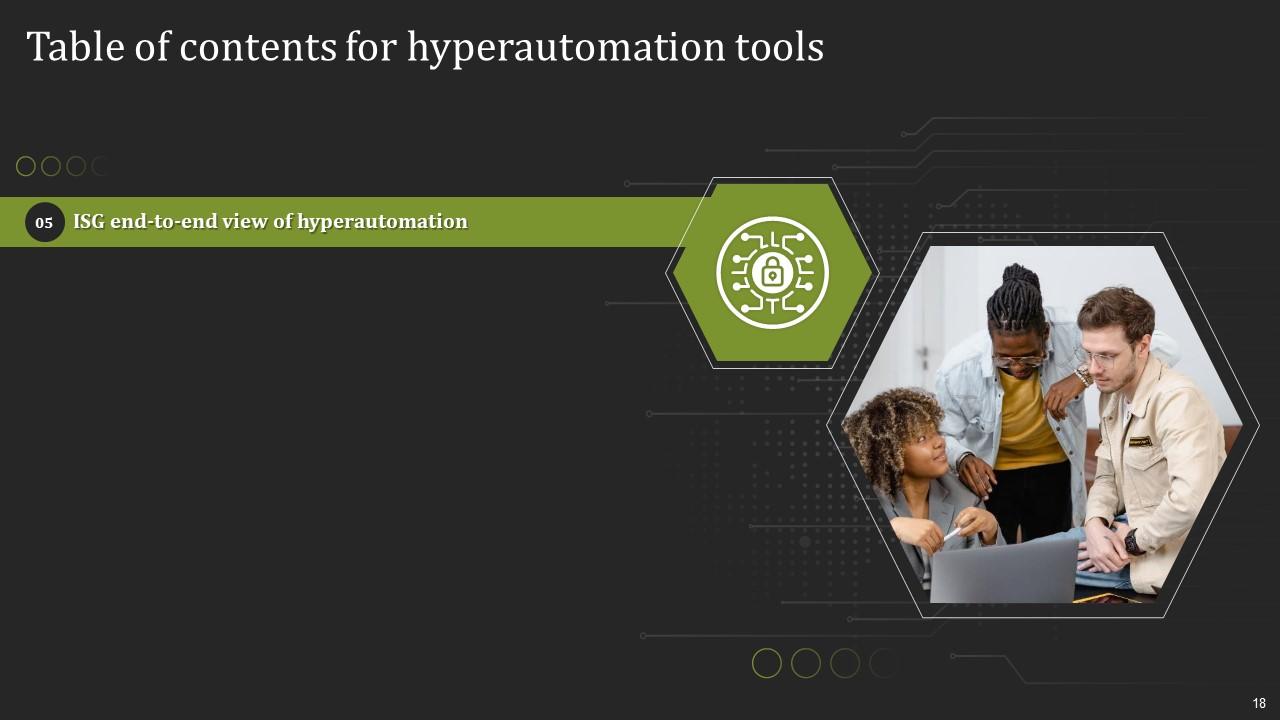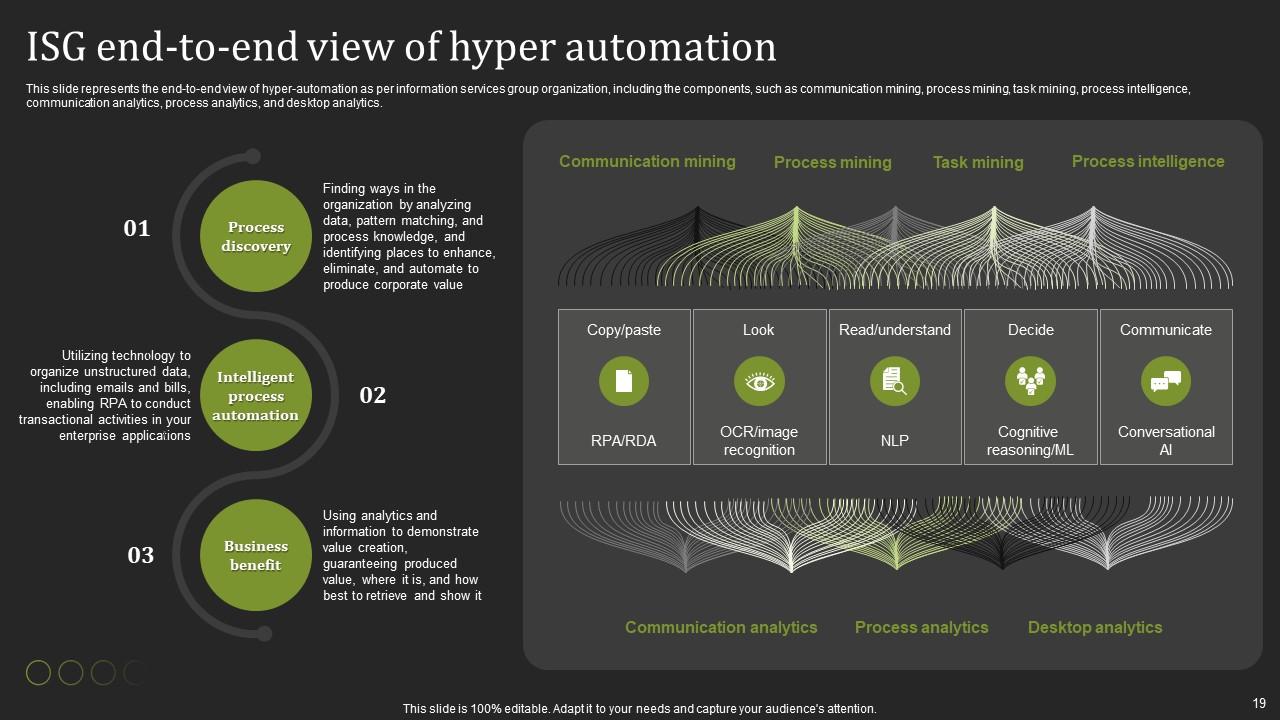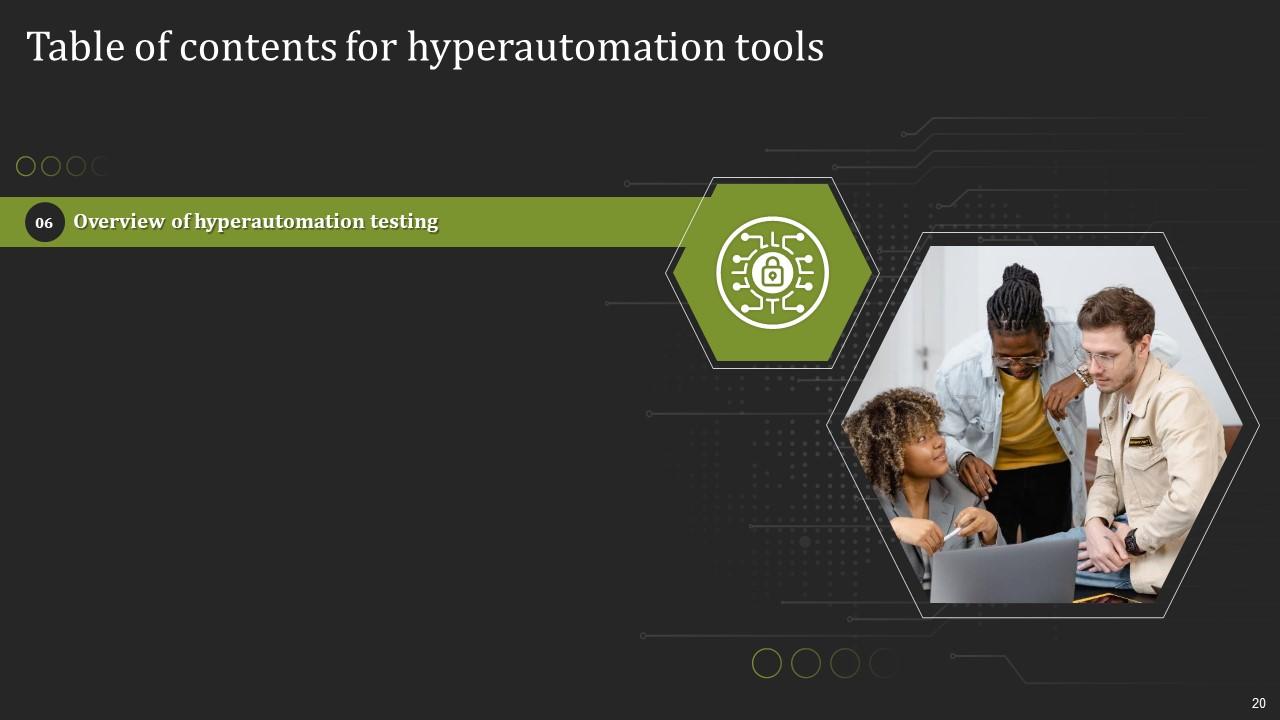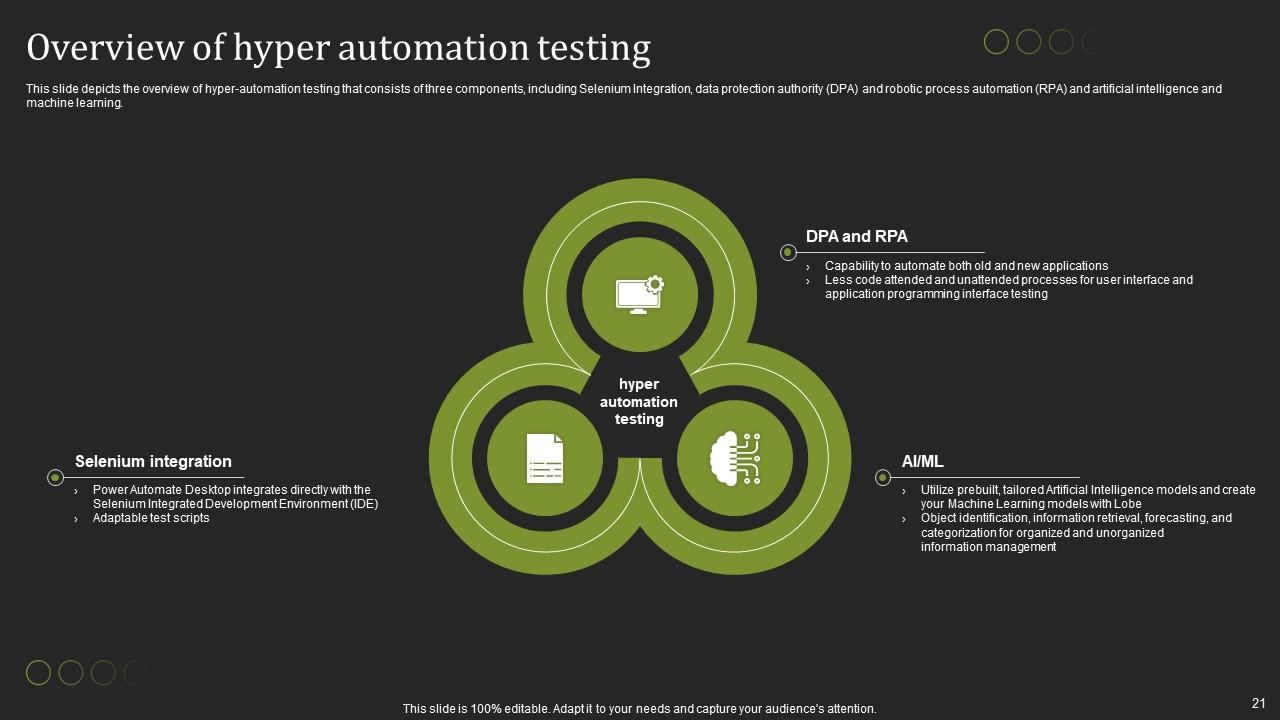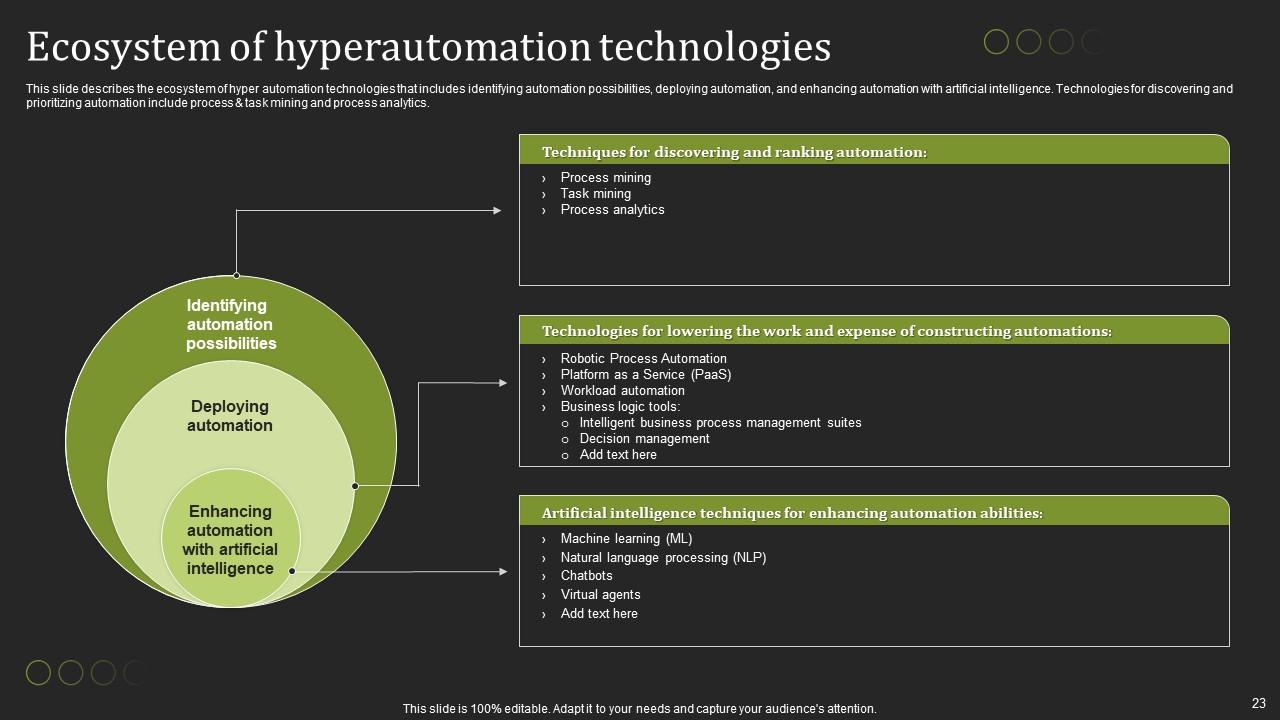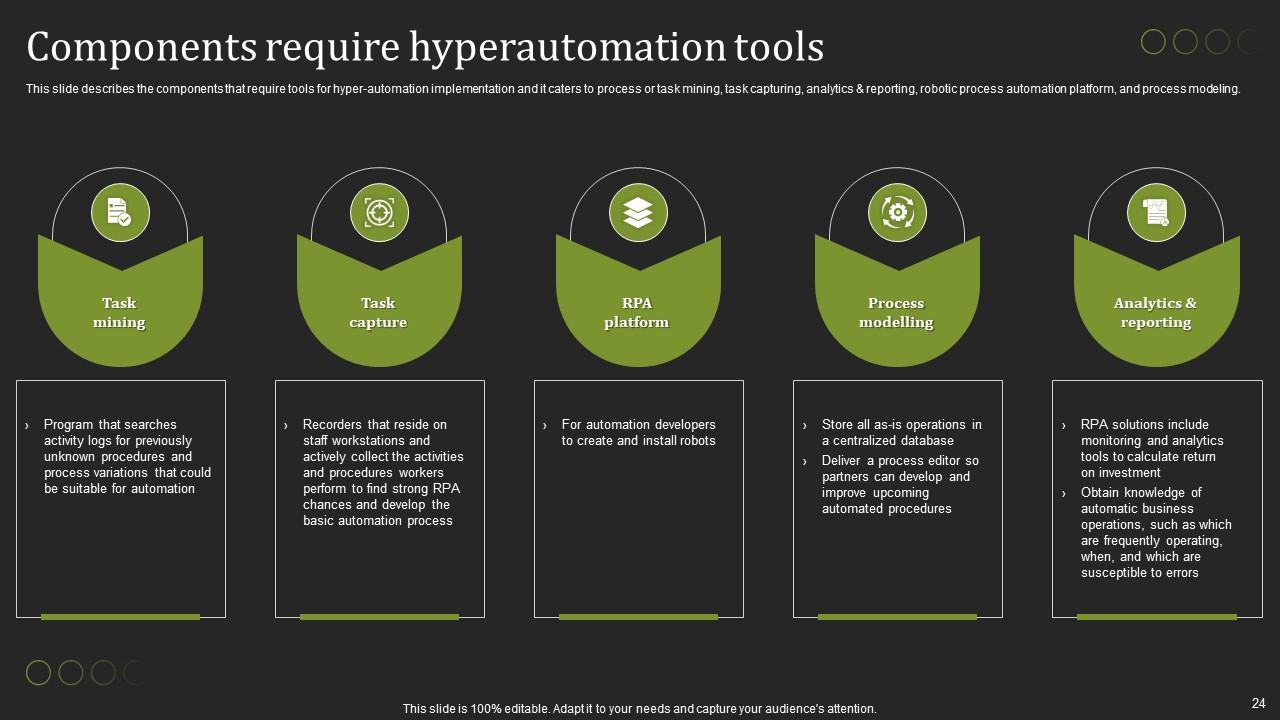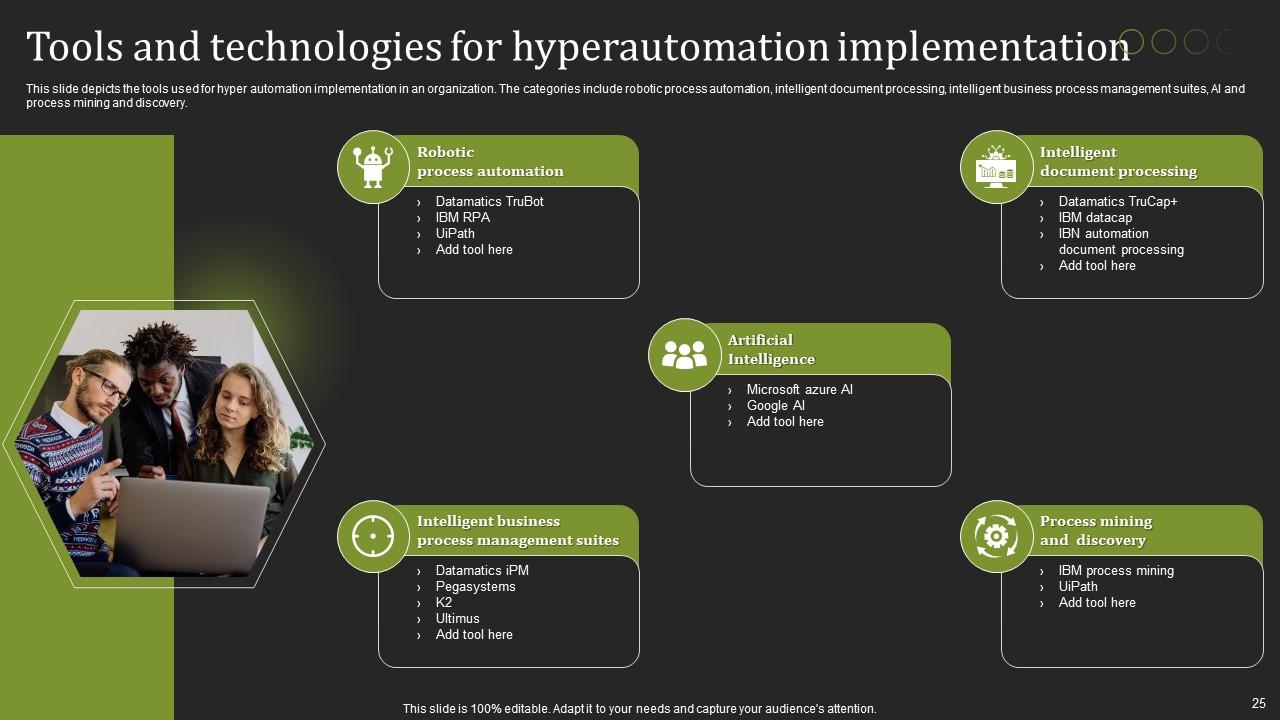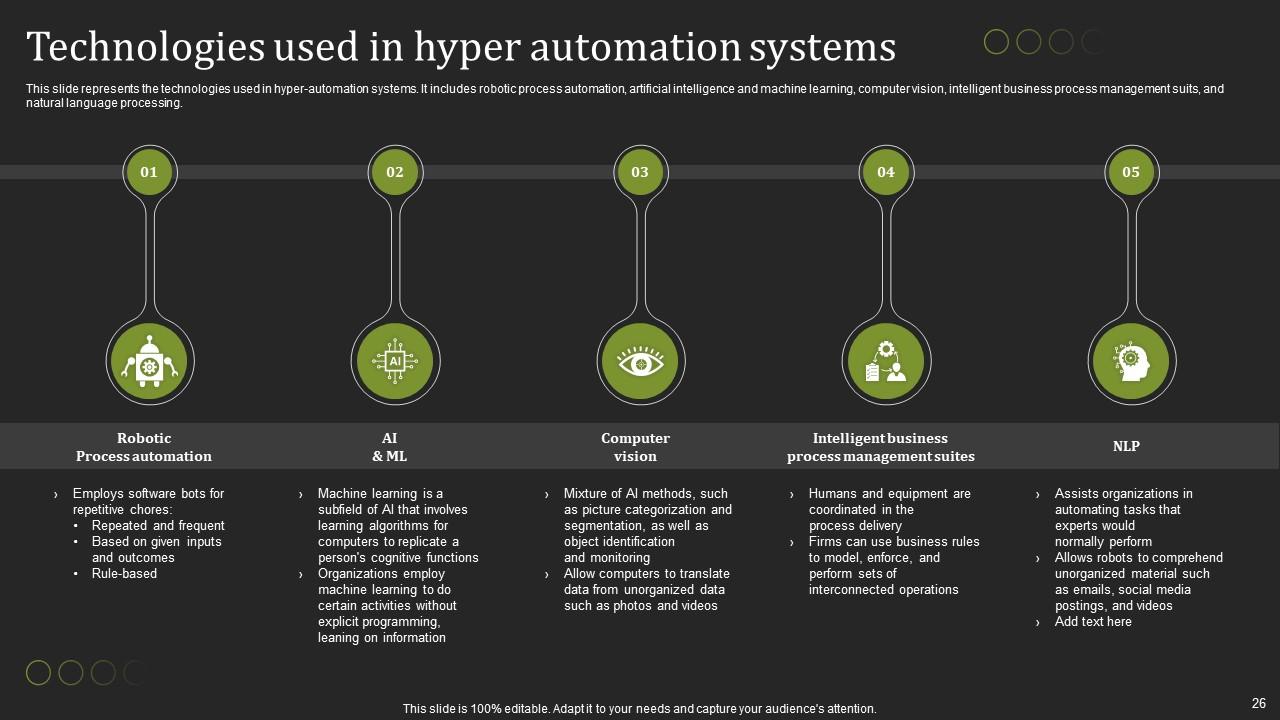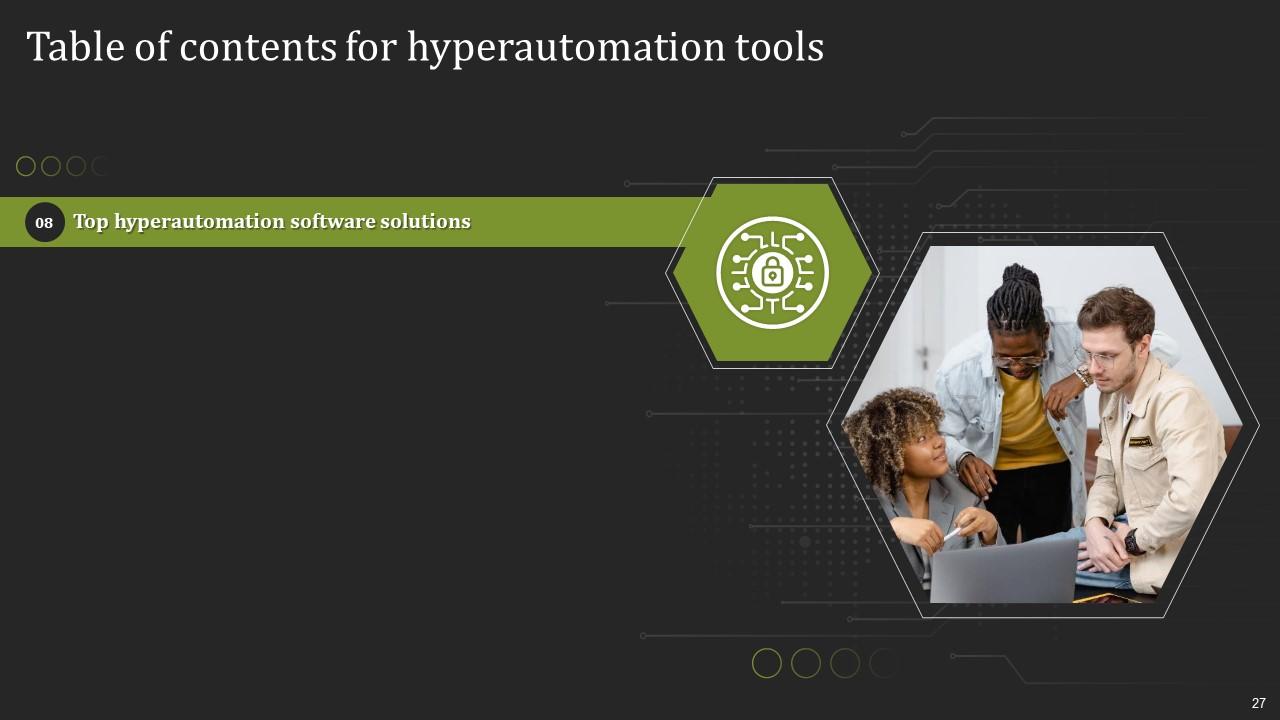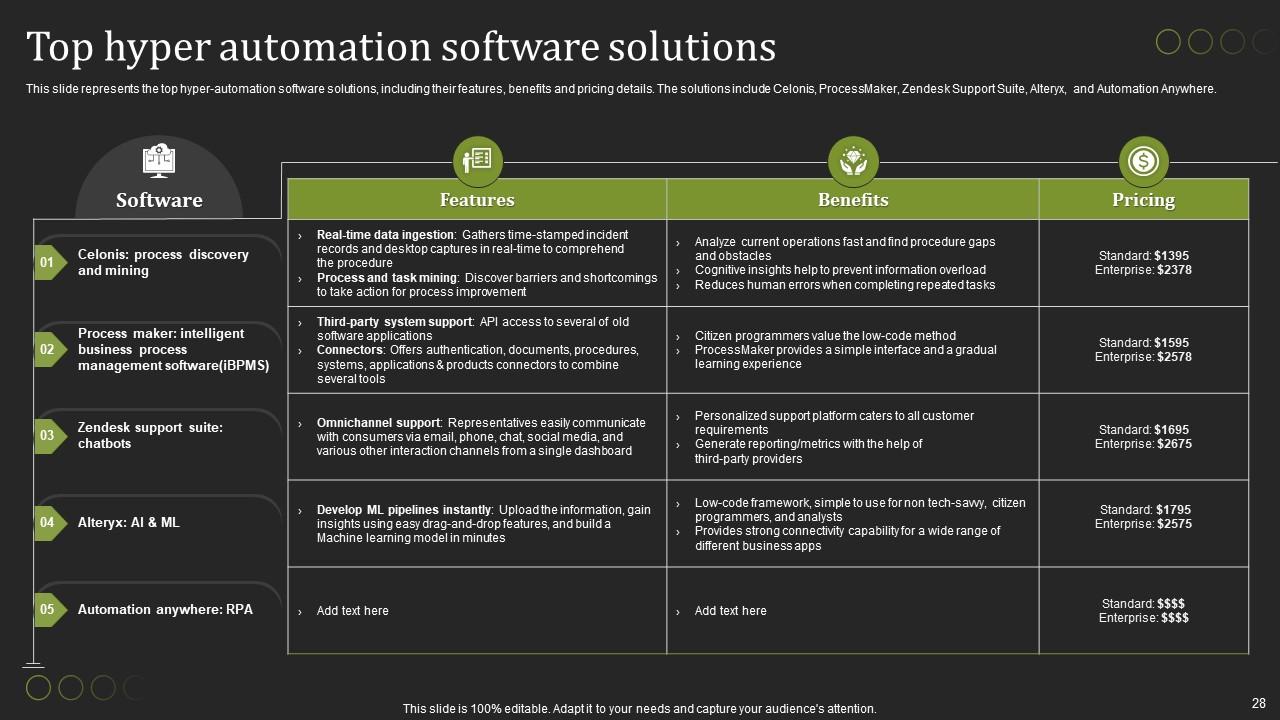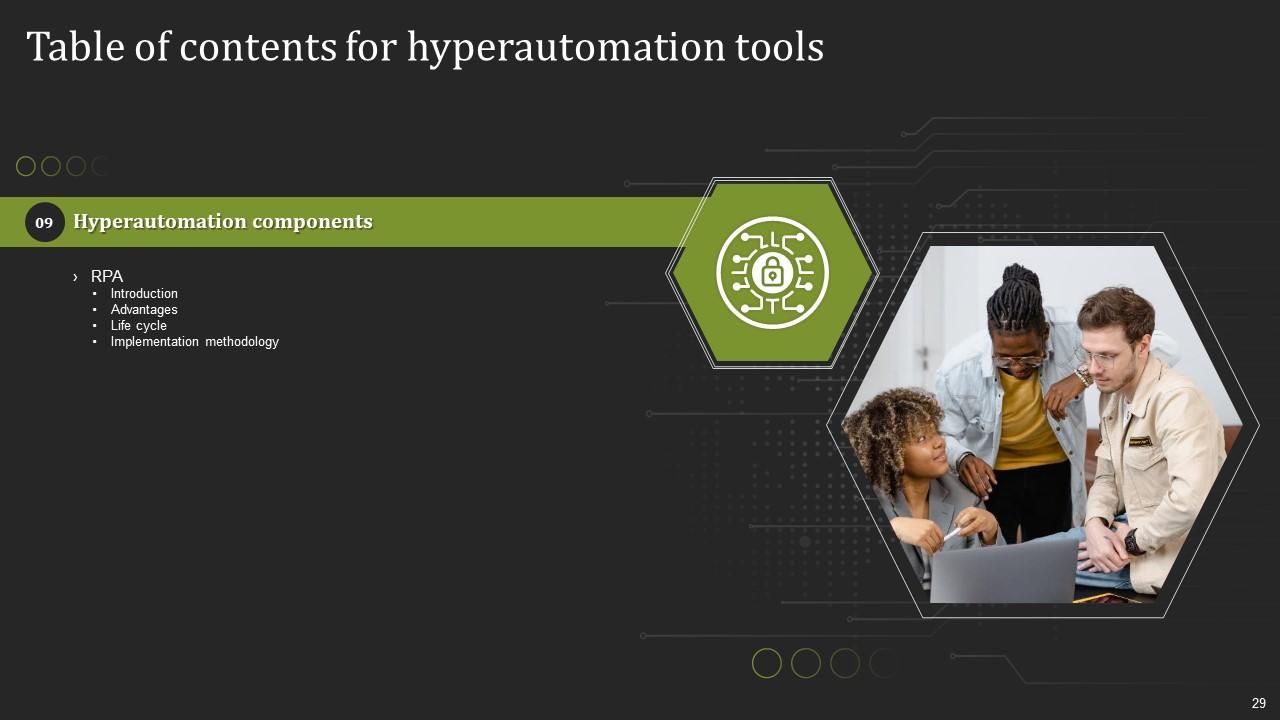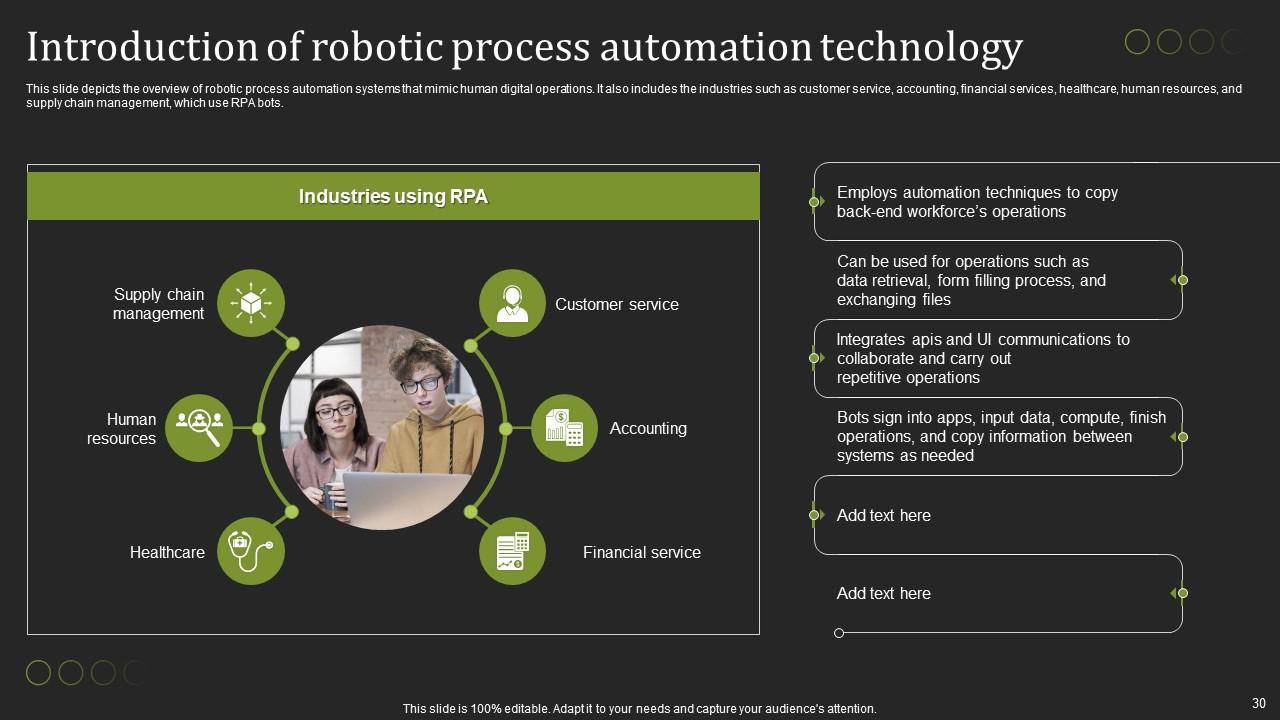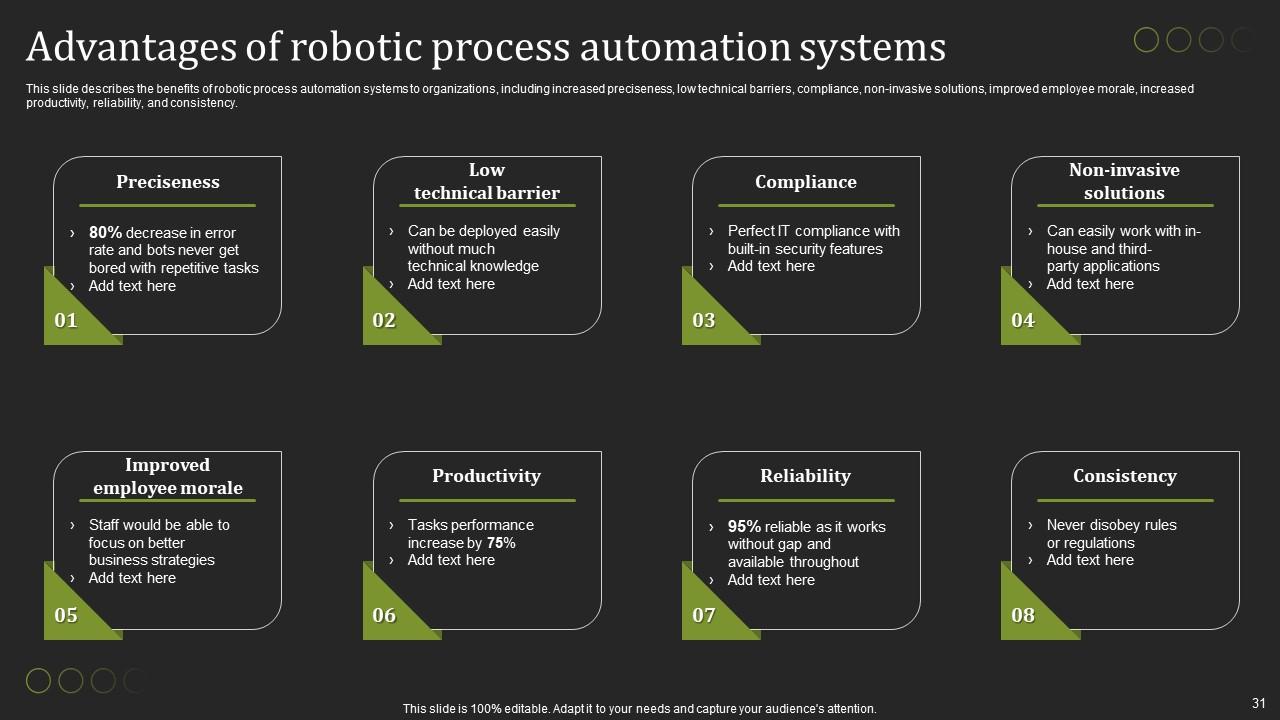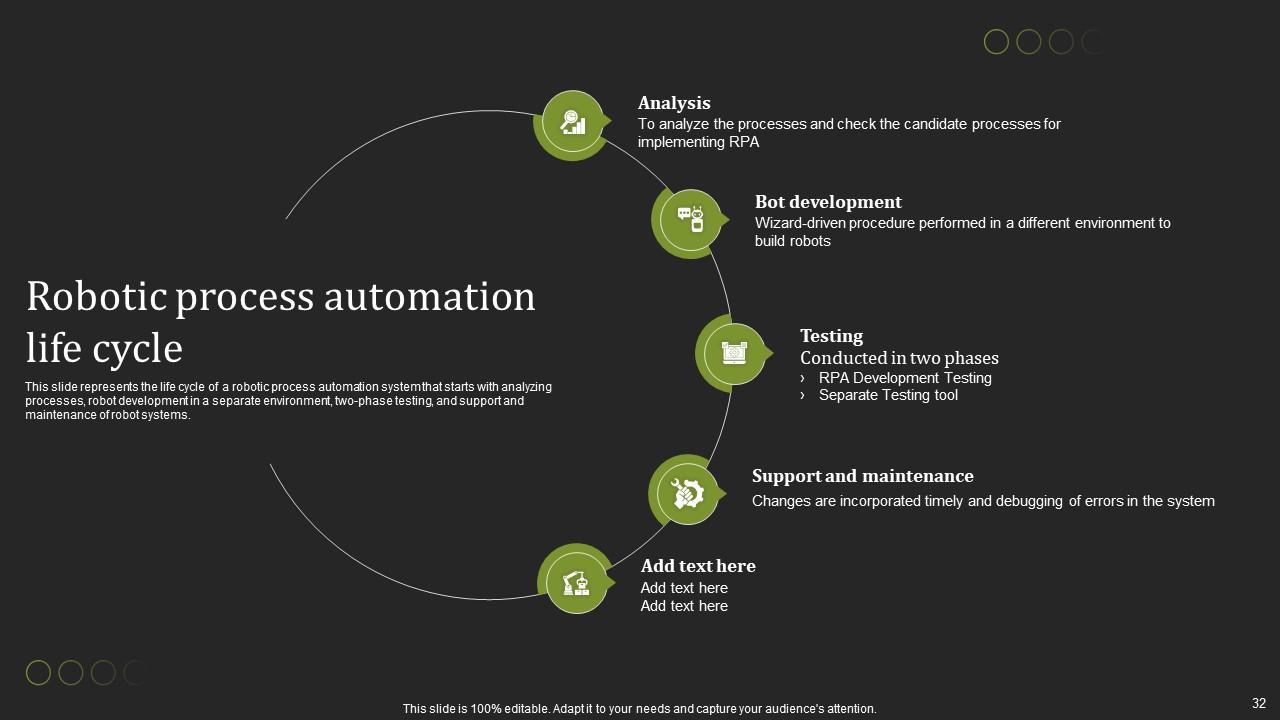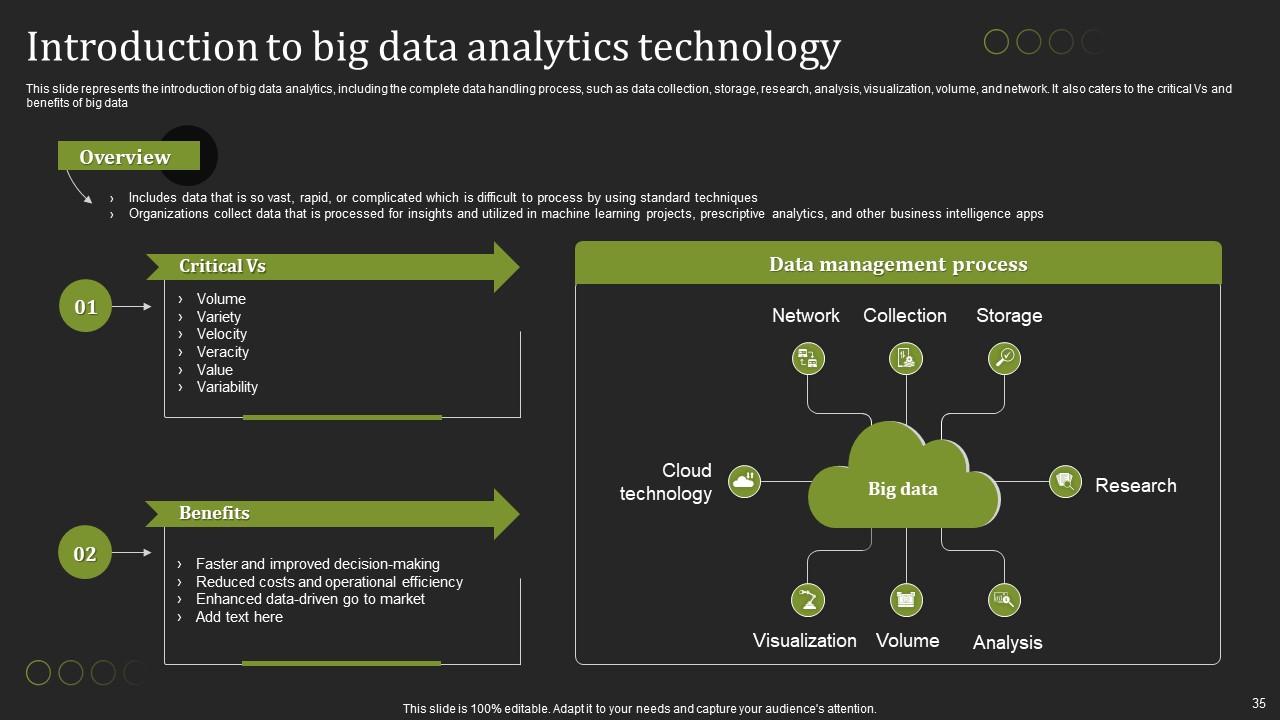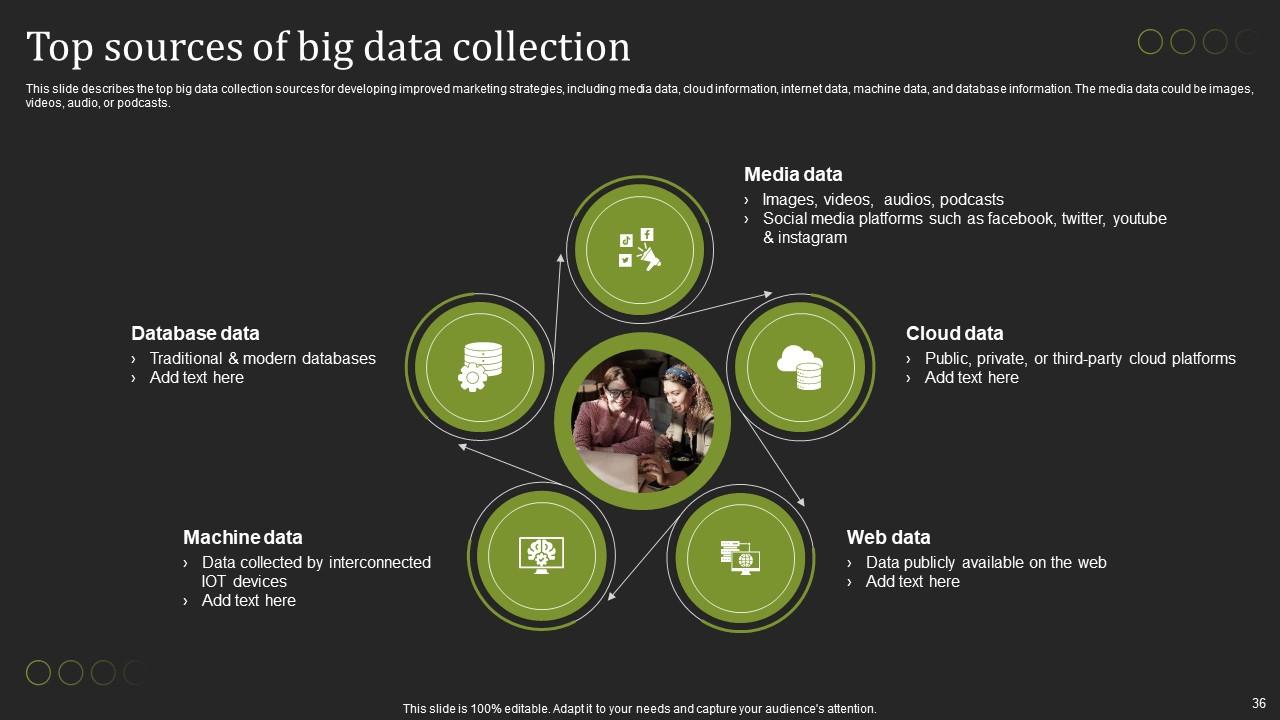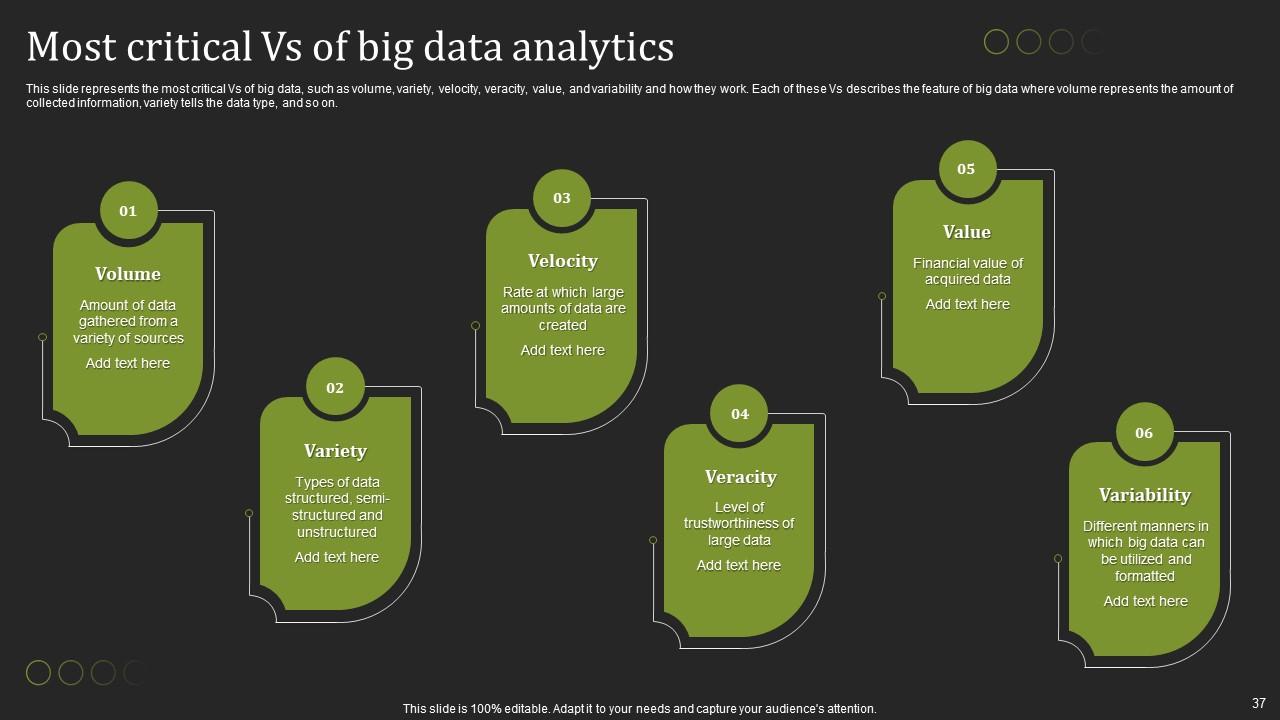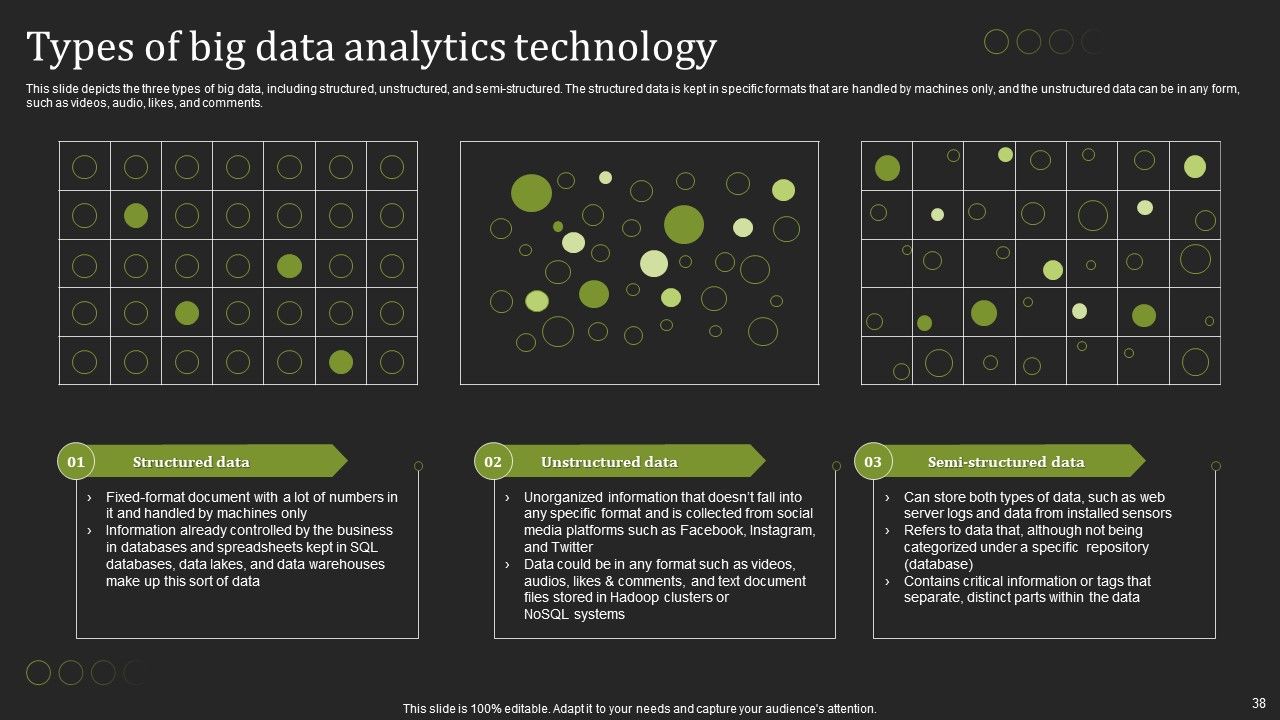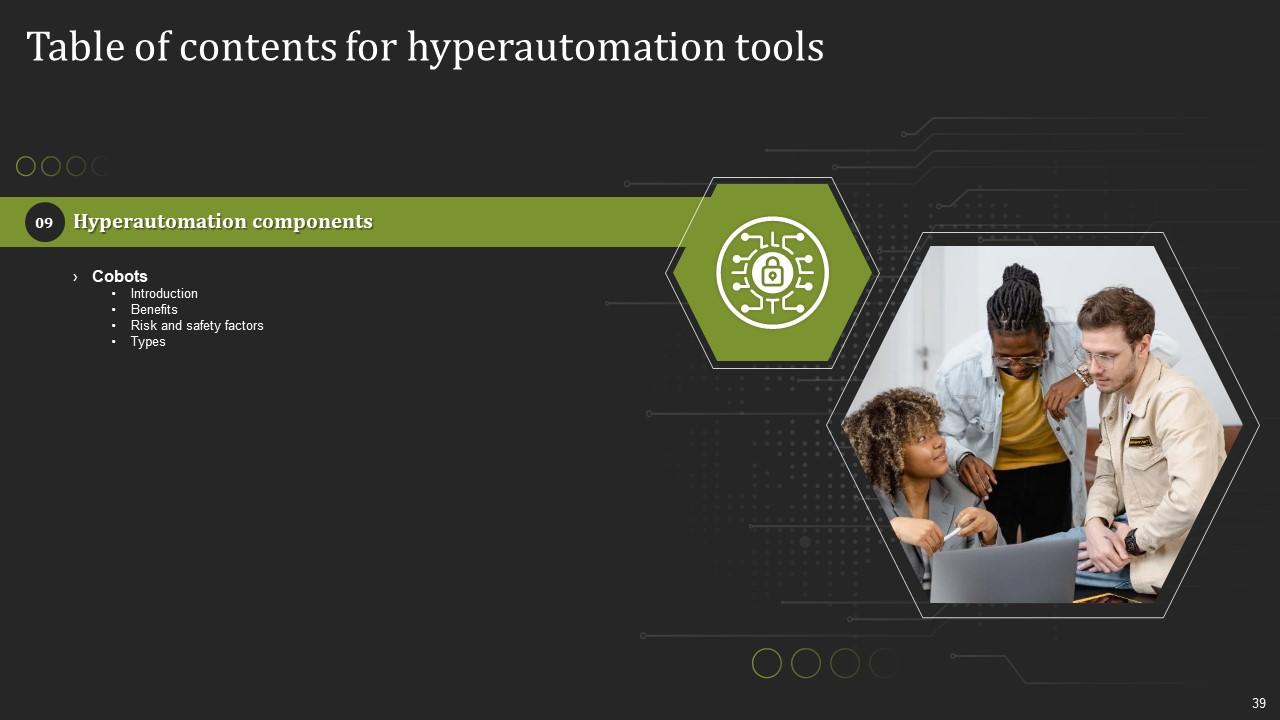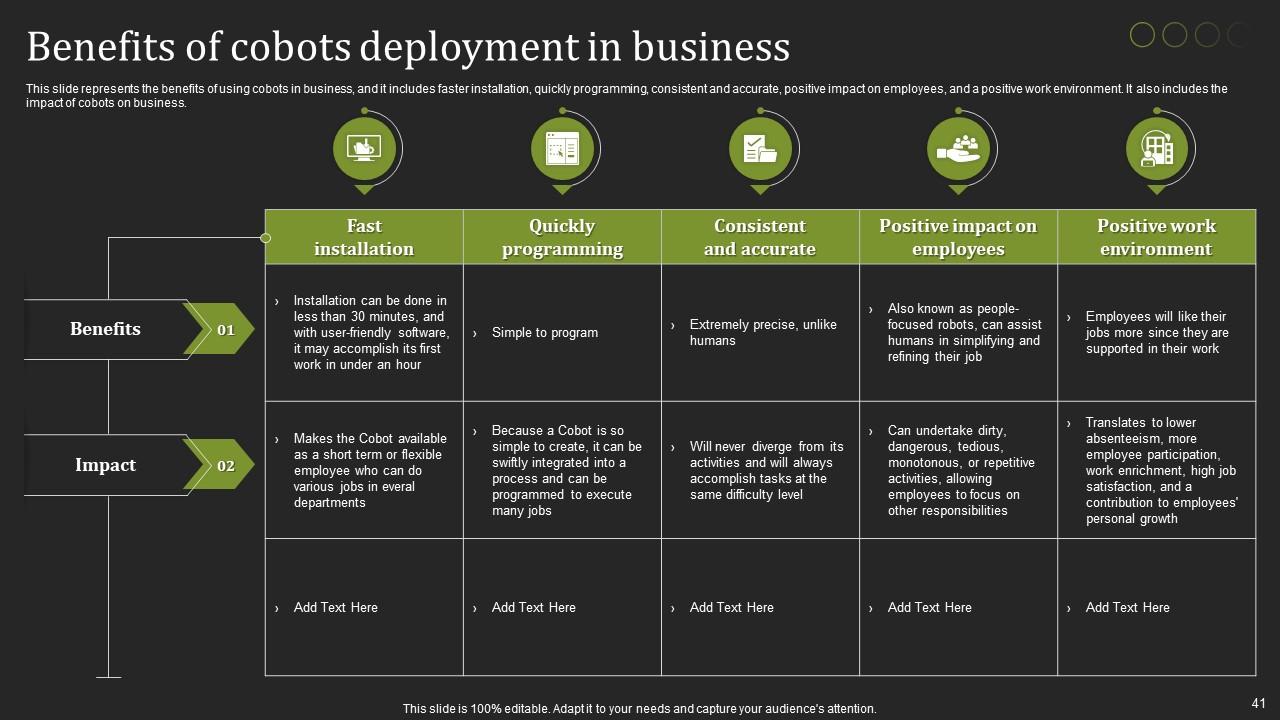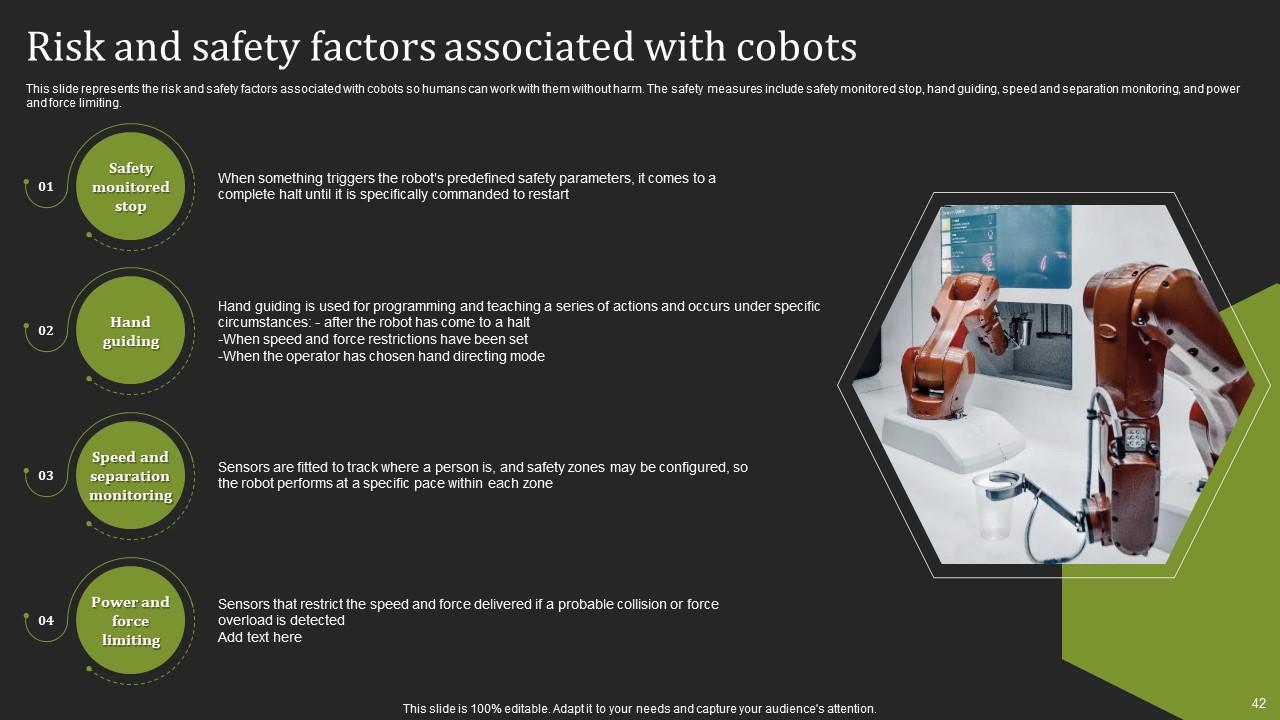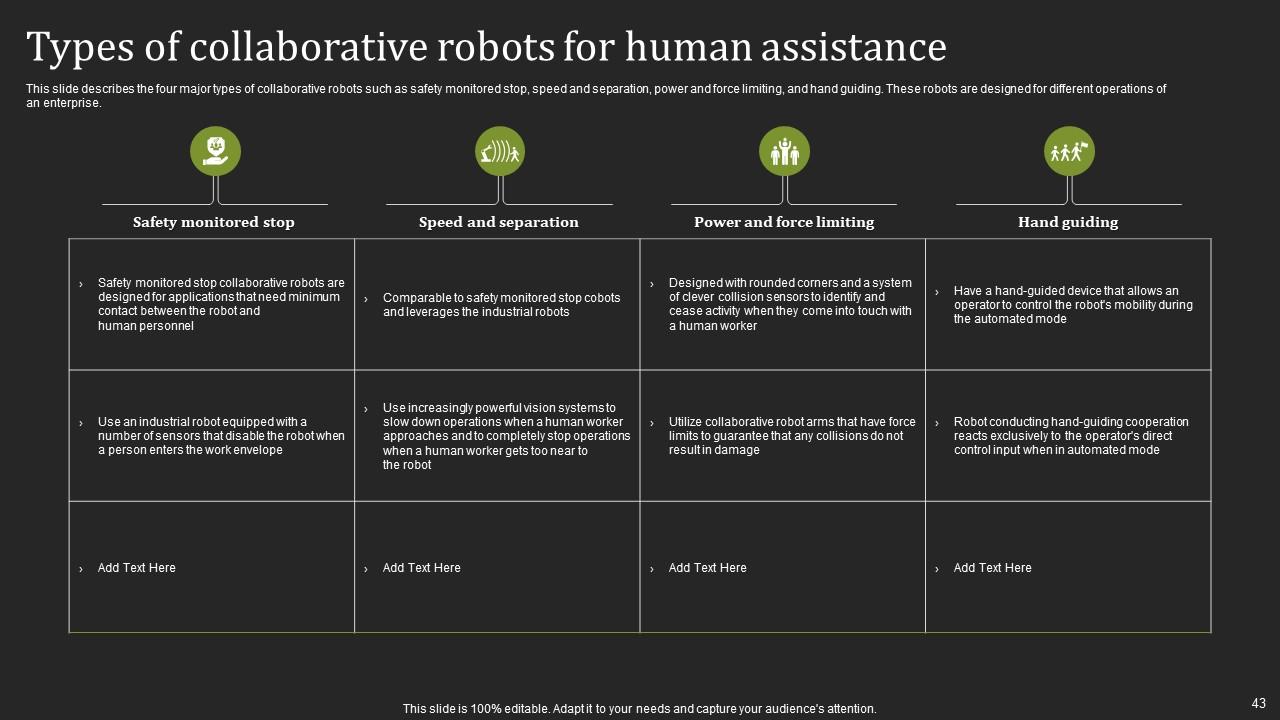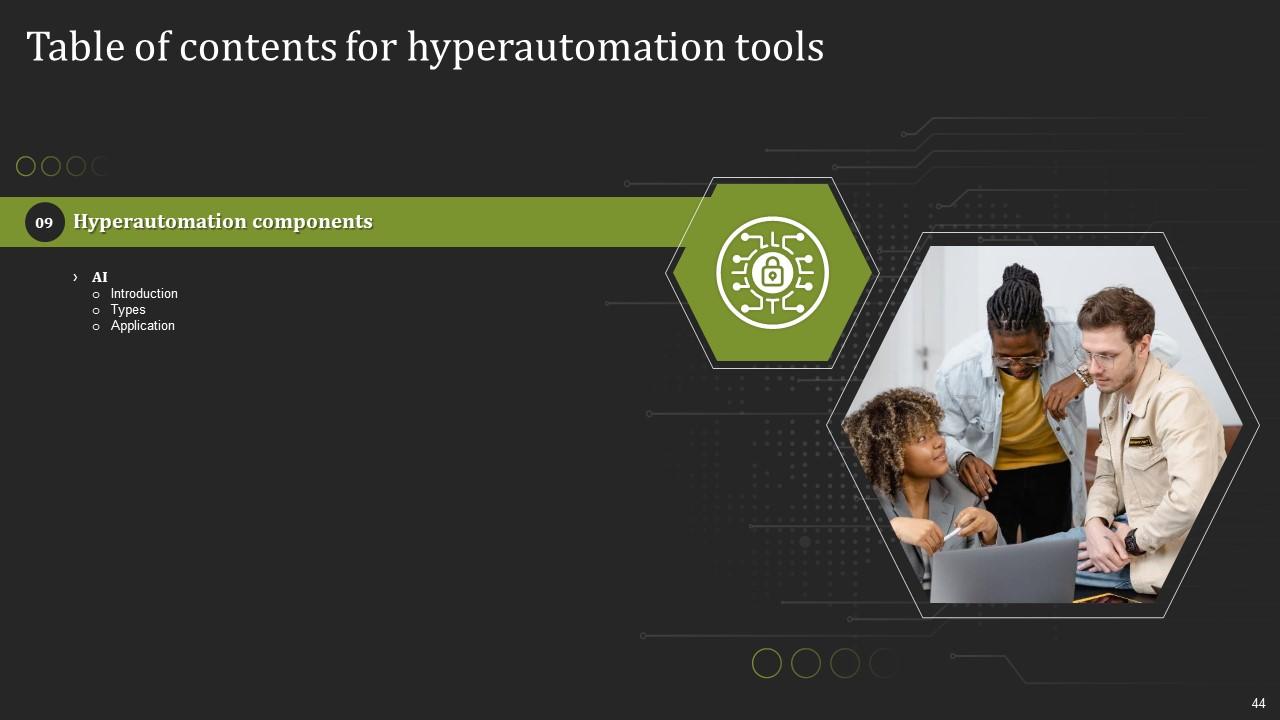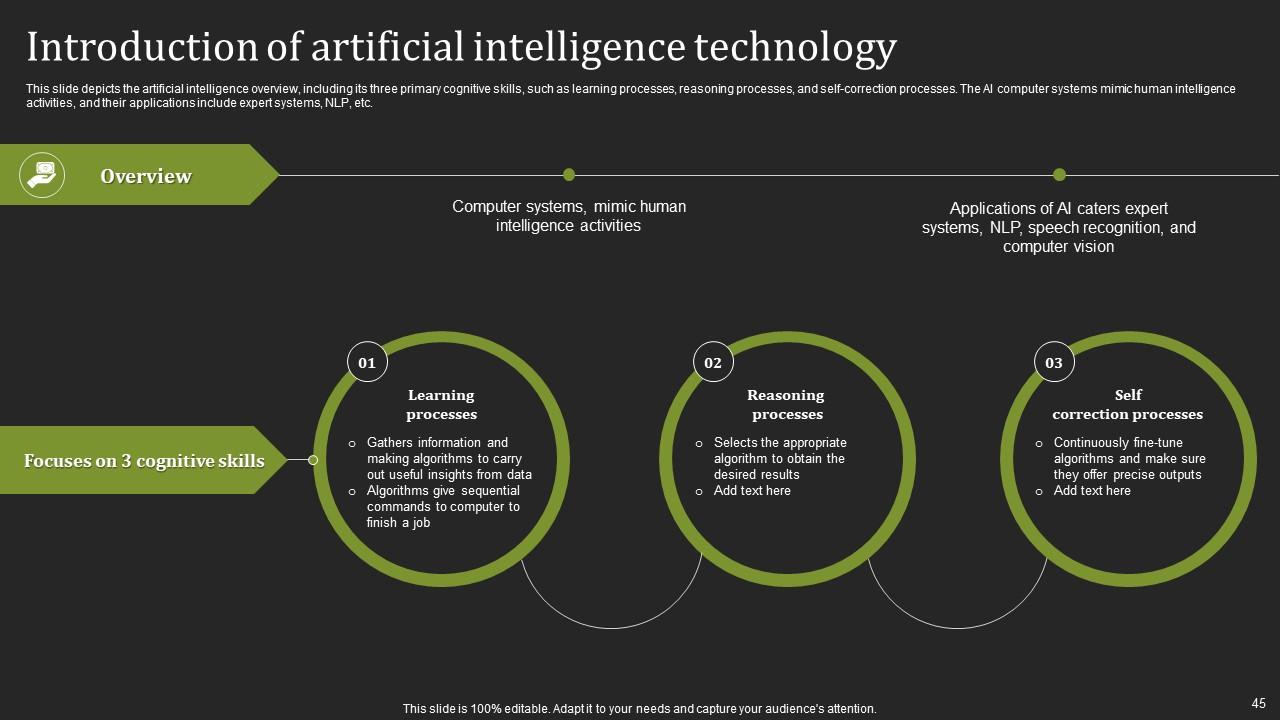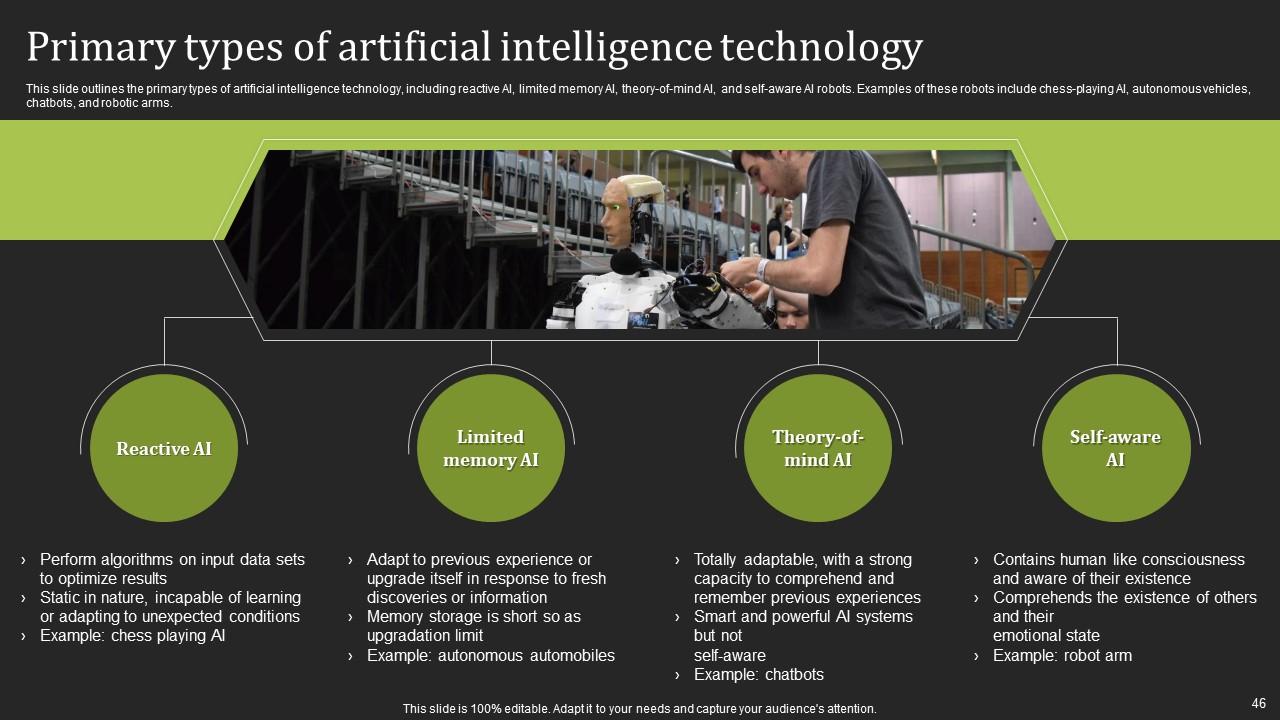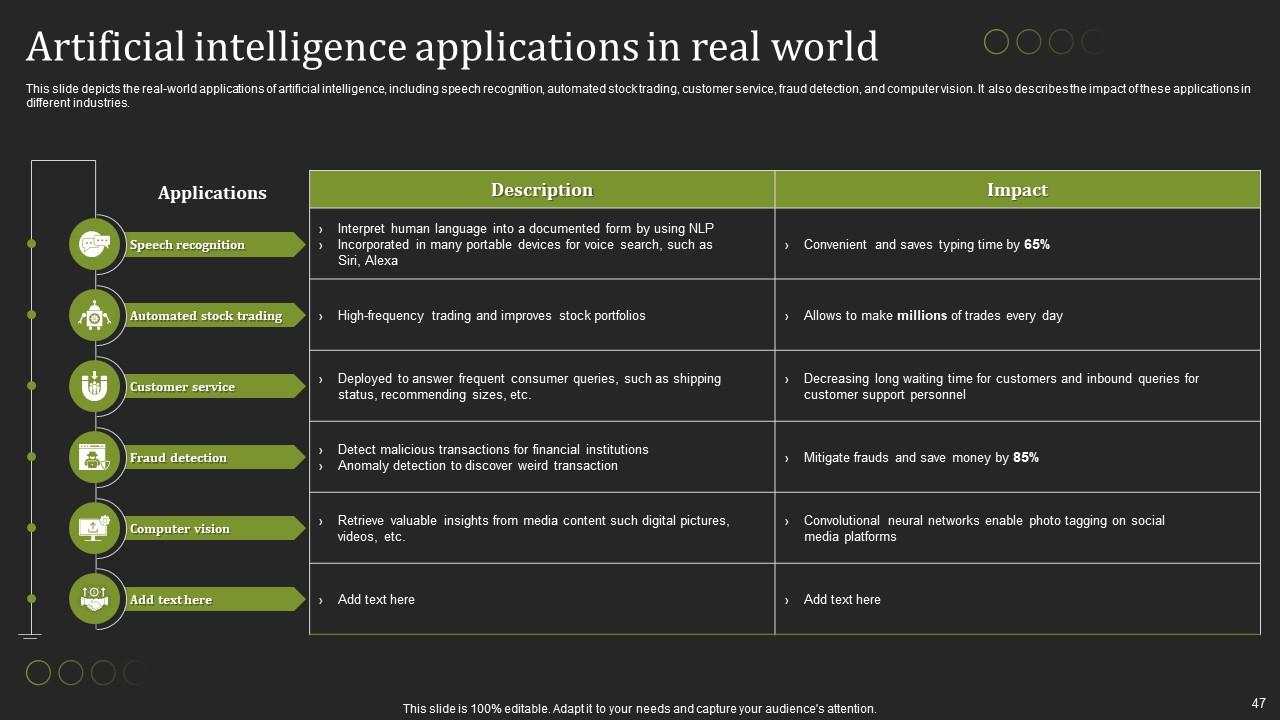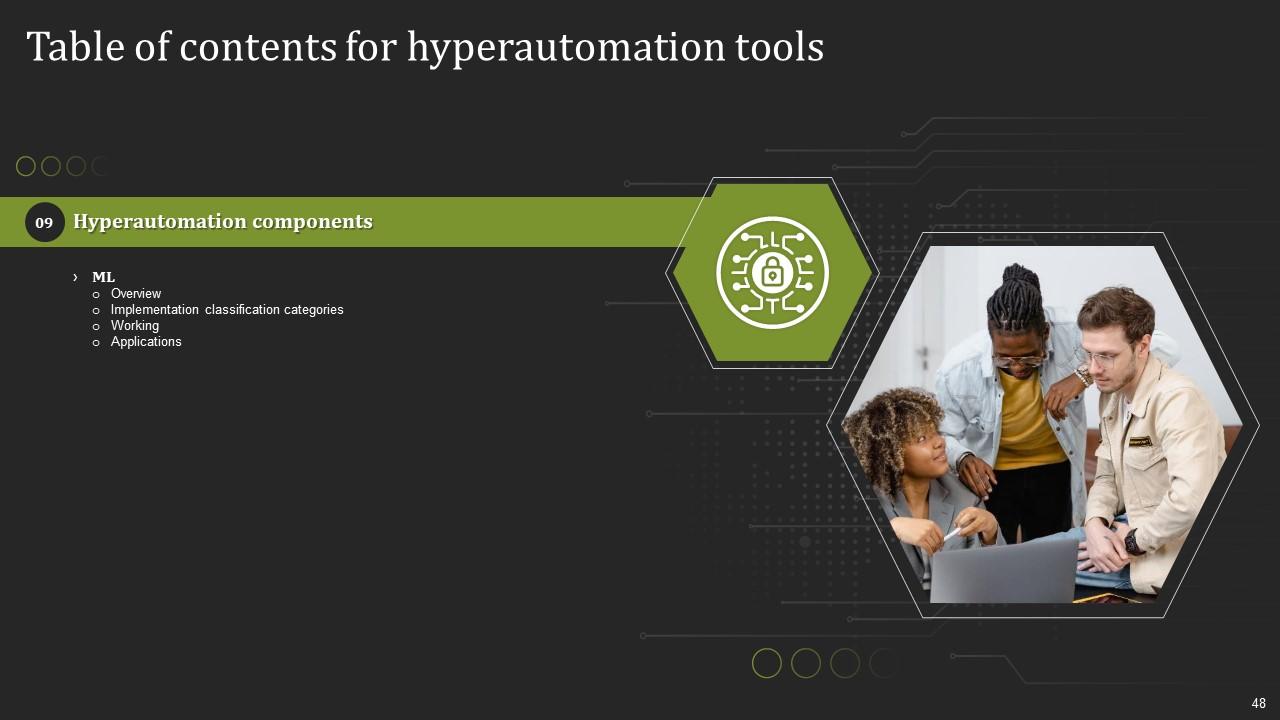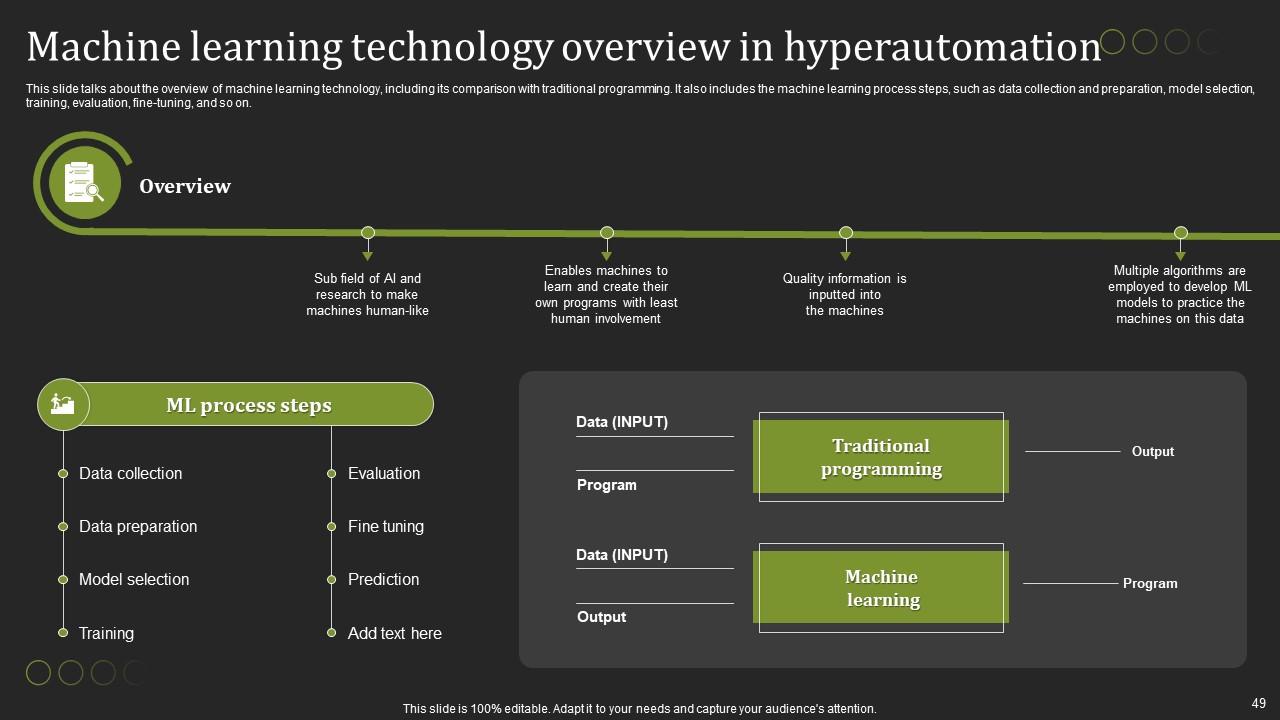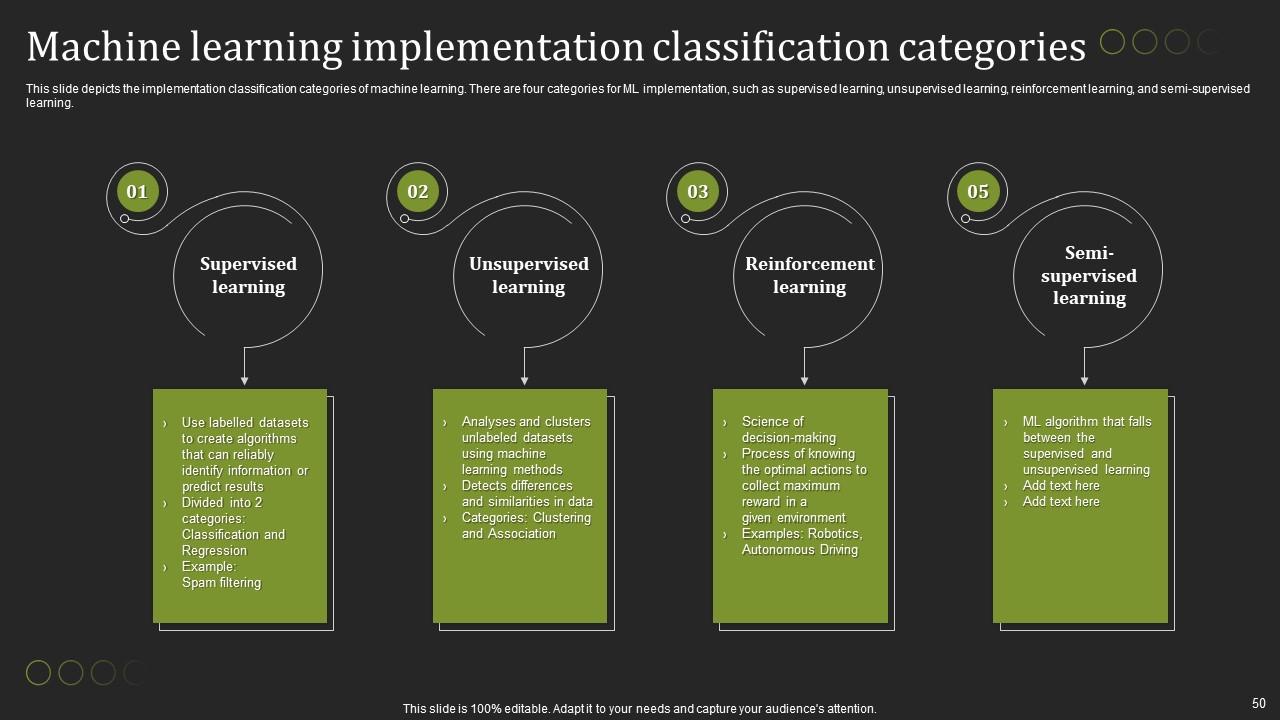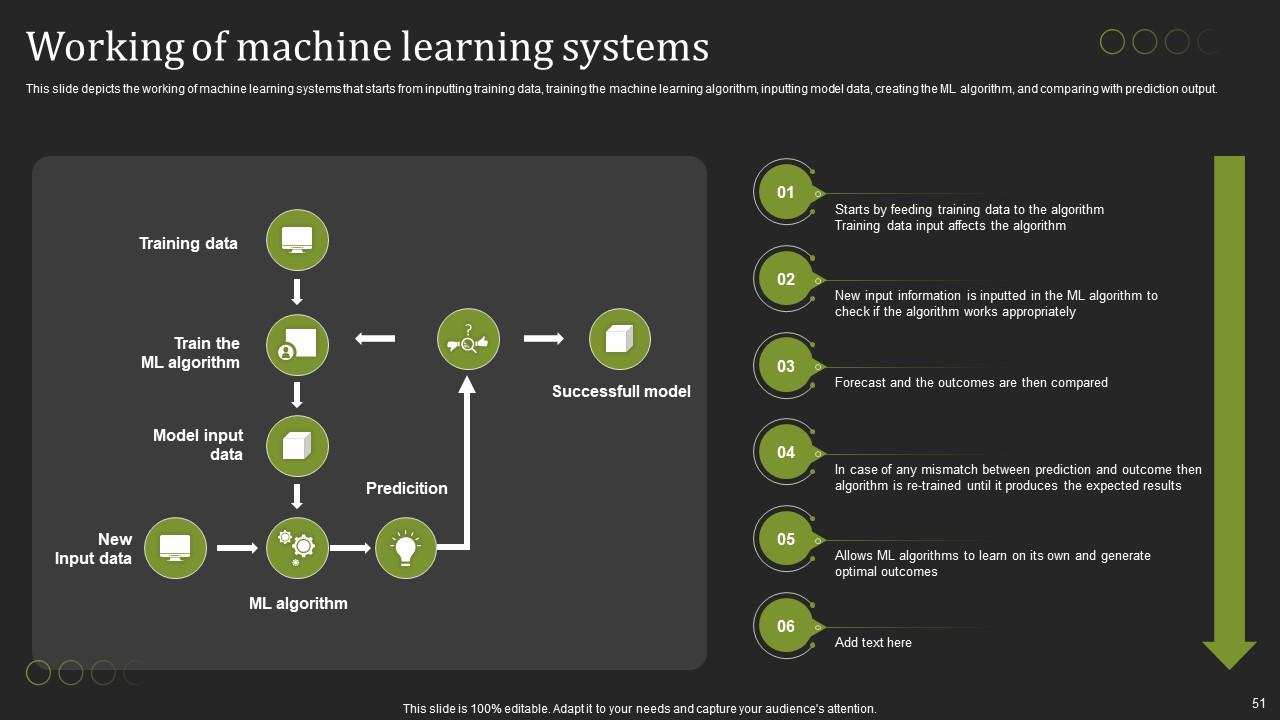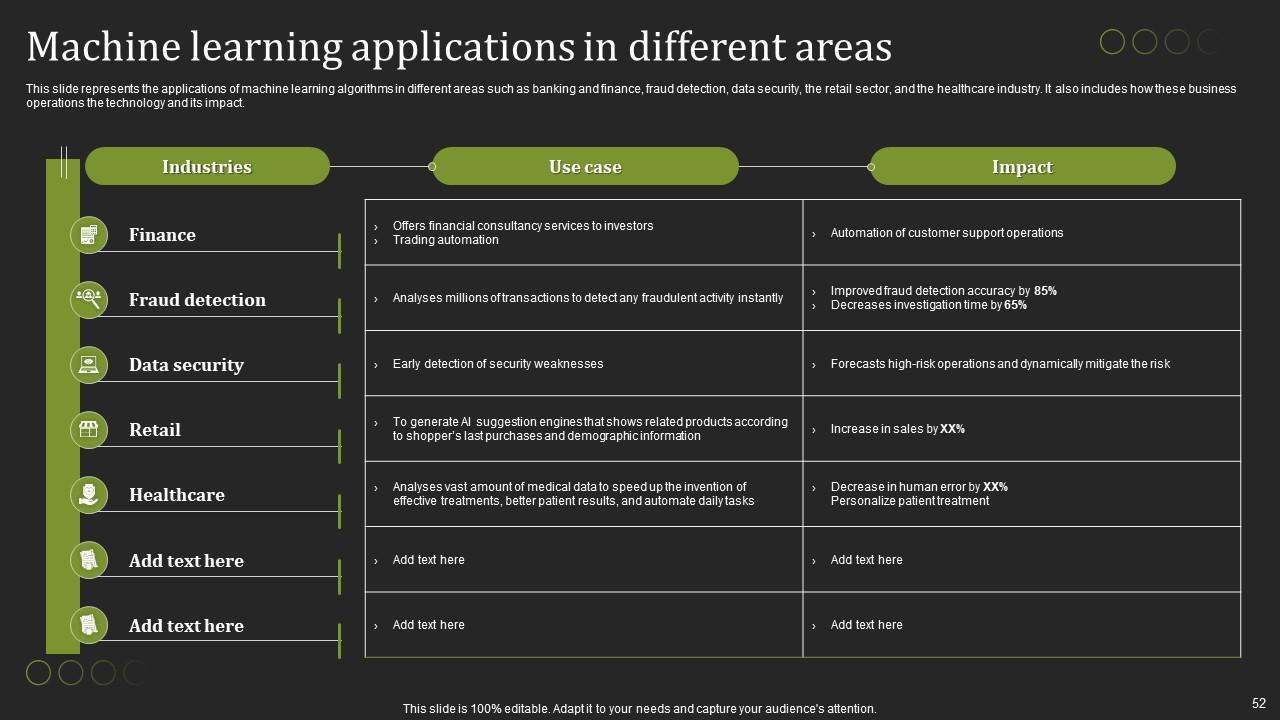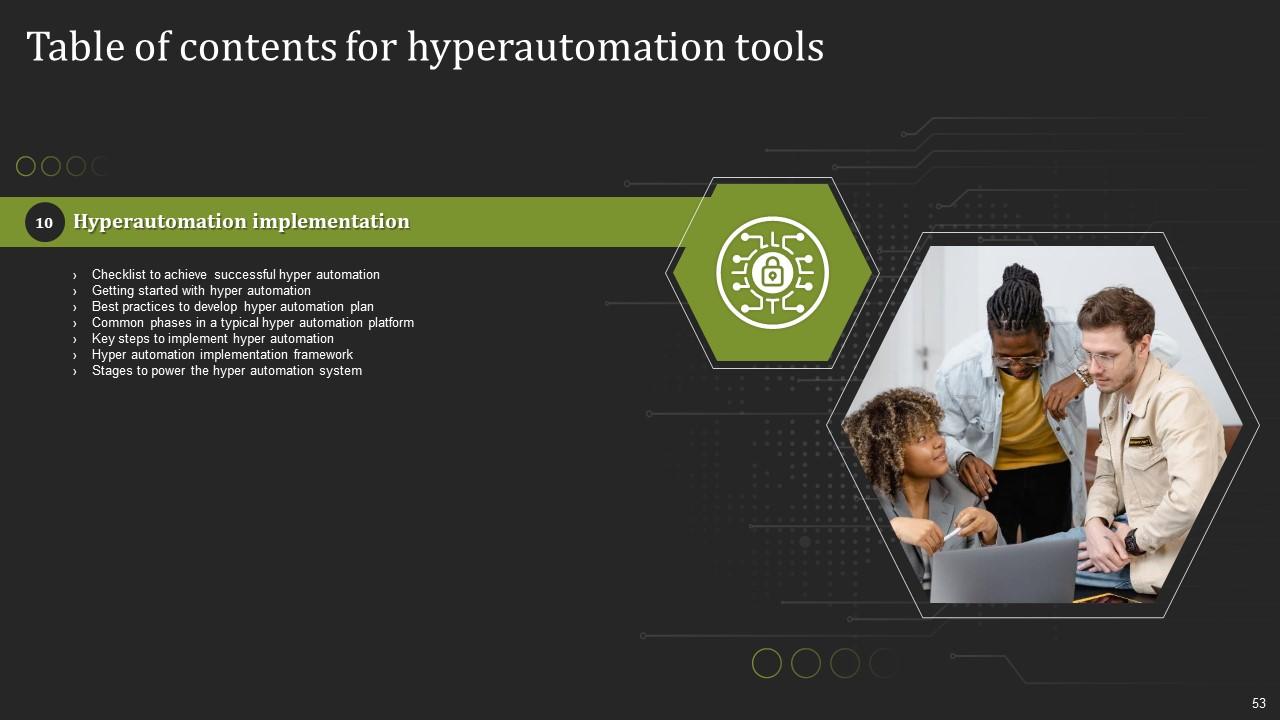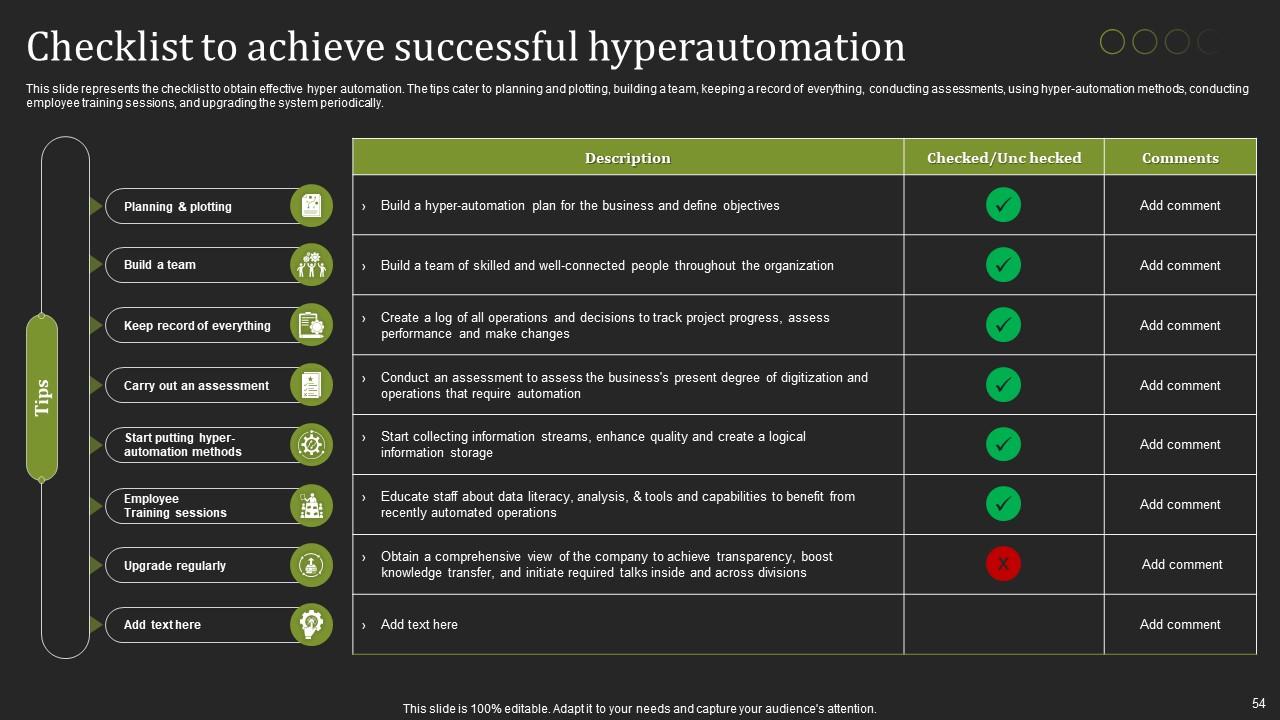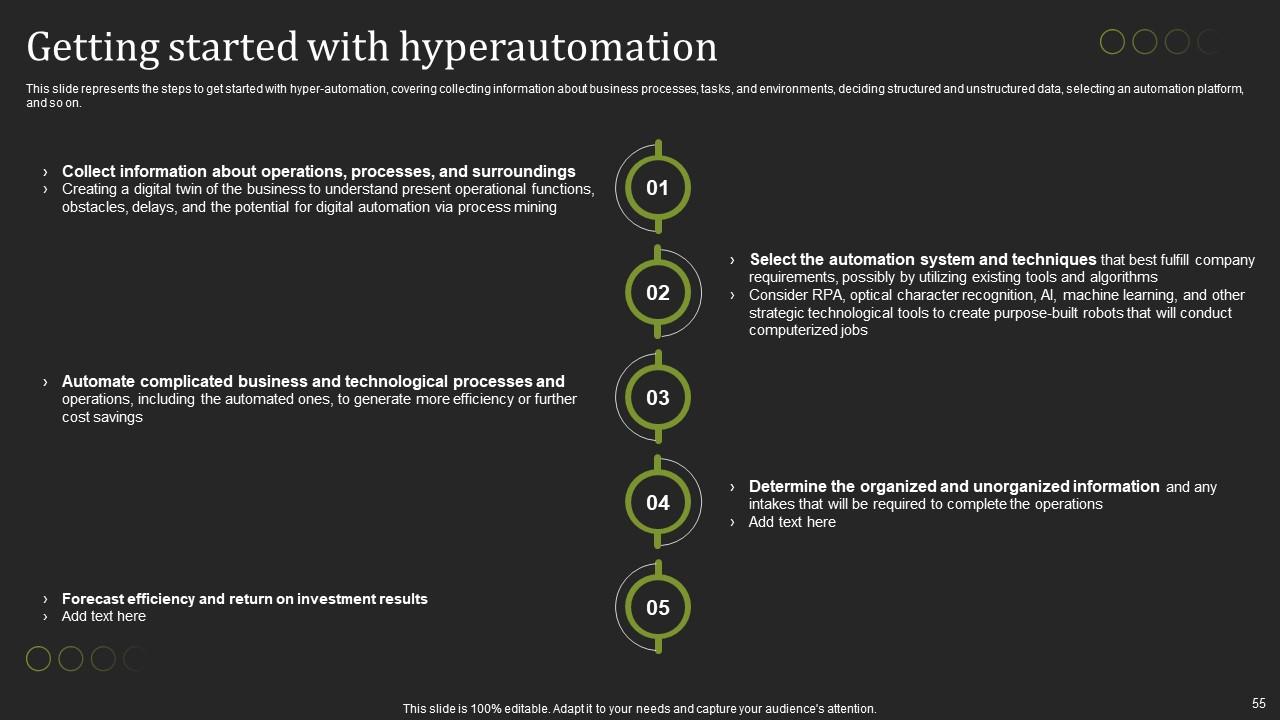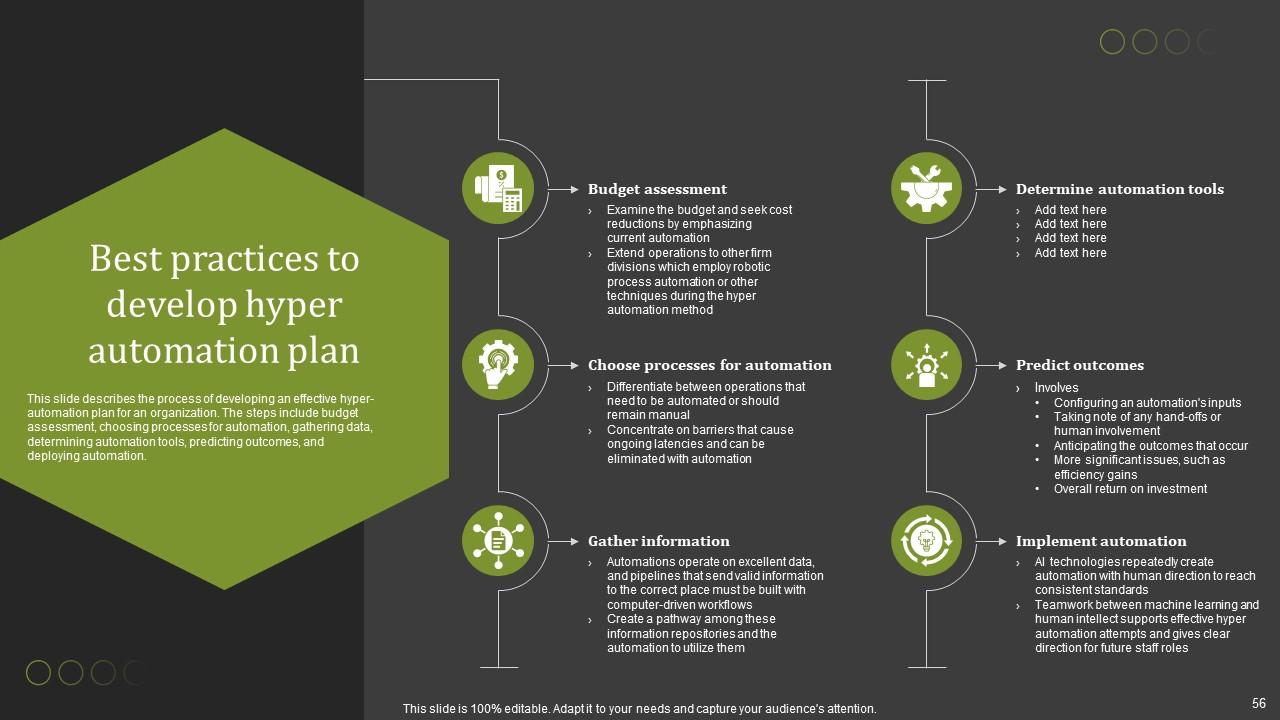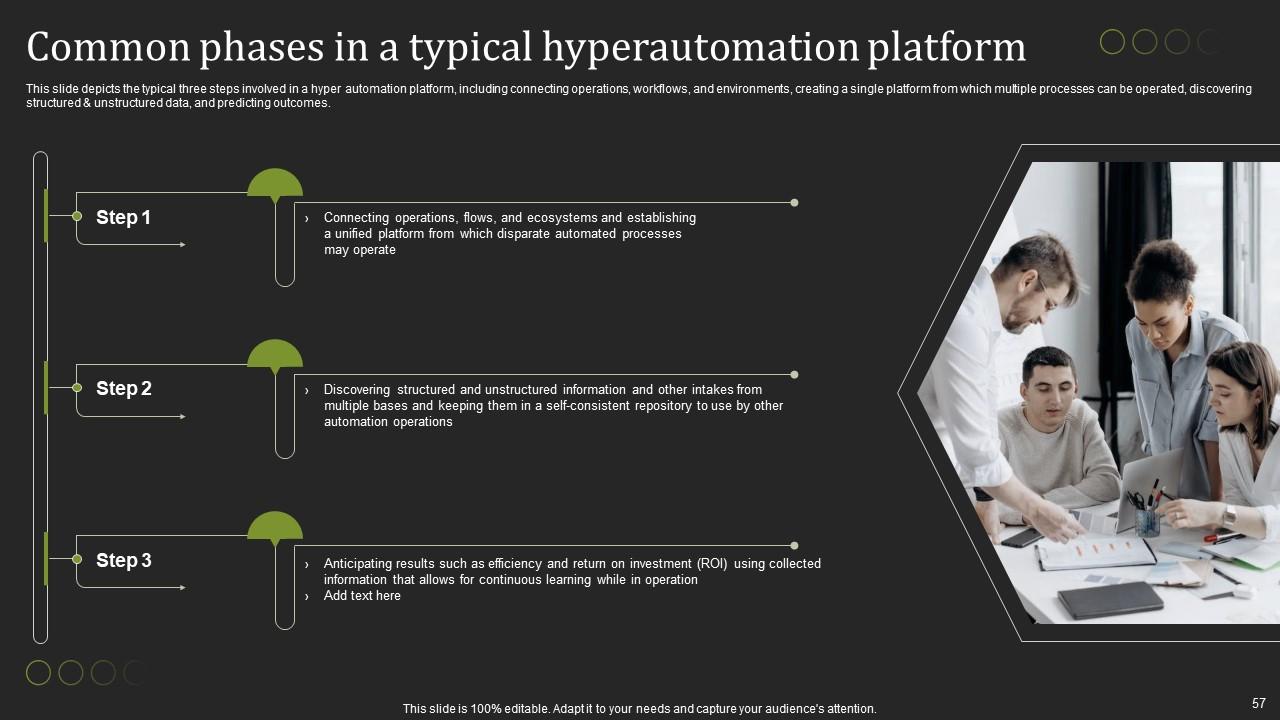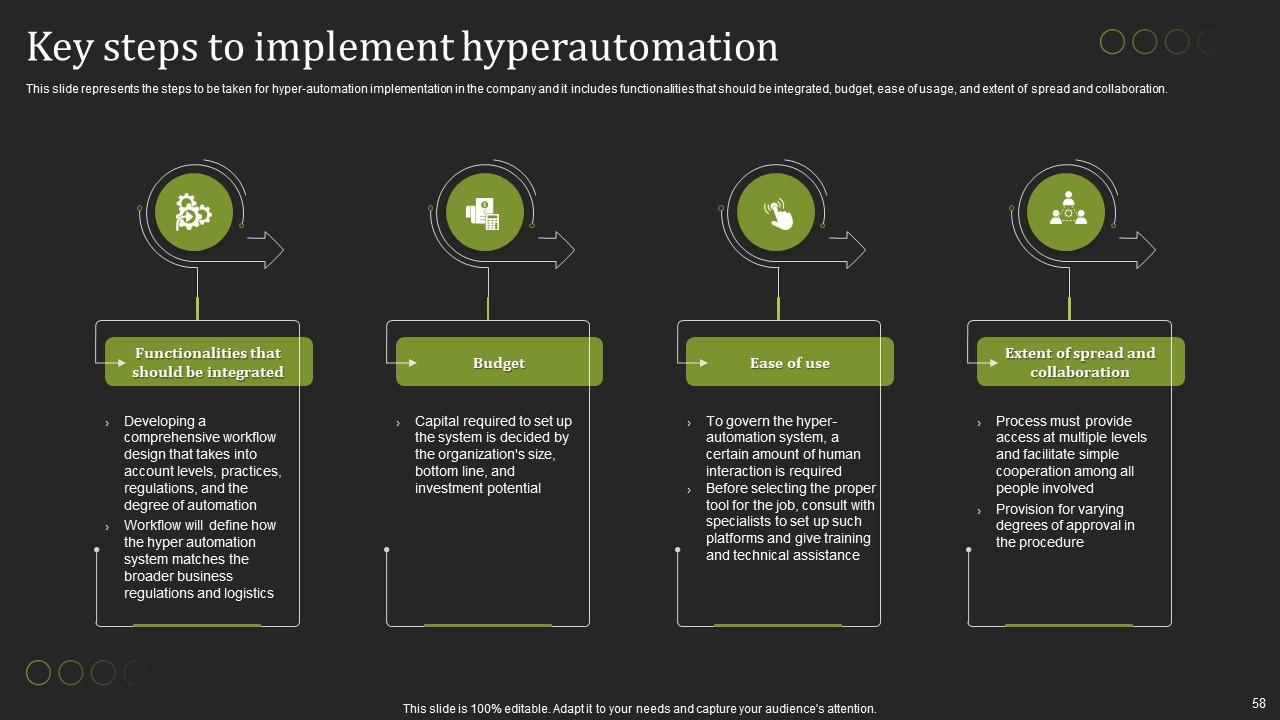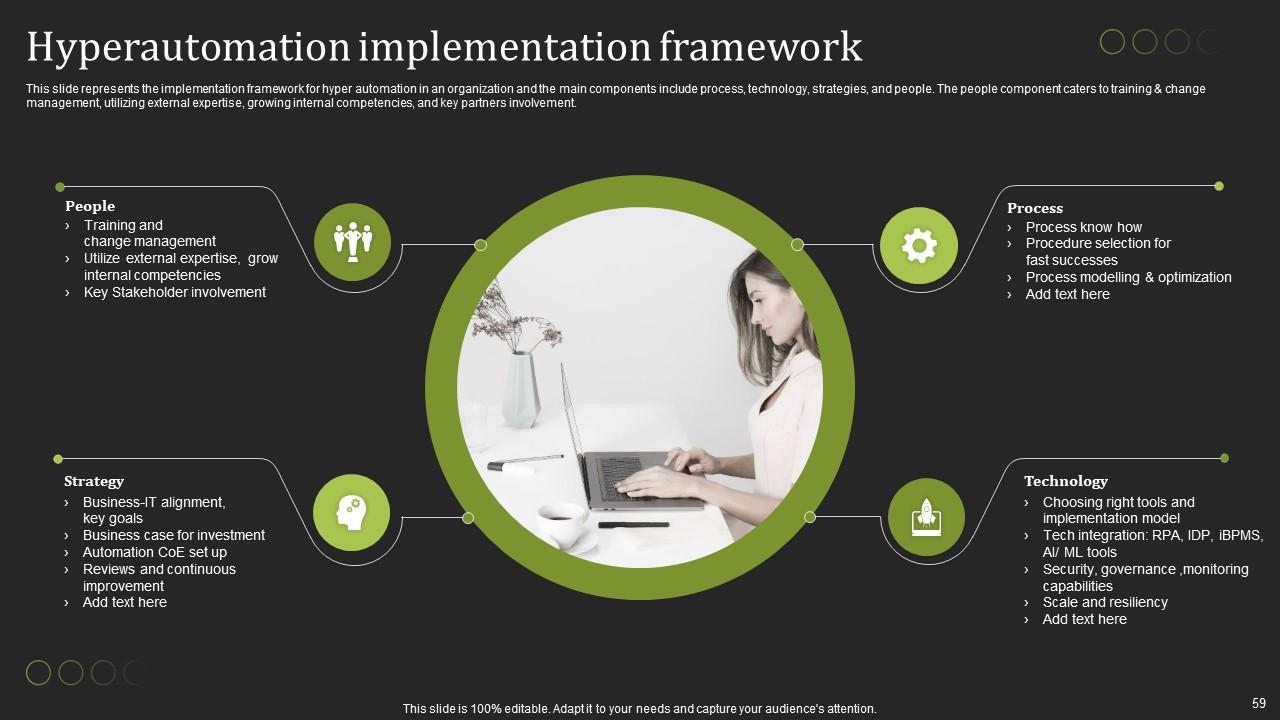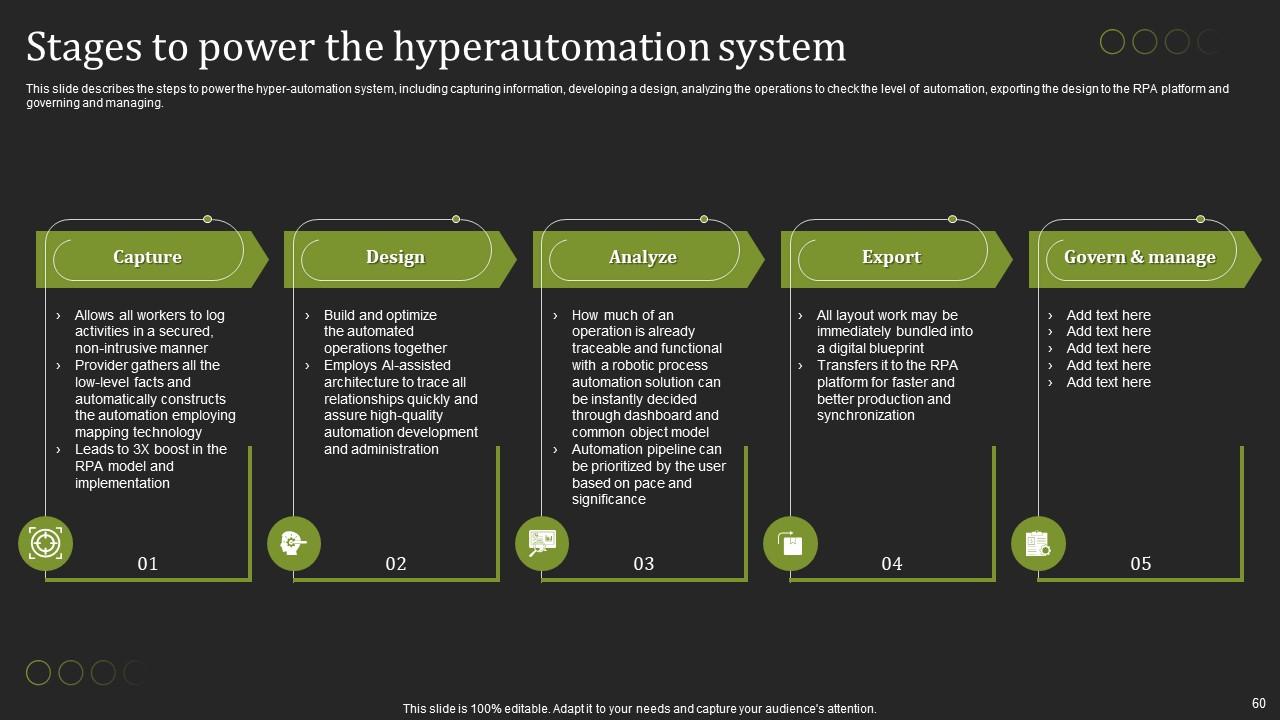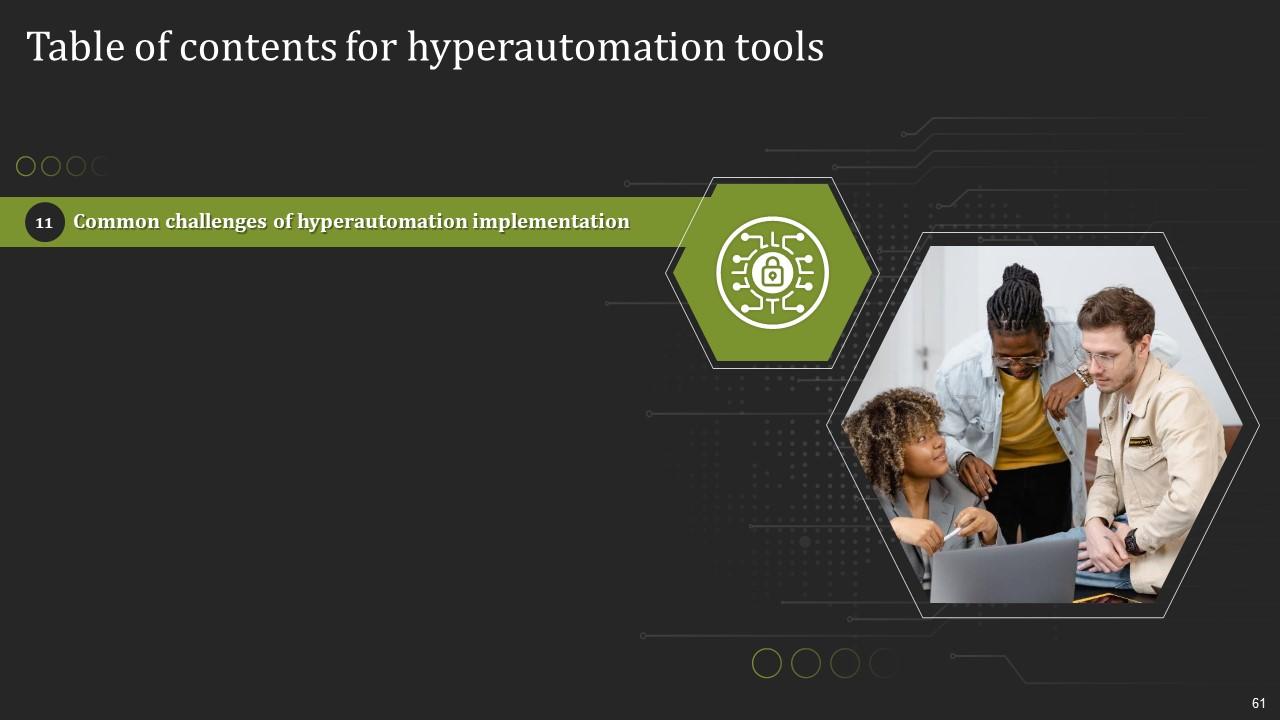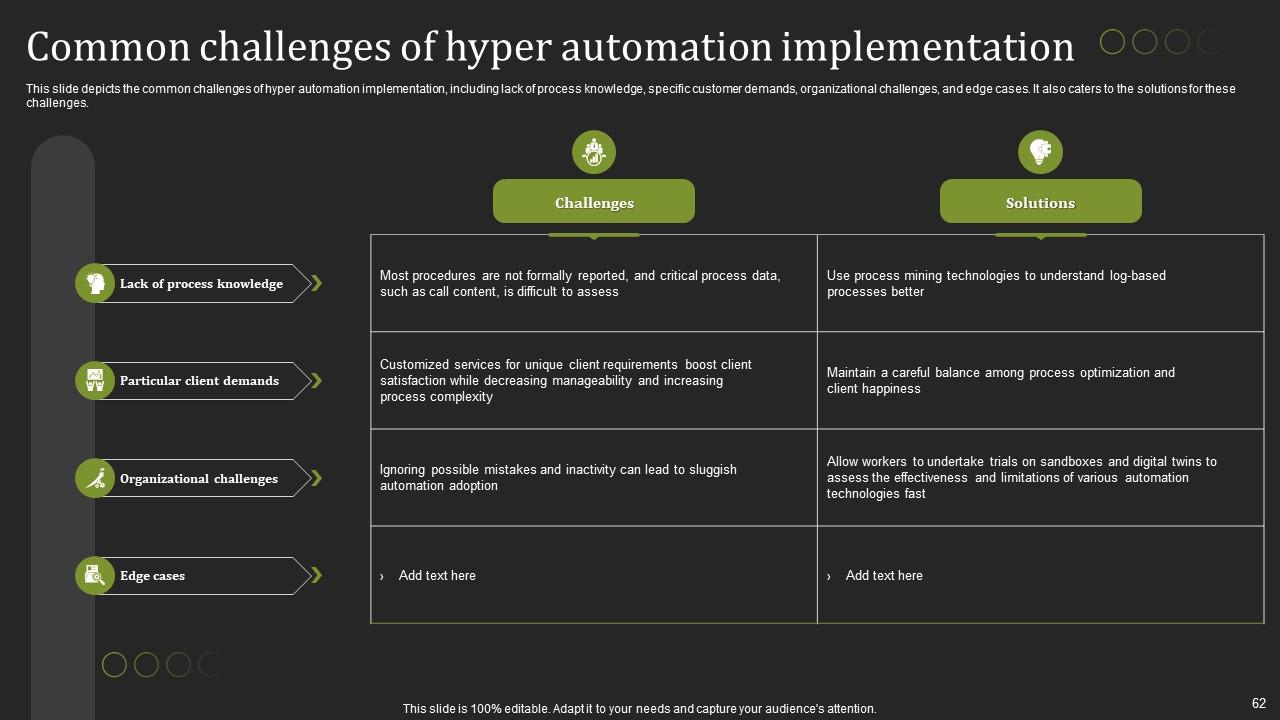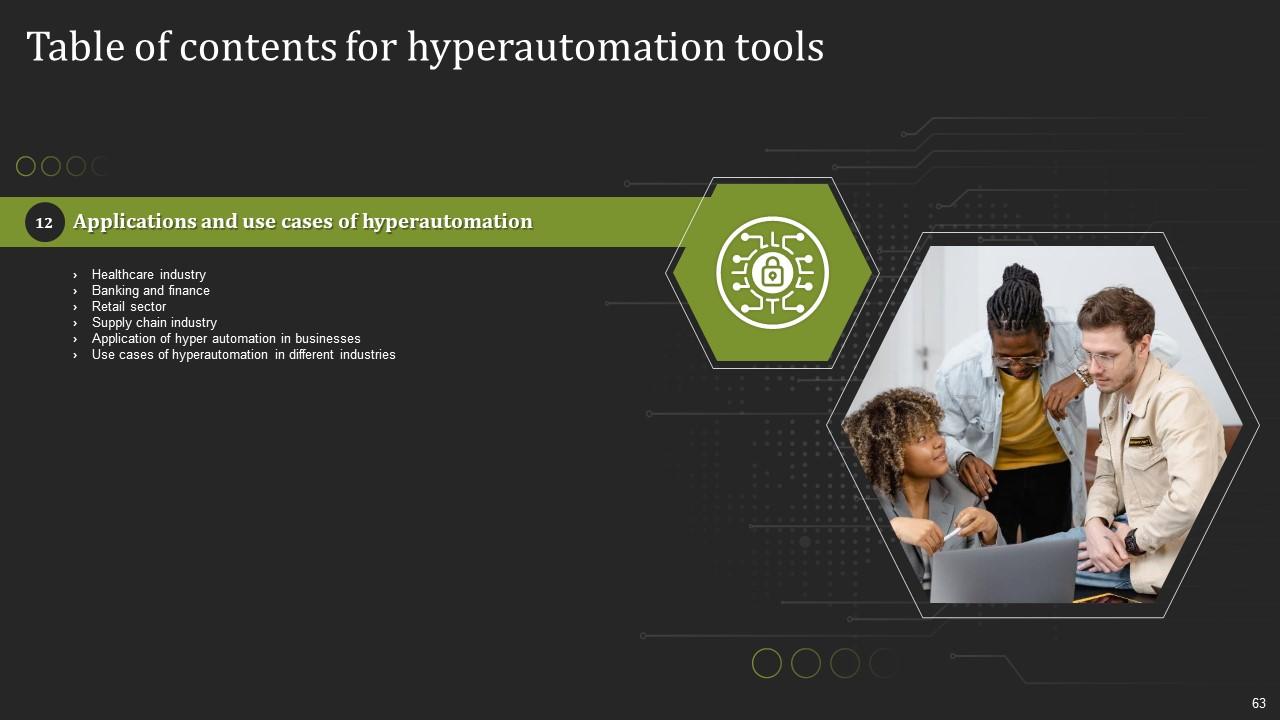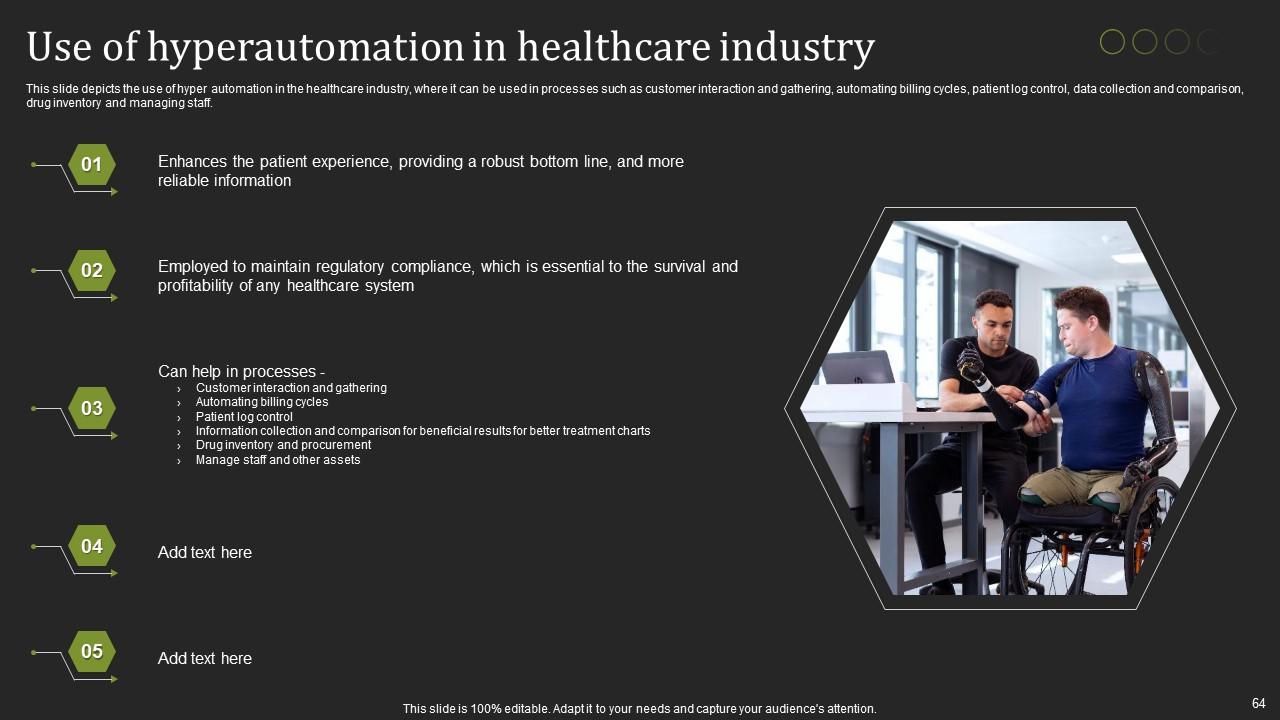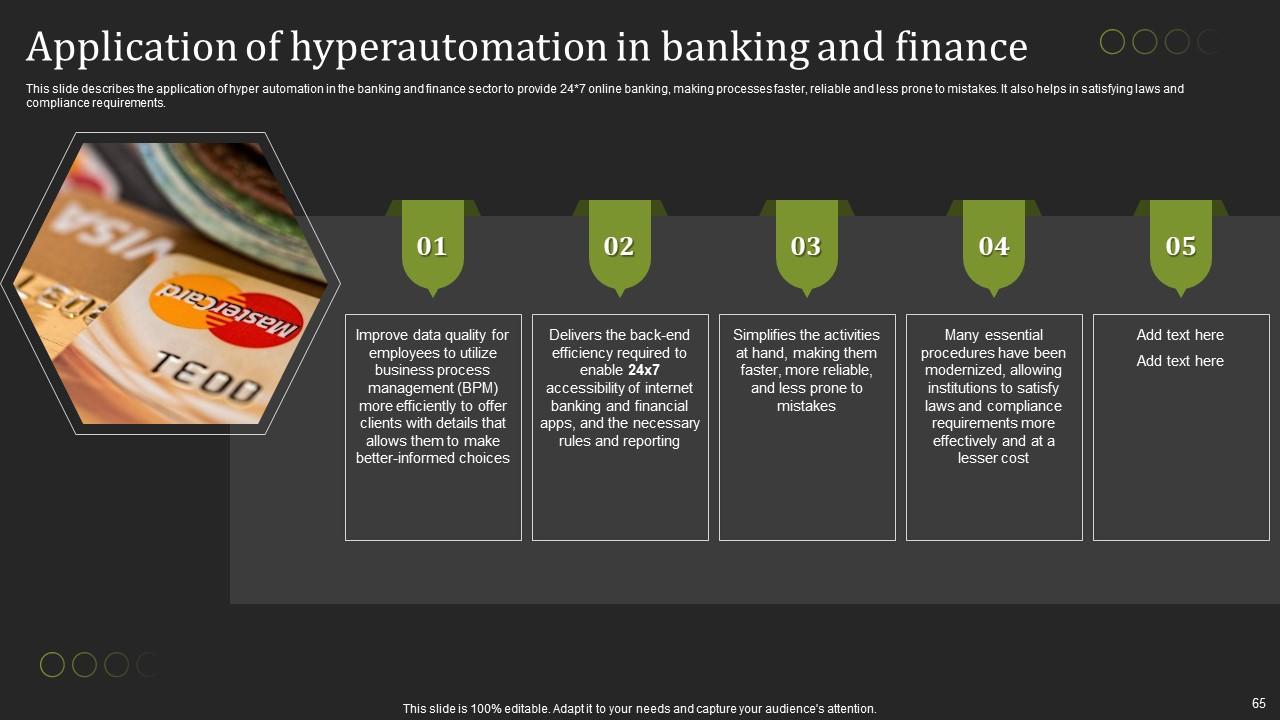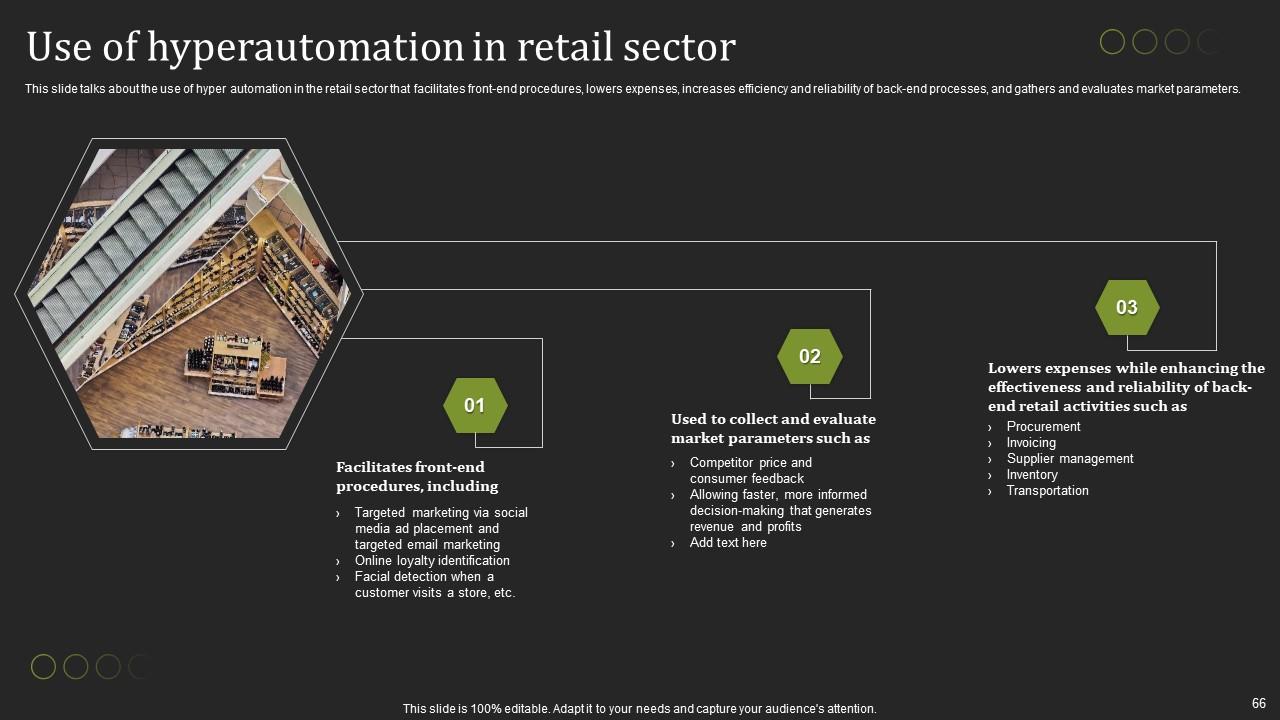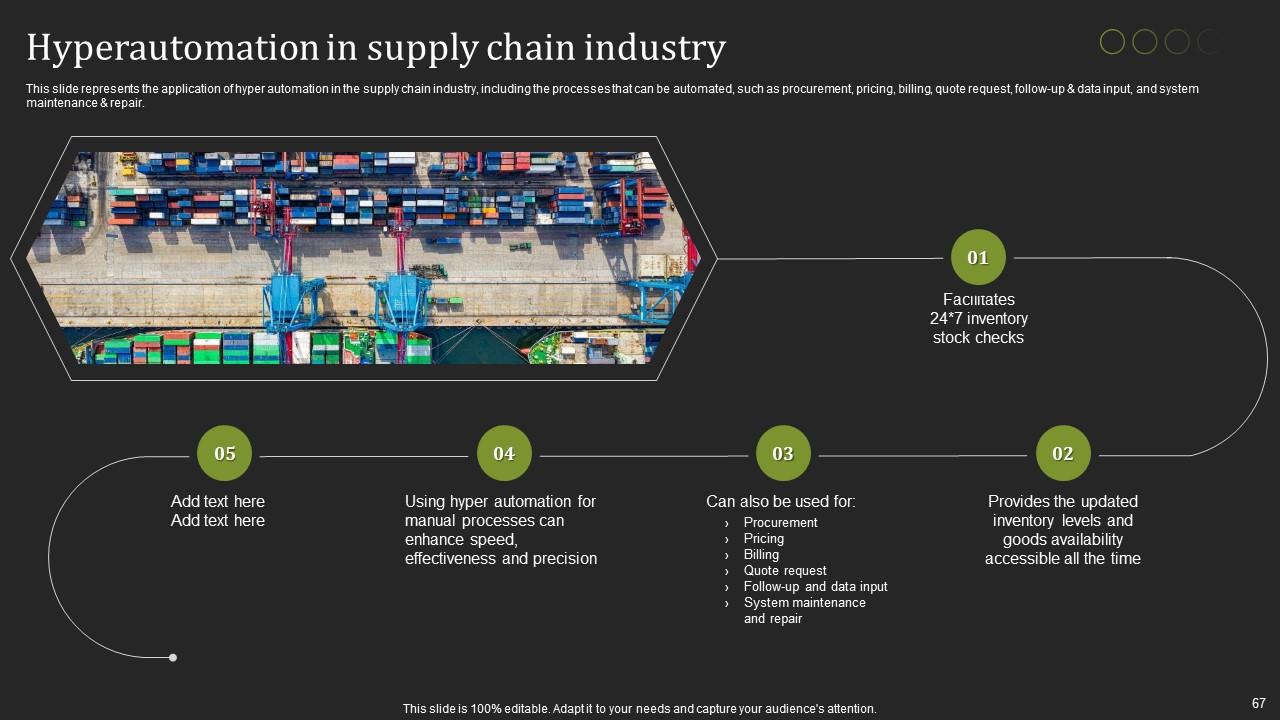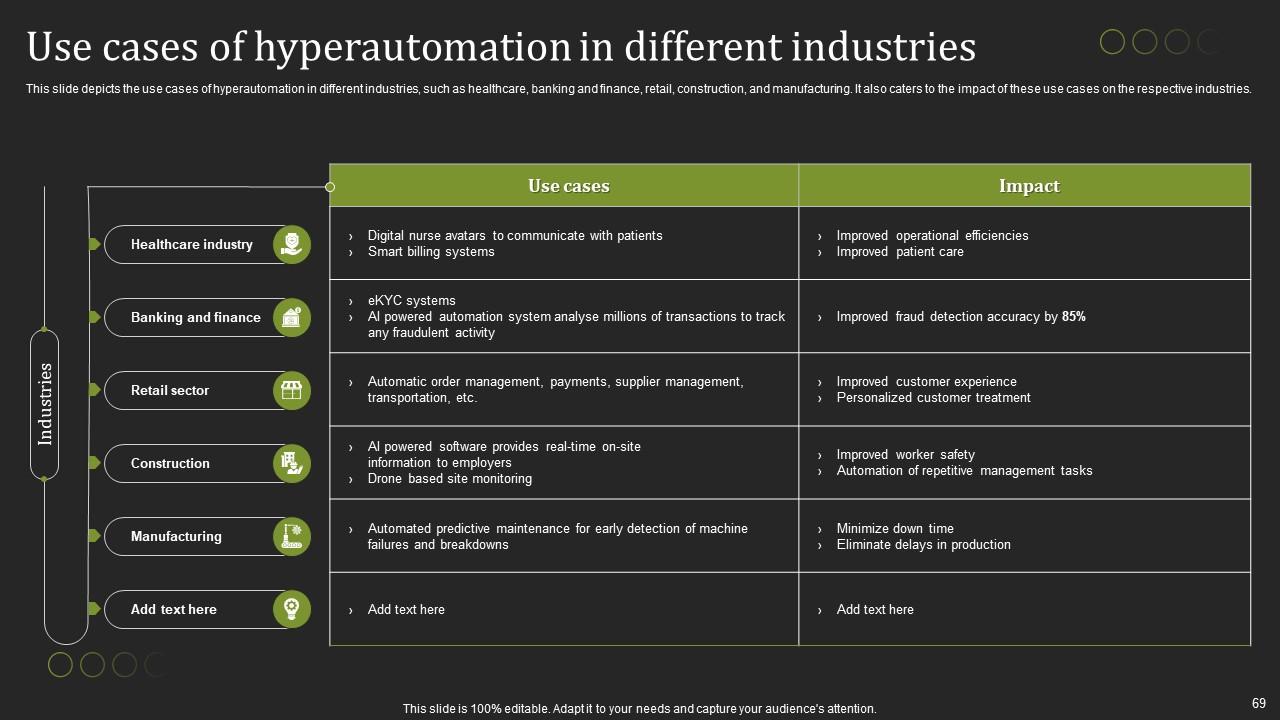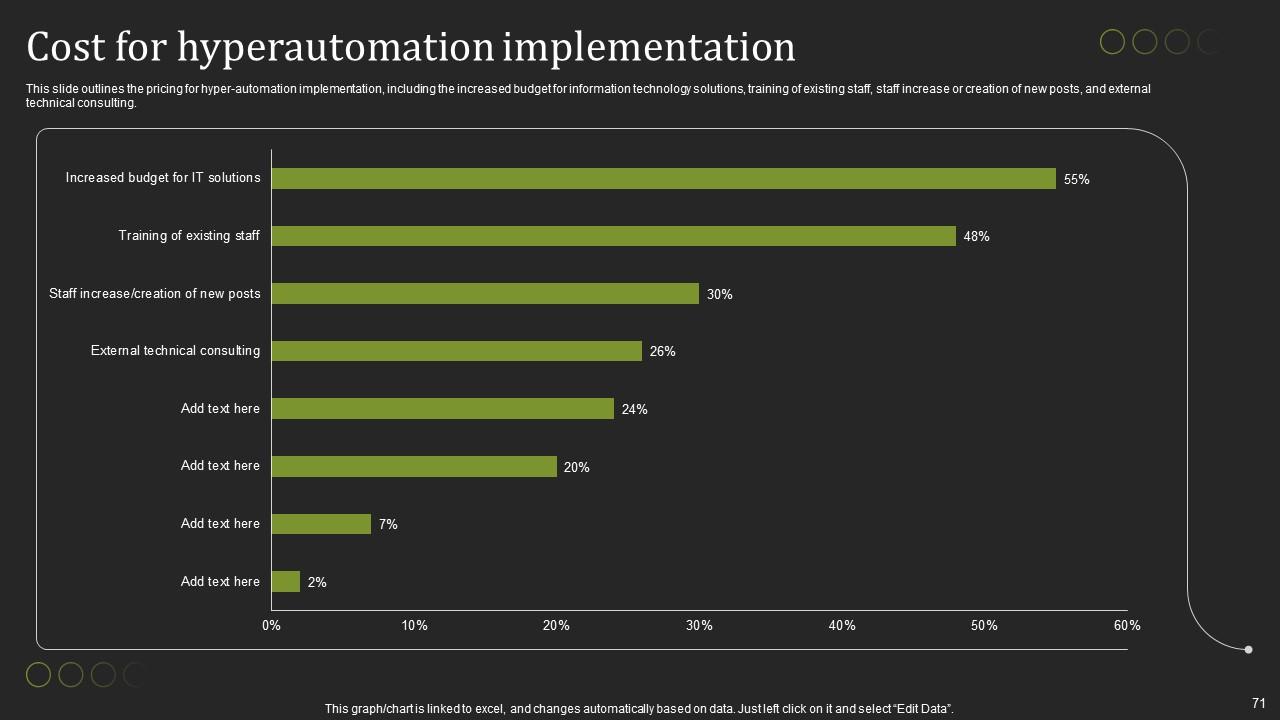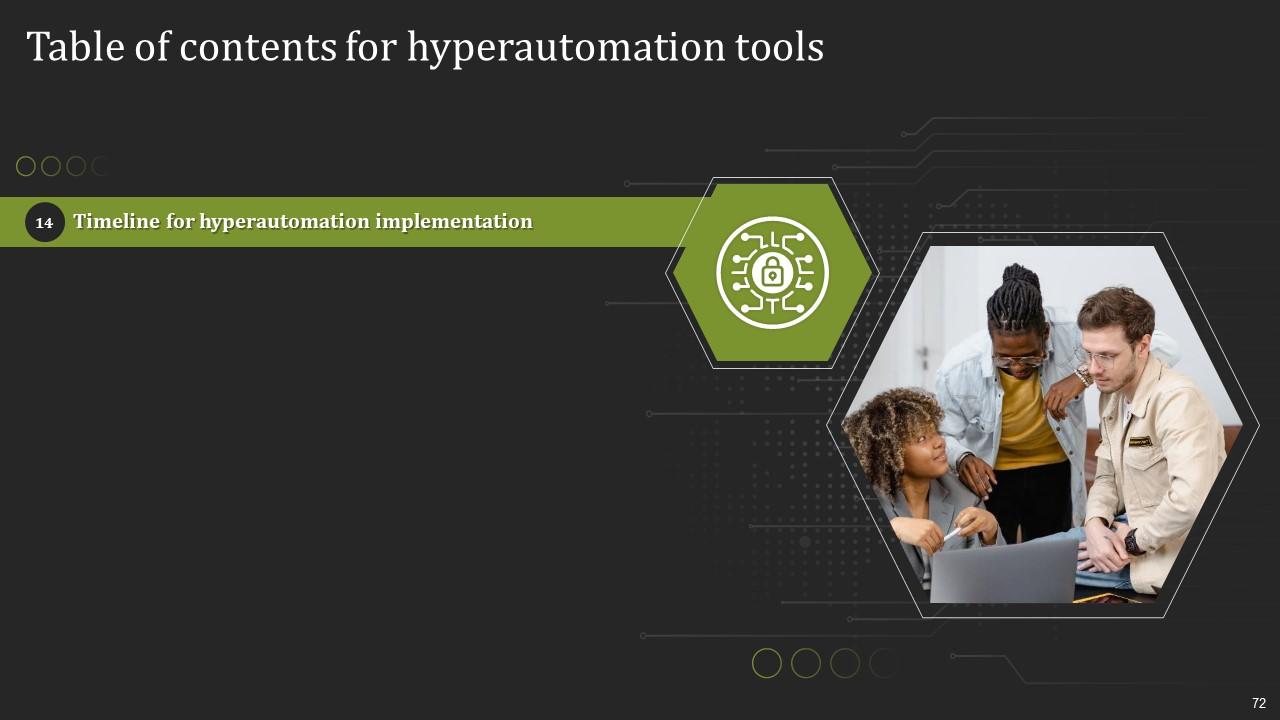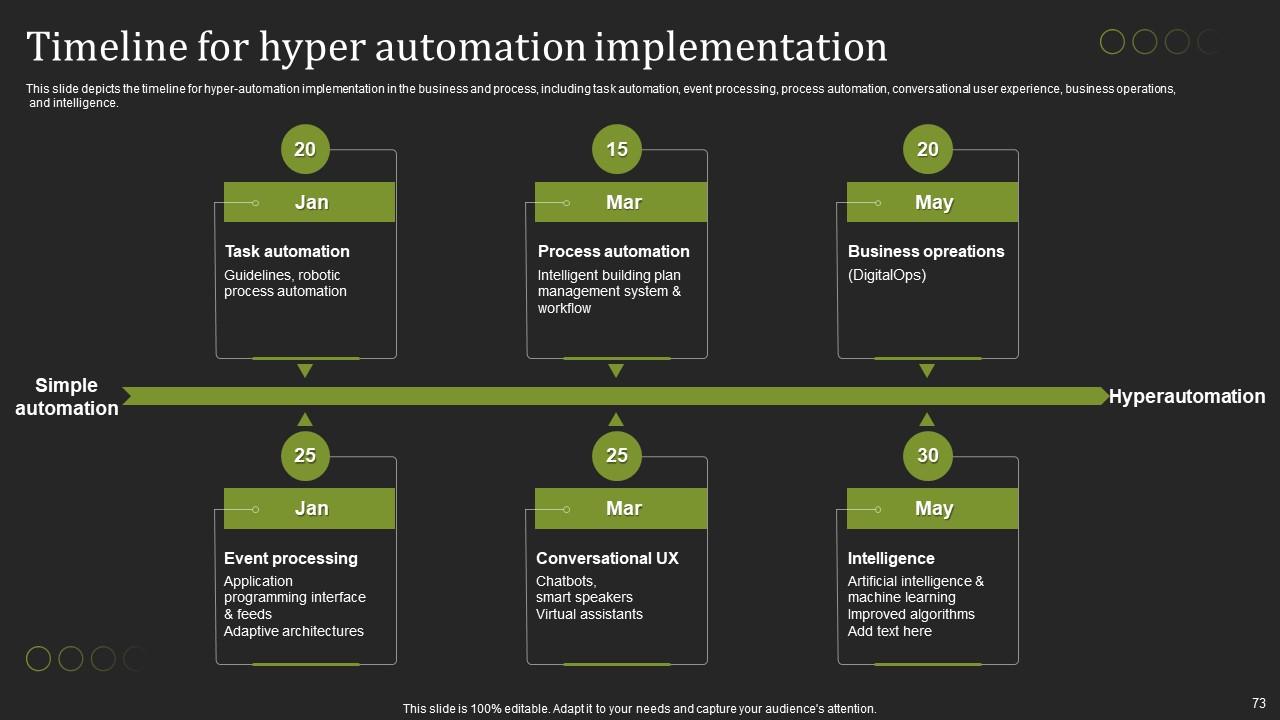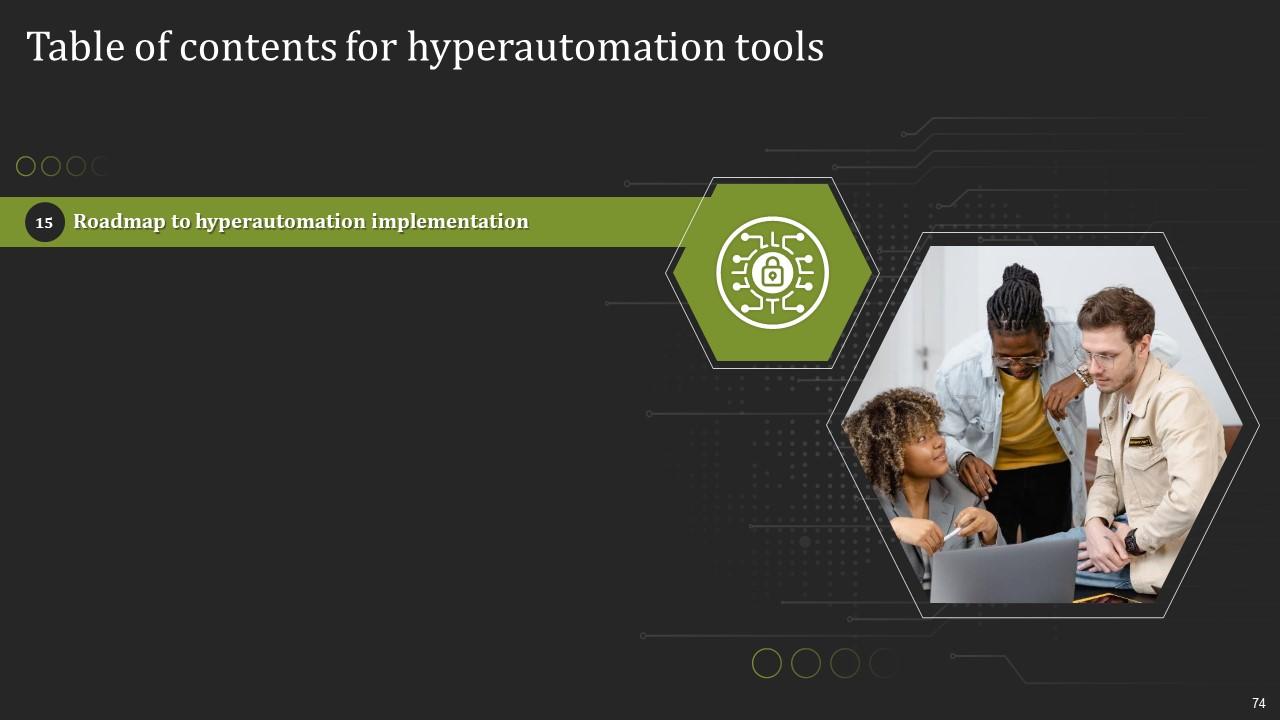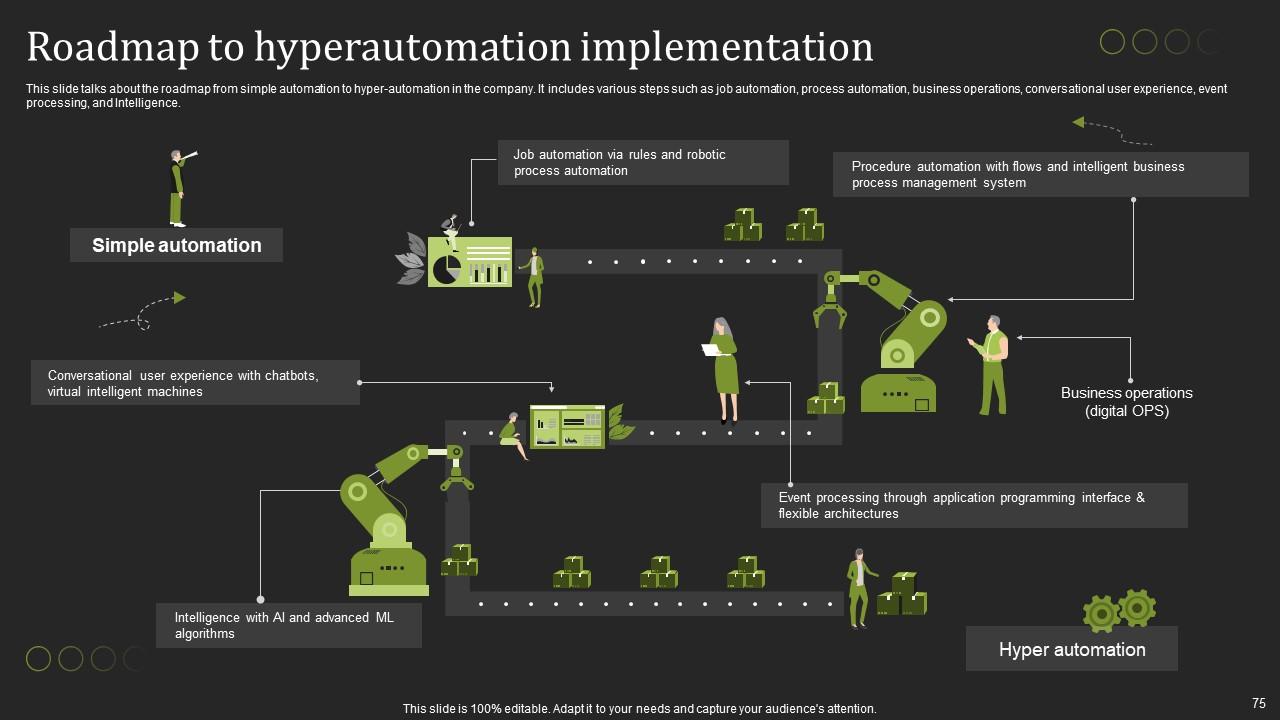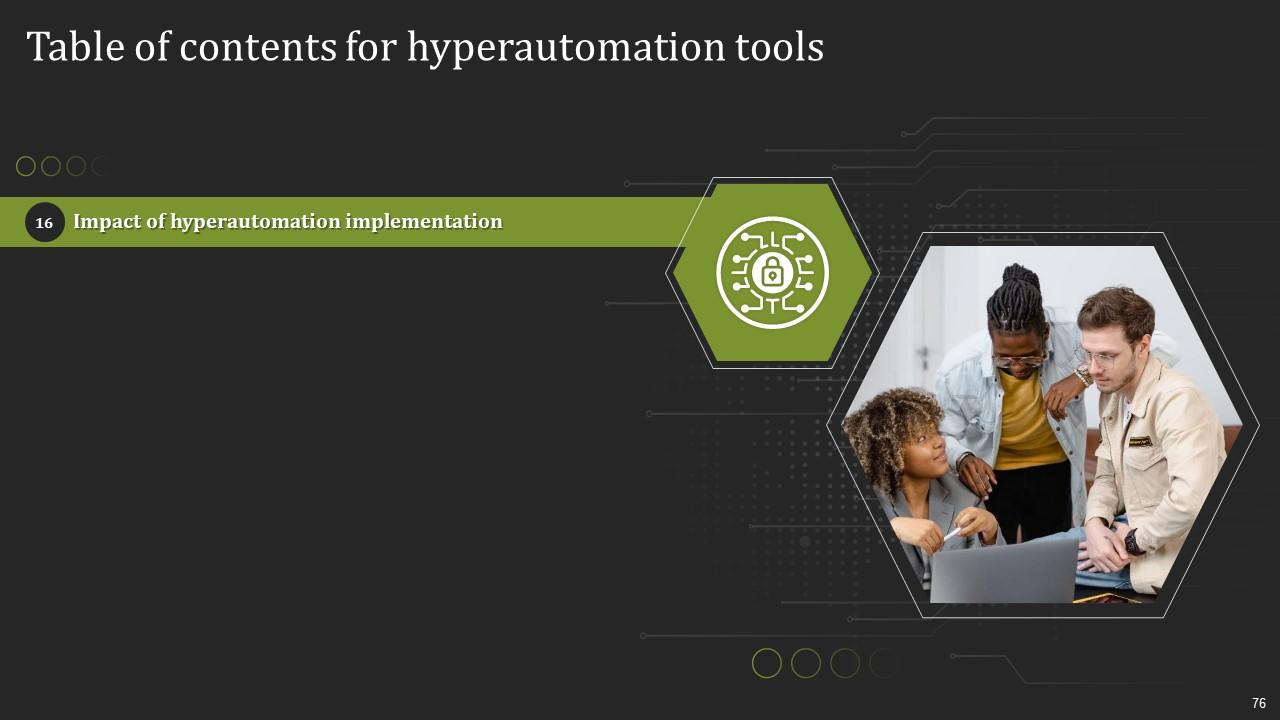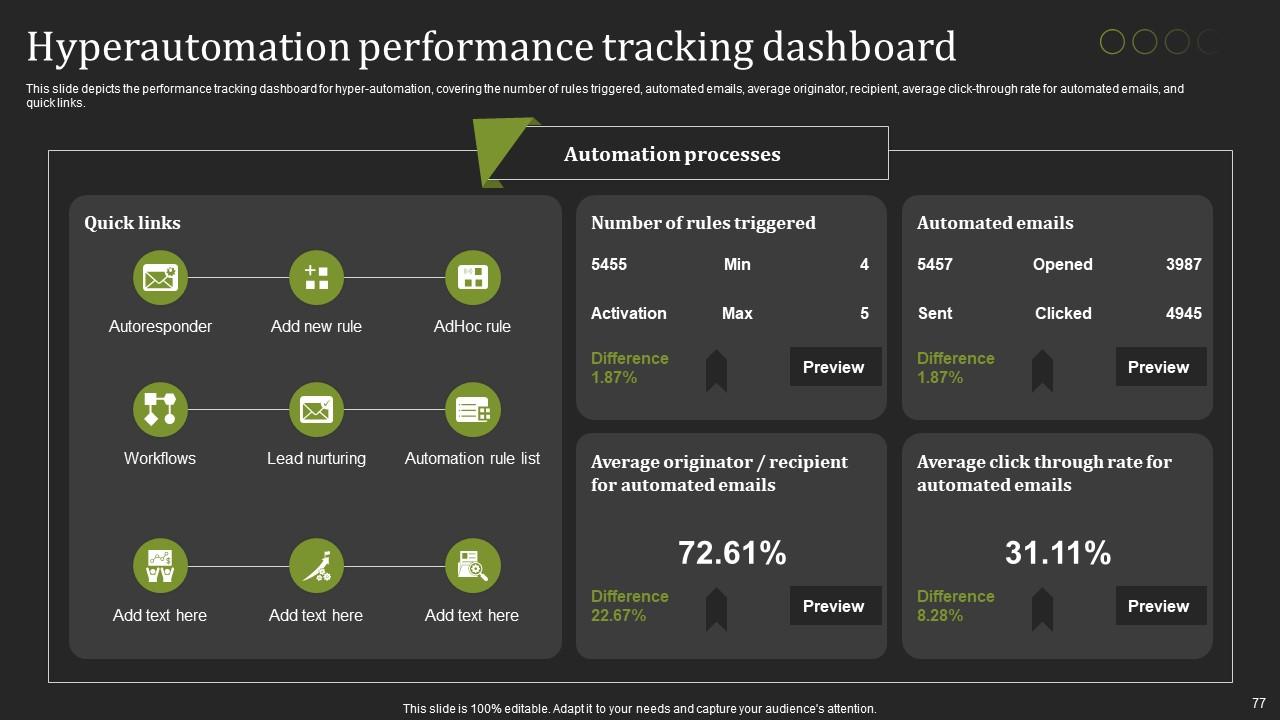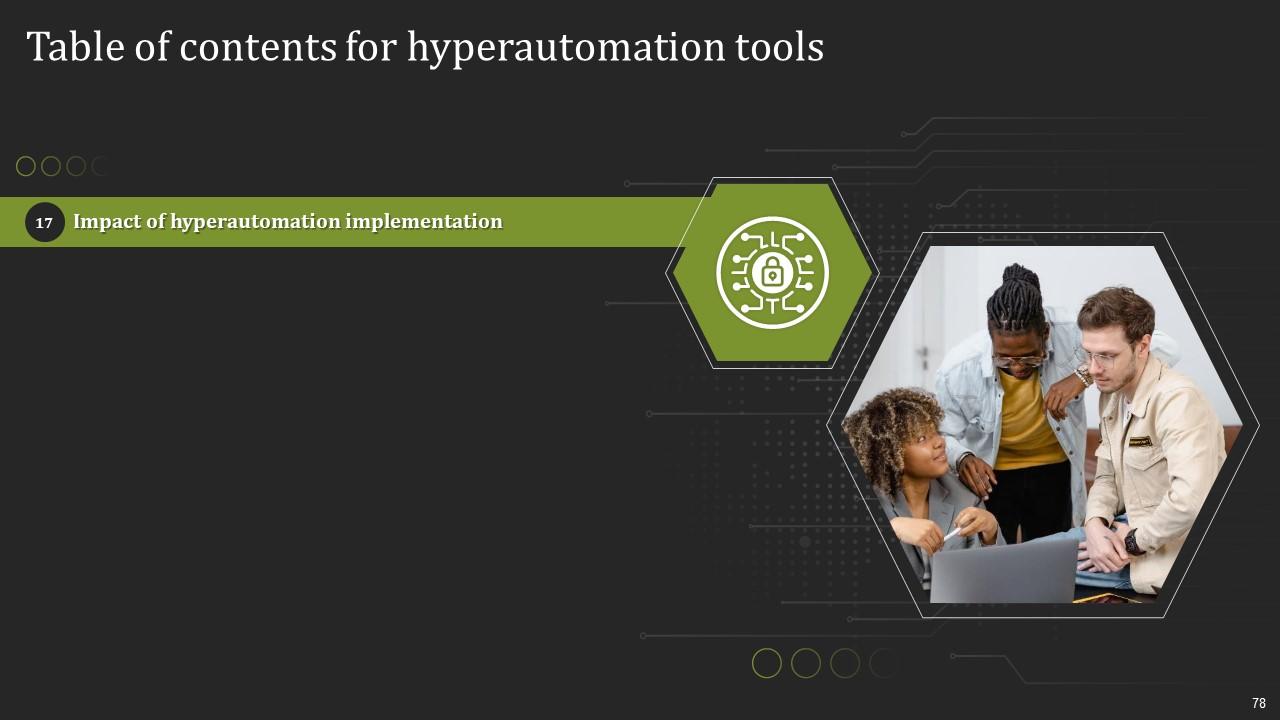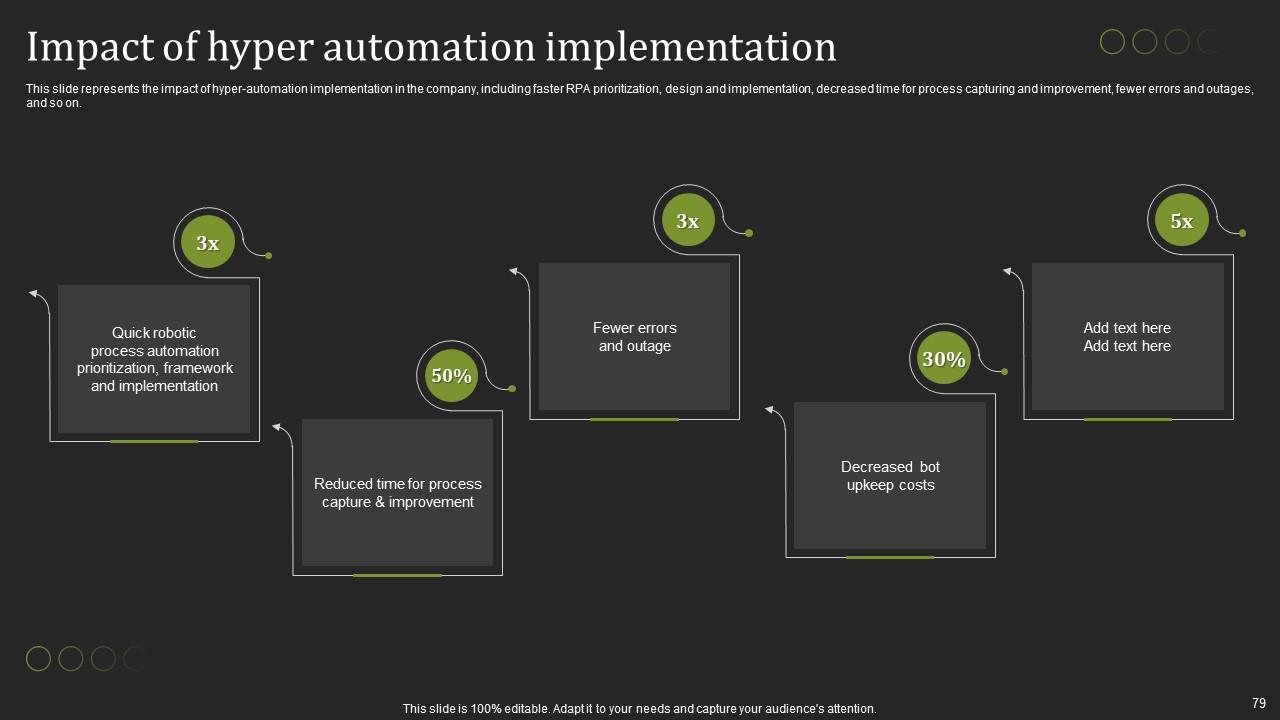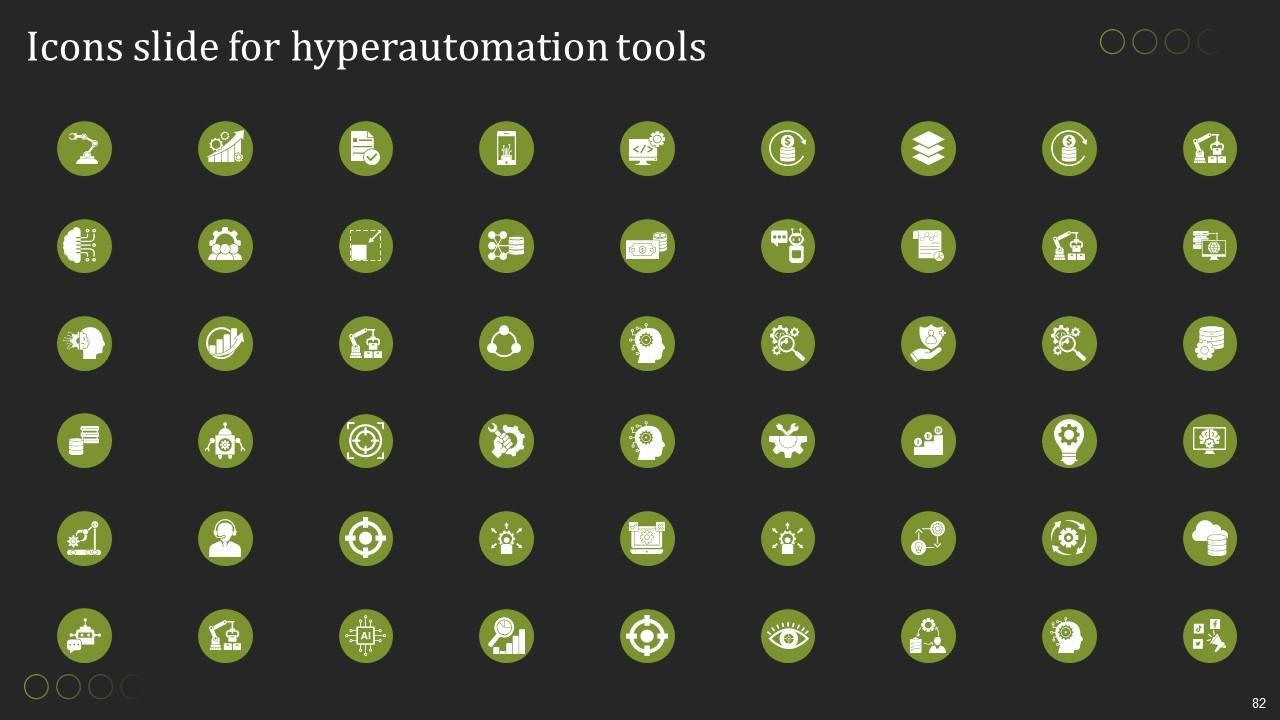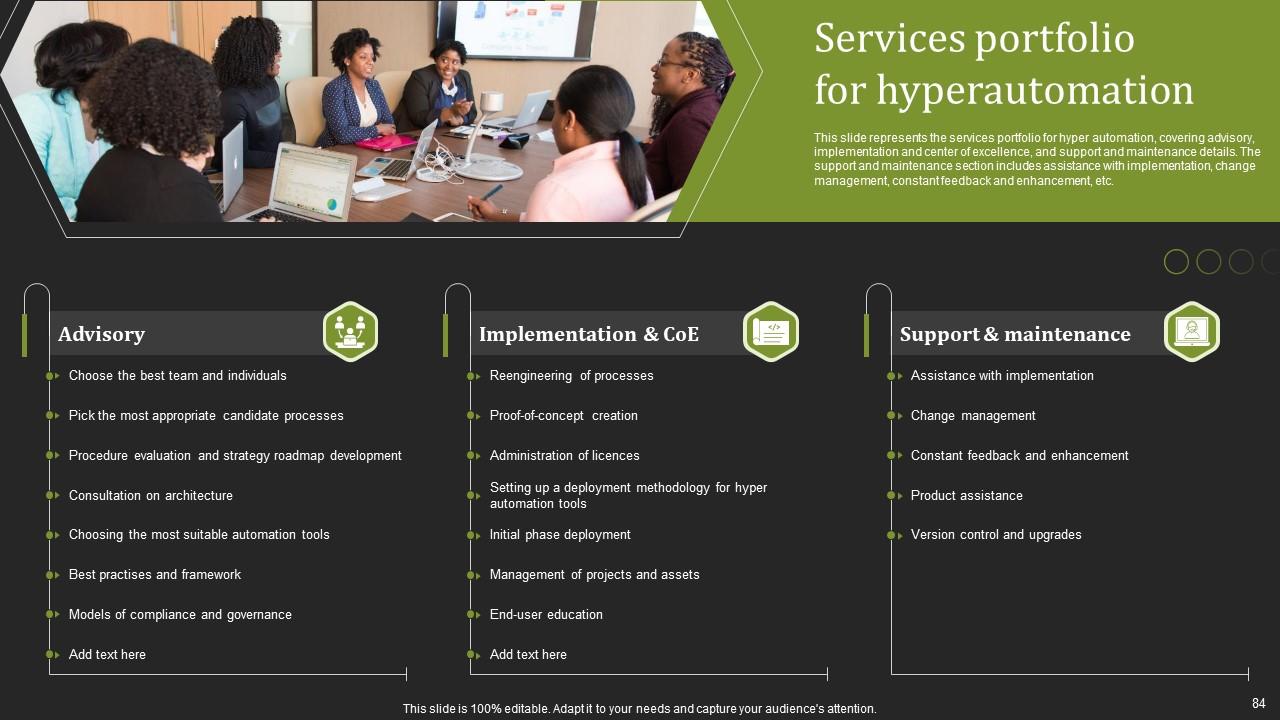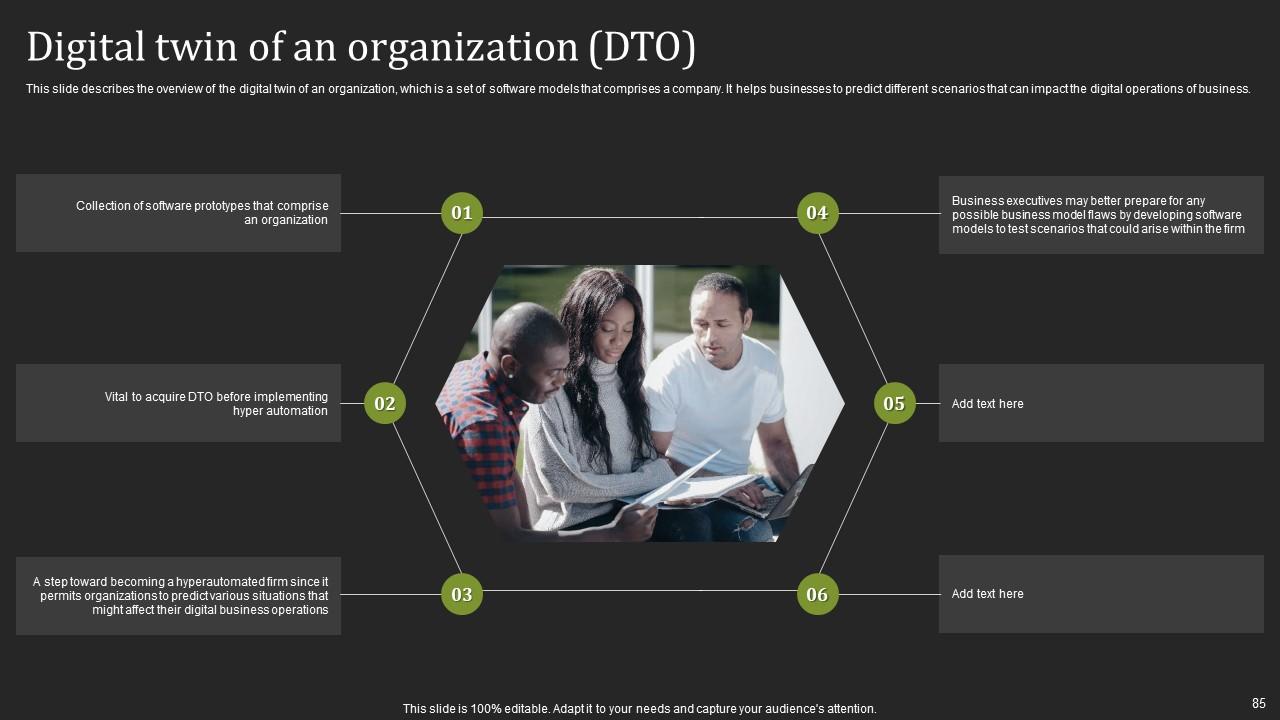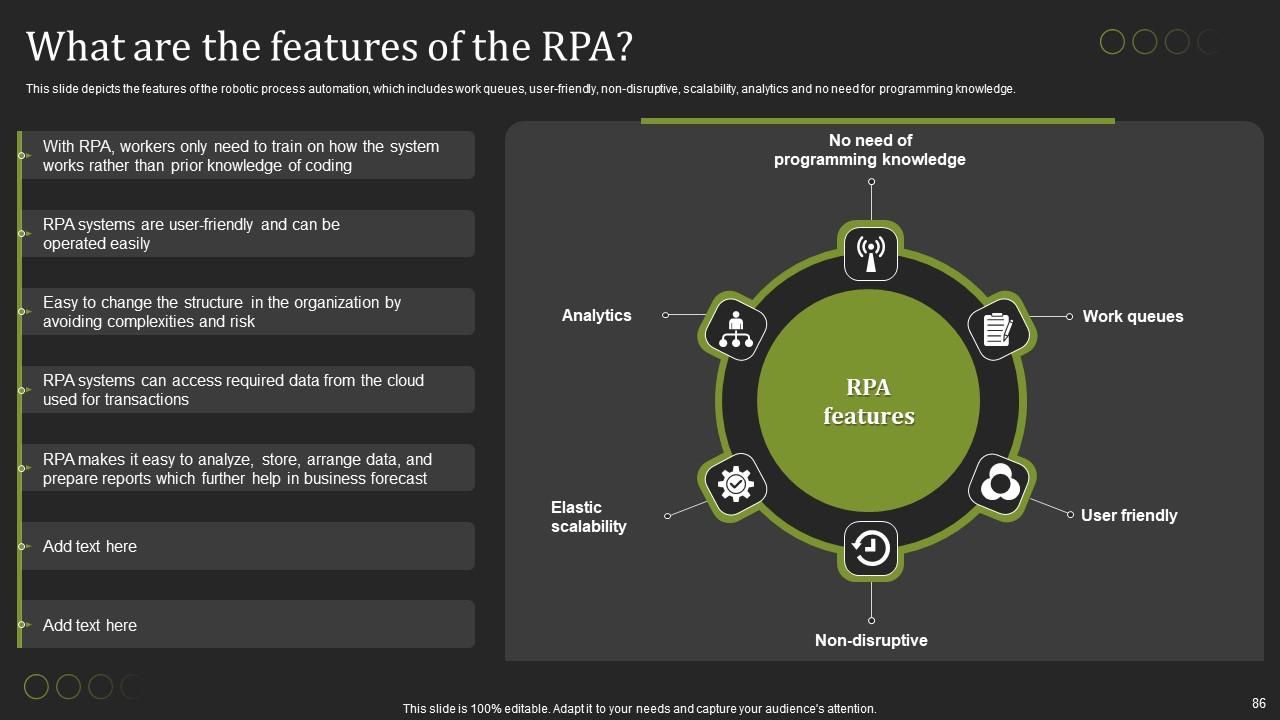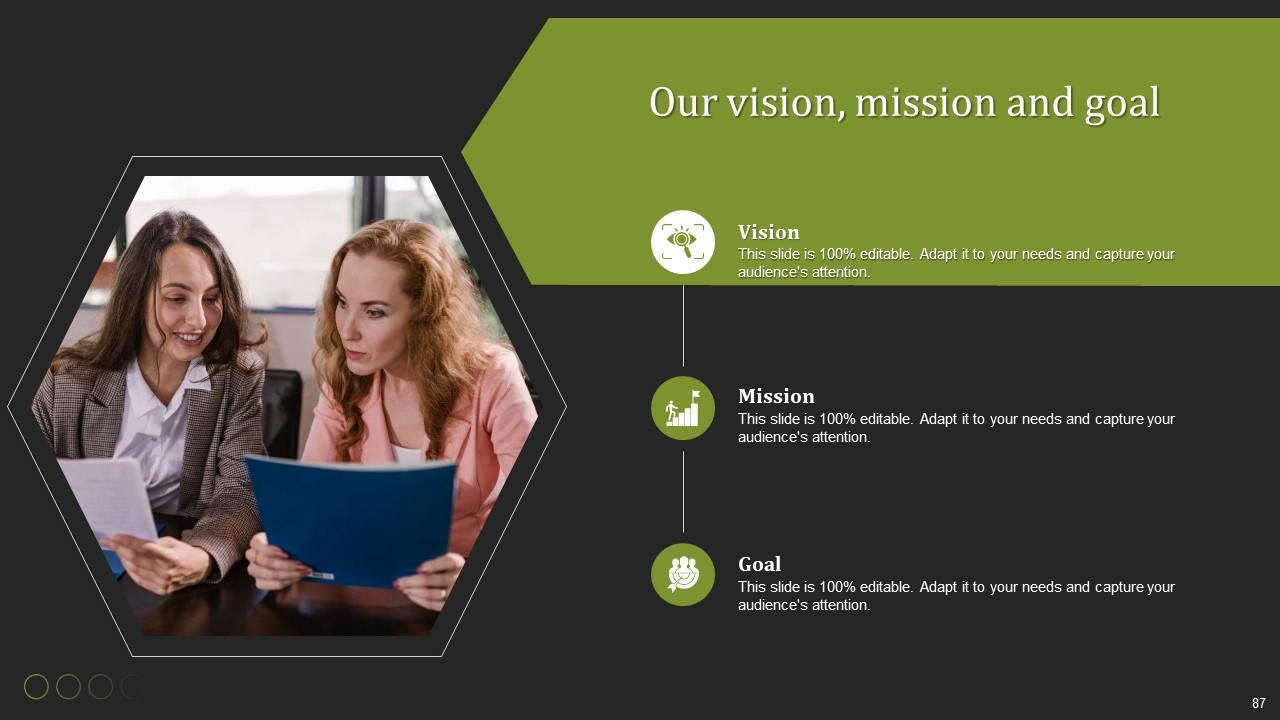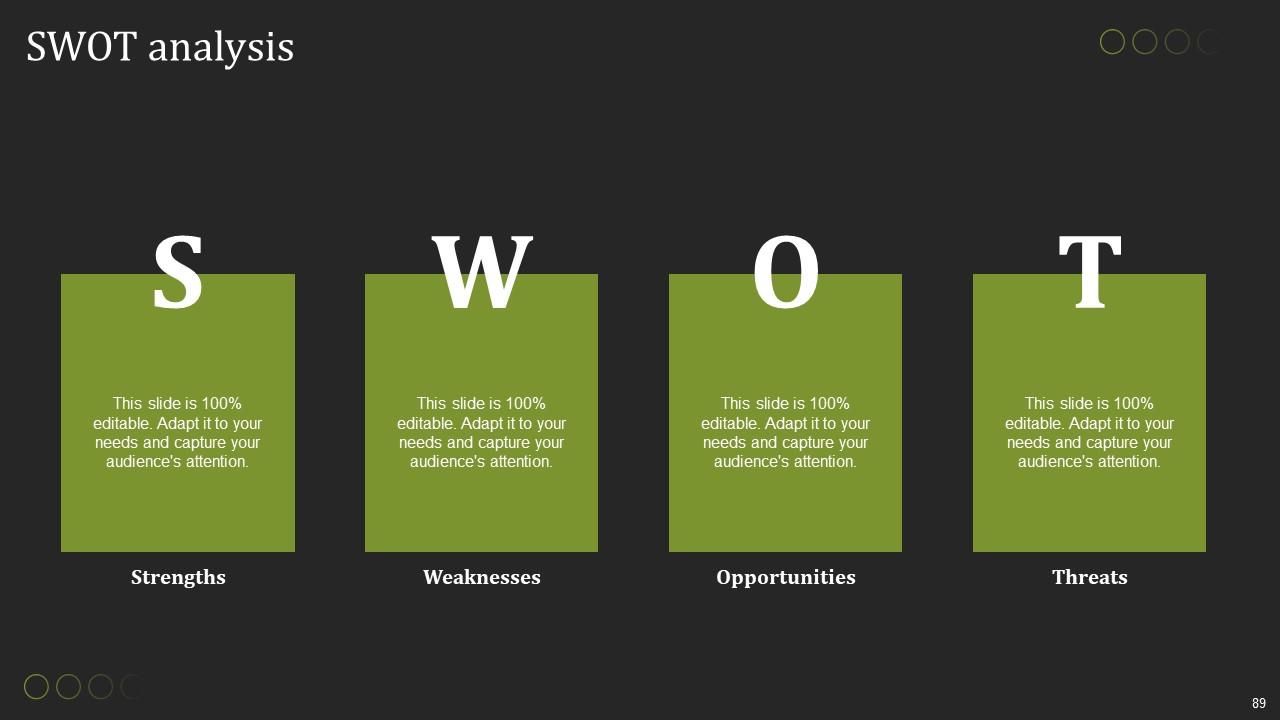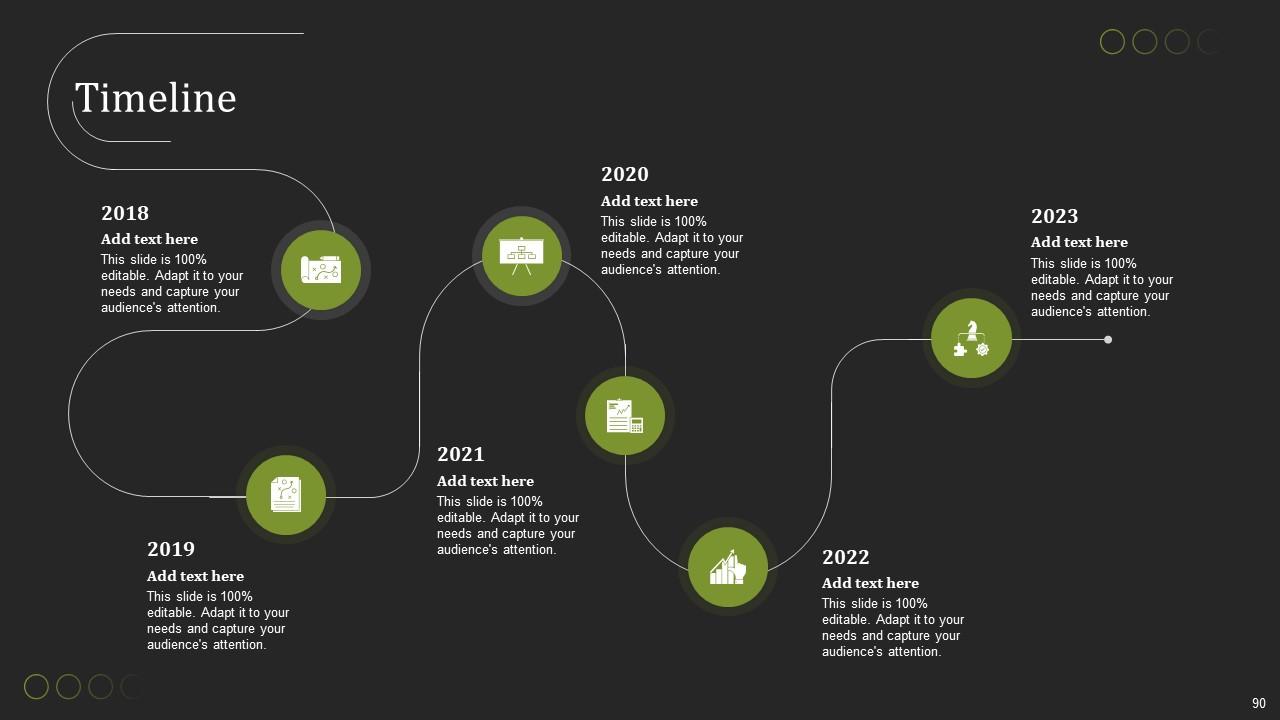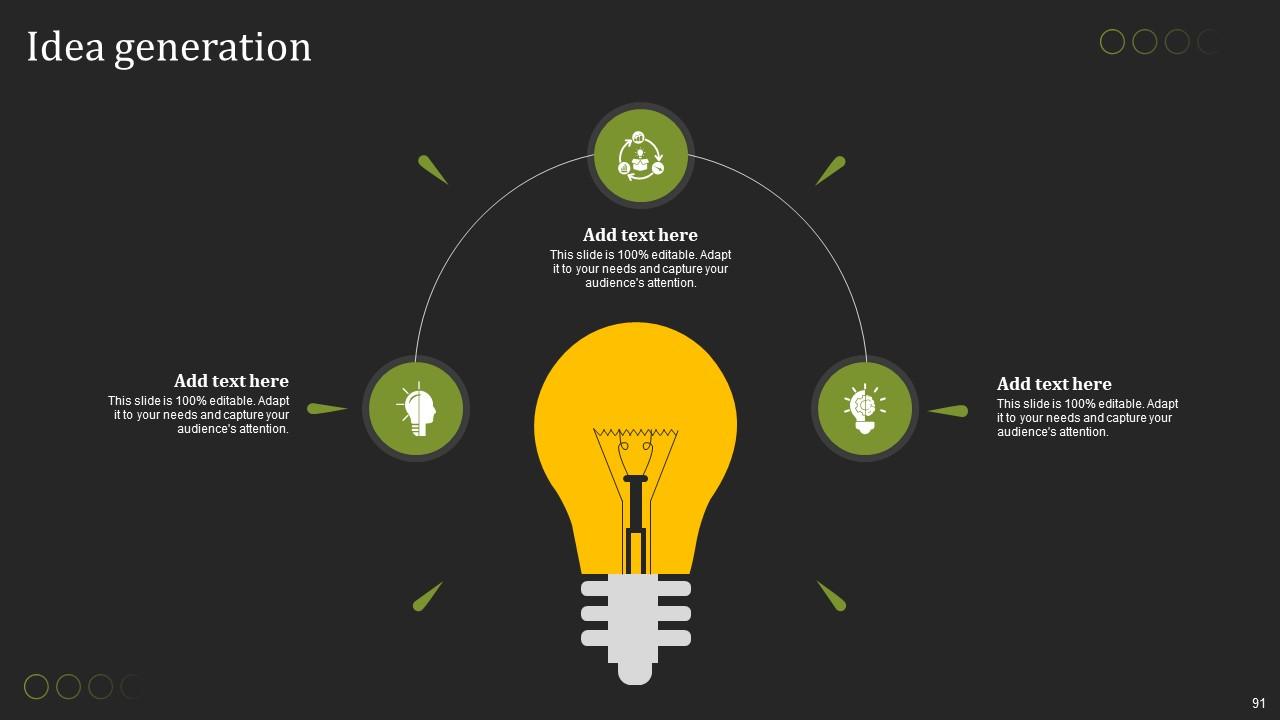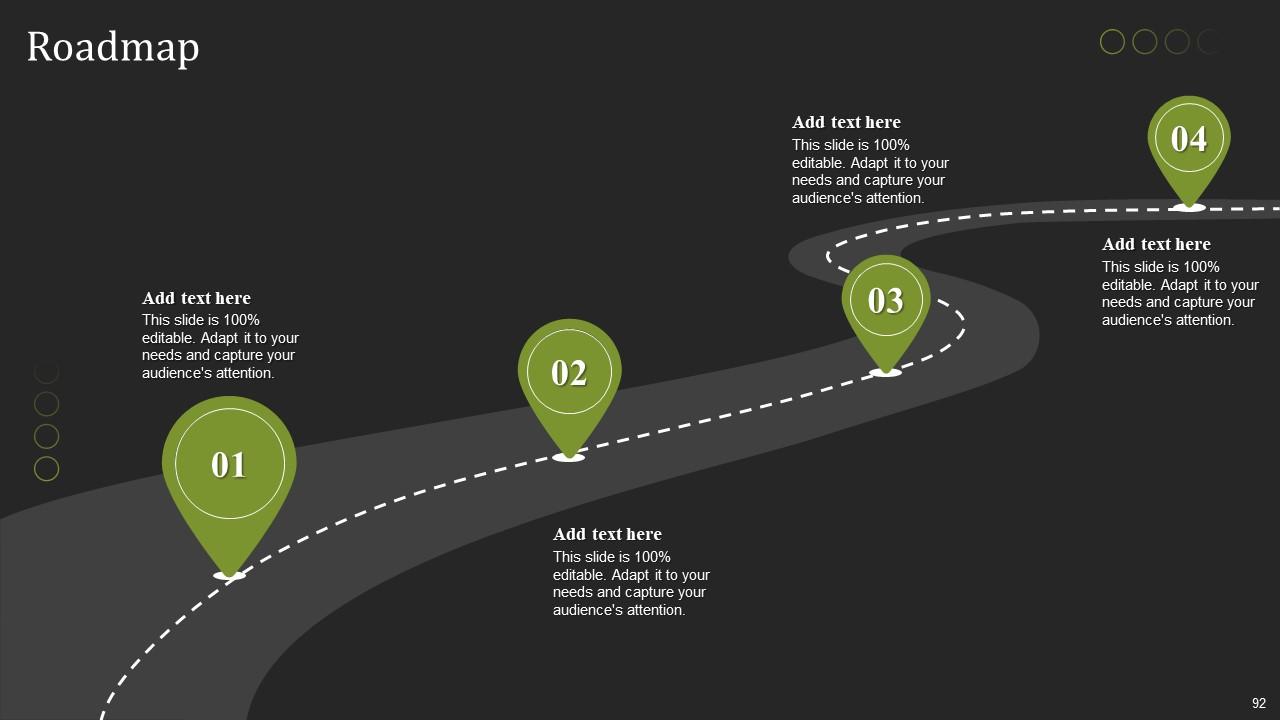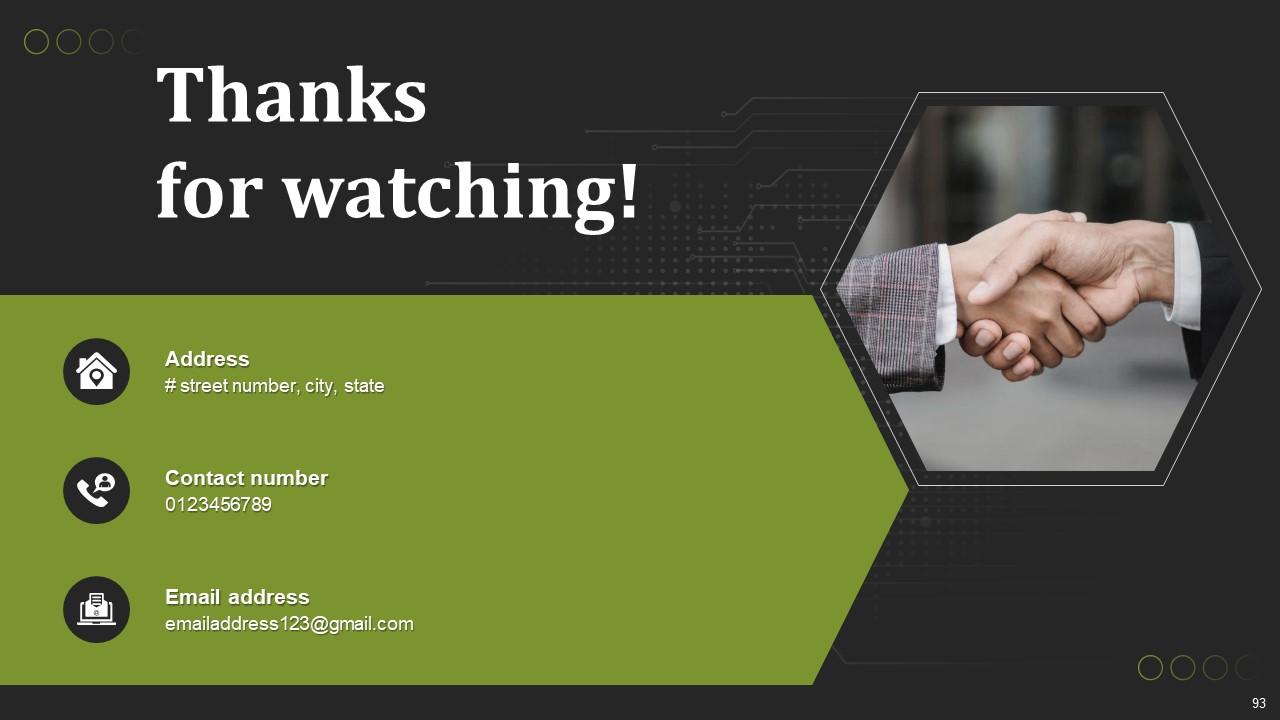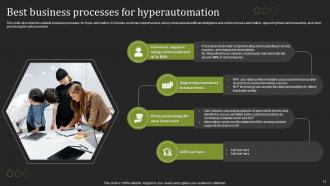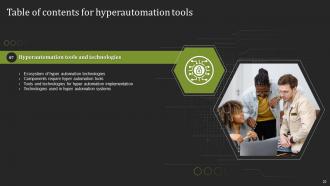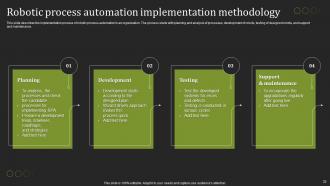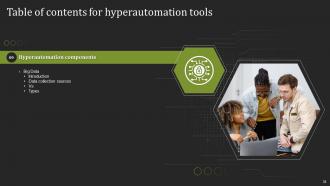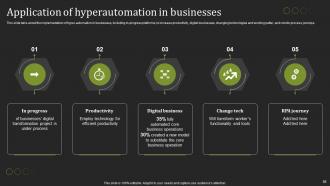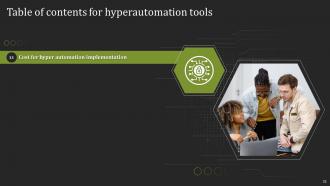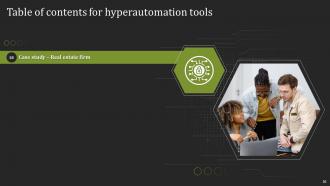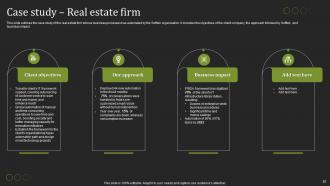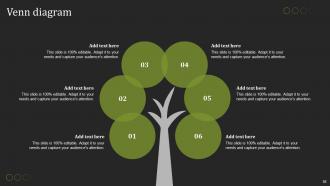Hyperautomation Tools Powerpoint Presentation Slides
Explore the transformative power of Hyper-Automation Technology through our concise and informative Hyperautomation Tools PowerPoint presentation. This presentation provides an overview of hyper-automation, including its components, benefits, and working principles. Firstly, the Hyperautomation Technology PowerPoint deck covers why businesses adopt hyperautomation. Additionally, it offers an end-to-end view of hyper-automation, according to ISG Information Services Group. Furthermore, Hyperautomation Services PPT Template delves into hyper-automation testing, different tools and technologies for implementation, and the top hyper-automation software available. Additionally, our PPT slides explore the performance of hyperautomation in businesses. It offers a checklist, steps to develop an automation plan and platform, implementation guidelines, and common challenges and solutions related to hyper-automation implementation. Moreover, the Hyperautomation Tools PowerPoint presentation showcases real-world applications of hyperautomation across various sectors. Lastly, the Hyperautomation Technology template caters to essential considerations such as cost, timeline, a roadmap for implementation, and a performance tracking dashboard to monitor the effectiveness of hyper-automation initiatives. Download our comprehensive PowerPoint presentation now and unlock the benefits of hyper-automation for your organization.
Explore the transformative power of Hyper-Automation Technology through our concise and informative Hyperautomation Tools P..
- Google Slides is a new FREE Presentation software from Google.
- All our content is 100% compatible with Google Slides.
- Just download our designs, and upload them to Google Slides and they will work automatically.
- Amaze your audience with SlideTeam and Google Slides.
-
Want Changes to This PPT Slide? Check out our Presentation Design Services
- WideScreen Aspect ratio is becoming a very popular format. When you download this product, the downloaded ZIP will contain this product in both standard and widescreen format.
-

- Some older products that we have may only be in standard format, but they can easily be converted to widescreen.
- To do this, please open the SlideTeam product in Powerpoint, and go to
- Design ( On the top bar) -> Page Setup -> and select "On-screen Show (16:9)” in the drop down for "Slides Sized for".
- The slide or theme will change to widescreen, and all graphics will adjust automatically. You can similarly convert our content to any other desired screen aspect ratio.
Compatible With Google Slides

Get This In WideScreen
You must be logged in to download this presentation.
PowerPoint presentation slides
Deliver an informational PPT on various topics by using this Hyperautomation Tools Powerpoint Presentation Slides. This deck focuses and implements best industry practices, thus providing a birds-eye view of the topic. Encompassed with ninty three slides, designed using high-quality visuals and graphics, this deck is a complete package to use and download. All the slides offered in this deck are subjective to innumerable alterations, thus making you a pro at delivering and educating. You can modify the color of the graphics, background, or anything else as per your needs and requirements. It suits every business vertical because of its adaptable layout.
People who downloaded this PowerPoint presentation also viewed the following :
Content of this Powerpoint Presentation
Slide 1: This slide introduces Hyperautomation Tools. State your company name and begin.
Slide 2: This is an Agenda slide. State your agendas here.
Slide 3: This slide shows Table of Content for the presentation.
Slide 4: This slide also shows Table of Content for the presentation.
Slide 5: This slide shows title for topics that are to be covered next in the template.
Slide 6: This slide presents introduction to hyper automation.
Slide 7: This slide depicts the critical components of hyper automation.
Slide 8: This slide provides the advantages of hyper automation.
Slide 9: This slide depicts the working of hyper automation, which is a process-oriented approach.
Slide 10: This is another slide depicting the working of hyper automation, which is a process-oriented approach.
Slide 11: This slide describes the suitable business processes for hyper-automation.
Slide 12: This slide depicts the working of hyper automation, which is a process-oriented approach.
Slide 13: This slide outlines why businesses should invest in hyper-automation.
Slide 14: This slide depicts the working of hyper automation, which is a process-oriented approach.
Slide 15: This slide describes the comparison between automation and hyper automation.
Slide 16: This slide shows title for topics that are to be covered next in the template.
Slide 17: This slide depicts the comparison between robotic process automation and hyper-automation based on key areas.
Slide 18: This slide shows title for topics that are to be covered next in the template.
Slide 19: This slide presents the end-to-end view of hyper-automation as per information services group organization.
Slide 20: This slide shows title for topics that are to be covered next in the template.
Slide 21: This slide depicts the overview of hyper-automation testing that consists of three components.
Slide 22: This slide shows title for topics that are to be covered next in the template.
Slide 23: This slide presents the ecosystem of hyper automation technologies.
Slide 24: This slide describes the components that require tools for hyper-automation implementation and it caters to process.
Slide 25: This slide depicts the tools used for hyper automation implementation in an organization.
Slide 26: This slide presents the technologies used in hyper-automation systems.
Slide 27: This slide shows title for topics that are to be covered next in the template.
Slide 28: This slide represents the top hyper-automation software solutions.
Slide 29: This slide shows title for topics that are to be covered next in the template.
Slide 30: This slide depicts the overview of robotic process automation systems that mimic human digital operations.
Slide 31: This slide describes the benefits of robotic process automation systems to organizations.
Slide 32: This slide presents the life cycle of a robotic process automation system.
Slide 33: This slide describes the implementation process of robotic process automation in an organization.
Slide 34: This slide shows title for topics that are to be covered next in the template.
Slide 35: This slide presents the introduction of big data analytics.
Slide 36: This slide presents top big data collection sources for developing improved marketing strategies.
Slide 37: This slide describes the most critical Vs of big data analytics.
Slide 38: This slide depicts the three types of big data.
Slide 39: This slide shows title for topics that are to be covered next in the template.
Slide 40: This slide presents an overview of cobots, also known as collaborative robots.
Slide 41: This slide describes the benefits of using cobots in business.
Slide 42: This slide presents the risk and safety factors associated with cobots so humans can work with them without harm.
Slide 43: This slide describes the four major types of collaborative robots.
Slide 44: This slide shows title for topics that are to be covered next in the template.
Slide 45: This slide depicts the artificial intelligence overview.
Slide 46: This slide outlines the primary types of artificial intelligence technology.
Slide 47: This slide depicts the real-world applications of artificial intelligence.
Slide 48: This slide shows title for topics that are to be covered next in the template.
Slide 49: This slide describes the overview of machine learning technology.
Slide 50: This slide depicts the implementation classification categories of machine learning.
Slide 51: This slide presents the working of machine learning systems.
Slide 52: This slide contains the applications of machine learning algorithms in different areas.
Slide 53: This slide shows title for topics that are to be covered next in the template.
Slide 54: This slide presents the checklist to obtain effective hyper automation.
Slide 55: This slide describes the steps to get started with hyper-automation.
Slide 56: This slide presents the process of developing an effective hyper-automation plan for an organization.
Slide 57: This slide depicts the typical three steps involved in a hyper automation platform.
Slide 58: This slide presents the steps to be taken for hyper-automation implementation in the company.
Slide 59: This slide describes the implementation framework for hyper automation in an organization.
Slide 60: This slide depicts the steps to power the hyper-automation system.
Slide 61: This slide shows title for topics that are to be covered next in the template.
Slide 62: This slide describes the common challenges of hyper automation implementation.
Slide 63: This slide shows title for topics that are to be covered next in the template.
Slide 64: This slide describes the use of hyper automation in the healthcare industry.
Slide 65: This slide presents the application of hyper automation in the banking and finance sector.
Slide 66: This slide describes the use of hyper automation in the retail sector.
Slide 67: This slide presents the application of hyper automation in the supply chain industry.
Slide 68: This slide describes the implementation of hyper-automation in businesses.
Slide 69: This slide depicts the use cases of hyperautomation in different industries.
Slide 70: This slide shows title for topics that are to be covered next in the template.
Slide 71: This slide outlines the pricing for hyper-automation implementation.
Slide 72: This slide shows title for topics that are to be covered next in the template.
Slide 73: This slide depicts the timeline for hyper-automation implementation in the business and process.
Slide 74: This slide shows title for topics that are to be covered next in the template.
Slide 75: This slide displays the roadmap from simple automation to hyper-automation in the company.
Slide 76: This slide shows title for topics that are to be covered next in the template.
Slide 77: This slide presents the performance tracking dashboard for hyper-automation.
Slide 78: This slide shows title for topics that are to be covered next in the template.
Slide 79: This slide presents the impact of hyper-automation implementation in the company.
Slide 80: This slide shows title for topics that are to be covered next in the template.
Slide 81: This slide outlines the case study of the real estate firm whose business processes has automated by the Softtek organization.
Slide 82: This slide shows all the icons included in the presentation.
Slide 83: This slide is titled as Additional Slides for moving forward.
Slide 84: This slide represents the services portfolio for hyper automation.
Slide 85: This slide describes the overview of the digital twin of an organization.
Slide 86: This slide presents the features of the robotic process automation.
Slide 87: This is Our Vision, Mission & Goal slide.
Slide 88: This slide depicts Venn diagram with text boxes.
Slide 89: This slide shows SWOT analysis describing- Strength, Weakness, Opportunity, and Threat.
Slide 90: This is a Timeline slide. Show data related to time intervals here.
Slide 91: This is an Idea Generation slide to state a new idea or highlight information, specifications etc.
Slide 92: This slide presents Roadmap with additional textboxes.
Slide 93: This is a Thank You slide with address, contact numbers and email address.
Hyperautomation Tools Powerpoint Presentation Slides with all 98 slides:
Use our Hyperautomation Tools Powerpoint Presentation Slides to effectively help you save your valuable time. They are readymade to fit into any presentation structure.
FAQs
Hyper automation is an approach that combines advanced technologies like artificial intelligence, machine learning, and robotic process automation to automate and optimize business processes. It is important because it enables organizations to streamline operations, improve efficiency, and enhance productivity by automating complex tasks and decision-making processes.
The critical components of hyper-automation include artificial intelligence, machine learning algorithms, Robotic Process Automation (RPA), Natural Language Processing (NLP), process mining, and data analytics. These components work together to automate and optimize various aspects of business processes.
Hyper automation offers several advantages, including increased productivity, improved accuracy and quality, reduced operational costs, faster processing times, enhanced customer experiences, better decision-making through data-driven insights, and the ability to scale operations efficiently.
Hyper automation follows a process-oriented approach, where it leverages technologies like artificial intelligence, machine learning, and RPA to automate and optimize different stages of a business process. It involves analyzing, mapping, and redesigning processes, identifying automation opportunities, deploying automation technologies, and continuously monitoring and optimizing the automated processes.
Hyper automation can be applied to various business processes across industries. Some suitable processes include data entry and data processing, customer service and support, invoice and payment processing, supply chain management, HR processes like employee onboarding and payroll management, and repetitive tasks that involve manual intervention and decision-making.
-
A library of engaging, customizable and content-ready templates.
-
Easily Editable.


